-

Win a Free Custom Engraved Brass Coin!!!
As a way to introduce our brass coins to the community, we will raffle off a free coin during the month of August. Follow link ABOVE for instructions for entering.
You are using an out of date browser. It may not display this or other websites correctly.
You should upgrade or use an alternative browser.
You should upgrade or use an alternative browser.
Naval/Maritime History 27th of August - Today in Naval History - Naval / Maritime Events in History
The ZHL Ingermanland was much older than this one!Ingermanland did sank near from where I live, I think the lifeboat is in a museum here in the district.
I'll try to track it up and take pictures to show here at SOS.
If I'm not completely wrong then the ZHL has a kit of this boat.
Today in Naval History - Naval / Maritime Events in History
27 May 1770 – Battle of Nauplia (1770) or sometimes named Action of Nafplio
May 27 and 28 - Russians vs Turks near southern Greece
Fought during the Russo-Turkish War, 1768-1774, this indecisive battle took place on 27 and 28 May 1770 at the entrance to the Argolic Gulf, Greece, when a Russian fleet under John Elphinstone engaged a larger Ottoman fleet. No ships were lost on either side, and casualties were small.
History
Elphinston had arrived at Cape Matapan, southern Greece, on 20 May 1770 from Portsmouth and landed his troops on 22 May at Rupino. Hearing that the Ottoman fleet was divided in two, he decided to attack. After battling bad weather, he sighted the Ottoman ships on 27 May at the entrance to the gulf and despite the superior numbers of the Ottomans (about 10 battleships and some smaller vessels vs 3 battleships, 2 frigates and 4 armed merchantmen) he sailed up before a light SSE breeze to attack. Soon after 5pm Ne tron menya attacked the Ottoman flagship, and then Saratov attacked the Ottoman Vice- and Rear Admiral's ships. Nadezhda was also in action. Elphinston, in Svyatoslav, had to chase and fire on the armed merchantmen to get them to fight, but when he did attack the Ottoman fleet retreated, using their galleys to tow their battleships north. The Russians used their boats to do the same.
On 28 May, soon after 12pm the Ottoman fleet anchored in line under the guns of the Nauplia batteries. At about 3pm Elphinston attacked, standing up and down the Ottoman line, but with little effect. Russian casualties were low.
On 30 May, the Ottomans began to move, and some Russian captains insisted that they were not bound to attack such a superior fleet. Elphinston had to give in, and during the evening of 31 May as the Ottomans steadily approached, being towed again by their galleys, the wind rose and the Russians got away.
Ships involved
Russia (Elphinston
Svyatoslav 80 (flag)
Ne tron menya 66
Saratov 66
Afrika 32
Nadezhda 32
Graf Tchernyshev 22 (hired British merchantman)
Graf Panin 18 (hired British merchantman)
Graf Orlov 18 (hired British merchantman)
Sv. Pavel 8
Ottoman Empire
(details uncertain)
? 84 (flag)
4 other 84-gun battleships
2 64-gun battleships
4 54-gun battleships
2 50-gun battleships
 en.wikipedia.org
https://threedecks.org/index.php?display_type=show_battle&id=636
en.wikipedia.org
https://threedecks.org/index.php?display_type=show_battle&id=636
27 May 1770 – Battle of Nauplia (1770) or sometimes named Action of Nafplio
May 27 and 28 - Russians vs Turks near southern Greece
Fought during the Russo-Turkish War, 1768-1774, this indecisive battle took place on 27 and 28 May 1770 at the entrance to the Argolic Gulf, Greece, when a Russian fleet under John Elphinstone engaged a larger Ottoman fleet. No ships were lost on either side, and casualties were small.
History
Elphinston had arrived at Cape Matapan, southern Greece, on 20 May 1770 from Portsmouth and landed his troops on 22 May at Rupino. Hearing that the Ottoman fleet was divided in two, he decided to attack. After battling bad weather, he sighted the Ottoman ships on 27 May at the entrance to the gulf and despite the superior numbers of the Ottomans (about 10 battleships and some smaller vessels vs 3 battleships, 2 frigates and 4 armed merchantmen) he sailed up before a light SSE breeze to attack. Soon after 5pm Ne tron menya attacked the Ottoman flagship, and then Saratov attacked the Ottoman Vice- and Rear Admiral's ships. Nadezhda was also in action. Elphinston, in Svyatoslav, had to chase and fire on the armed merchantmen to get them to fight, but when he did attack the Ottoman fleet retreated, using their galleys to tow their battleships north. The Russians used their boats to do the same.
On 28 May, soon after 12pm the Ottoman fleet anchored in line under the guns of the Nauplia batteries. At about 3pm Elphinston attacked, standing up and down the Ottoman line, but with little effect. Russian casualties were low.
On 30 May, the Ottomans began to move, and some Russian captains insisted that they were not bound to attack such a superior fleet. Elphinston had to give in, and during the evening of 31 May as the Ottomans steadily approached, being towed again by their galleys, the wind rose and the Russians got away.
Ships involved
Russia (Elphinston
Svyatoslav 80 (flag)
Ne tron menya 66
Saratov 66
Afrika 32
Nadezhda 32
Graf Tchernyshev 22 (hired British merchantman)
Graf Panin 18 (hired British merchantman)
Graf Orlov 18 (hired British merchantman)
Sv. Pavel 8
Ottoman Empire
(details uncertain)
? 84 (flag)
4 other 84-gun battleships
2 64-gun battleships
4 54-gun battleships
2 50-gun battleships
Battle of Nauplia (1770) - Wikipedia
Today in Naval History - Naval / Maritime Events in History
27 May 1774 – Launch of HMS Hector, a 74-gun third rate ship of the line of the Royal Navy, at Deptford.
HMS Hector was a 74-gun third rate ship of the line of the Royal Navy, launched on 27 May 1774 at Deptford.
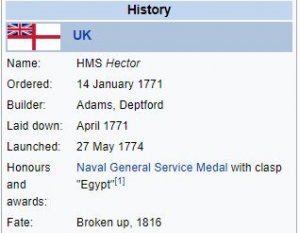
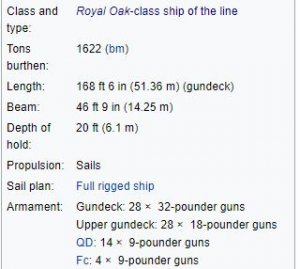
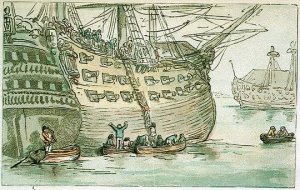
Going aboard Hector in 1891
Career
On 9 May 1801 Hector, Kent, and Cruelle unsuccessfully chased the French corvette Heliopolis, which eluded them and slipped into Alexandria.
Because Hector served in the navy's Egyptian campaign (8 March to 8 September 1801), her officers and crew qualified for the clasp "Egypt" to the Naval General Service Medal that the Admiralty authorised in 1850 for all surviving claimants.
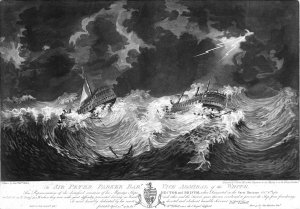
HMS Hector and Bristol in distress during the Great Hurricane of 1780
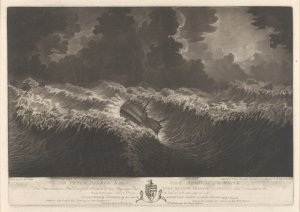
Representation of the Distressed Situation of His Majesty's Ships Ruby, Hector, Berwick and Bristol when Dismasted in the Great Hurricane October 6th 1780 (PAH0733)

Scale: 1:48. Plan showing the body plan with stern board outline, sheer lines, and modified longitudinal half-breadth proposed (and approved) for 'Royal Oak' (1810), and later for 'Hector' (1774), 'Sultan' (1775), and 'Vengeance' (1774), all 74-gun Third Rate, two-deckers
Fate
Hector was converted for use as a prison ship in 1808, and was broken up in 1816.

The Royal Oak-class ships of the line were a class of six 74-gun third rates, designed for the Royal Navy by Sir John Williams. The Alfred class were an enlarged version of the Royal Oak class.
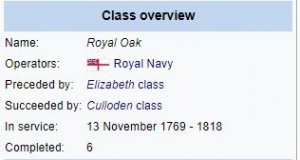
Ships
Builder: Plymouth Dockyard
Ordered: 16 November 1765
Launched: 13 November 1769
Fate: Broken up, 1815
Builder: Plymouth Dockyard
Ordered: 12 October 1768
Laid Down: October 1769
Launched: 18 October 1773
Completed for Sea: 12 July 1777
Fate: Broken up, November 1794
Builder: Woolwich Dockyard
Ordered: 12 October 1768
Launched: 27 October 1775
Fate: Broken up, 1817
Builder: Adams, Deptford
Ordered: 14 January 1771
Launched: 27 May 1774
Fate: Broken up, 1816
Builder: Randall, Rotherhithe
Ordered: 14 January 1771
Launched: 25 June 1774
Fate: Broken up, 1816
Builder: Barnard, Harwich
Ordered: 14 January 1771
Launched: 23 December 1775
Fate: Broken up, 1816
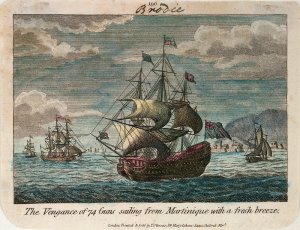
HMS Vengeance
https://en.wikipedia.org/wiki/HMS_Hector_(1774)
https://en.wikipedia.org/wiki/Royal_Oak-class_ship_of_the_line
27 May 1774 – Launch of HMS Hector, a 74-gun third rate ship of the line of the Royal Navy, at Deptford.
HMS Hector was a 74-gun third rate ship of the line of the Royal Navy, launched on 27 May 1774 at Deptford.



Going aboard Hector in 1891
Career
On 9 May 1801 Hector, Kent, and Cruelle unsuccessfully chased the French corvette Heliopolis, which eluded them and slipped into Alexandria.
Because Hector served in the navy's Egyptian campaign (8 March to 8 September 1801), her officers and crew qualified for the clasp "Egypt" to the Naval General Service Medal that the Admiralty authorised in 1850 for all surviving claimants.

HMS Hector and Bristol in distress during the Great Hurricane of 1780

Representation of the Distressed Situation of His Majesty's Ships Ruby, Hector, Berwick and Bristol when Dismasted in the Great Hurricane October 6th 1780 (PAH0733)

Scale: 1:48. Plan showing the body plan with stern board outline, sheer lines, and modified longitudinal half-breadth proposed (and approved) for 'Royal Oak' (1810), and later for 'Hector' (1774), 'Sultan' (1775), and 'Vengeance' (1774), all 74-gun Third Rate, two-deckers
Fate
Hector was converted for use as a prison ship in 1808, and was broken up in 1816.

| Scale: 1:48. Plan showing the body plan with stern board decoration, sheer lines with inboard detail and figurehead, and longitudinal half-breadth for 'Hector' (1774), a 74-gun Third Rate, two-decker. The plan may represent her as built |
The Royal Oak-class ships of the line were a class of six 74-gun third rates, designed for the Royal Navy by Sir John Williams. The Alfred class were an enlarged version of the Royal Oak class.

Ships
Builder: Plymouth Dockyard
Ordered: 16 November 1765
Launched: 13 November 1769
Fate: Broken up, 1815
Builder: Plymouth Dockyard
Ordered: 12 October 1768
Laid Down: October 1769
Launched: 18 October 1773
Completed for Sea: 12 July 1777
Fate: Broken up, November 1794
Builder: Woolwich Dockyard
Ordered: 12 October 1768
Launched: 27 October 1775
Fate: Broken up, 1817
Builder: Adams, Deptford
Ordered: 14 January 1771
Launched: 27 May 1774
Fate: Broken up, 1816
Builder: Randall, Rotherhithe
Ordered: 14 January 1771
Launched: 25 June 1774
Fate: Broken up, 1816
Builder: Barnard, Harwich
Ordered: 14 January 1771
Launched: 23 December 1775
Fate: Broken up, 1816

HMS Vengeance
https://en.wikipedia.org/wiki/HMS_Hector_(1774)
https://en.wikipedia.org/wiki/Royal_Oak-class_ship_of_the_line
Today in Naval History - Naval / Maritime Events in History
27 May 1778 – Launch of HMS Nymph, a 14-gun Swan-class sloop of the Royal Navy launched at Chatham Dockyard
HMS Nymph was a 14-gun Swan-class sloop of the Royal Navy launched at Chatham Dockyard on 27 May 1778. She was accidentally burnt and sank in the British Virgin Islands in 1783.
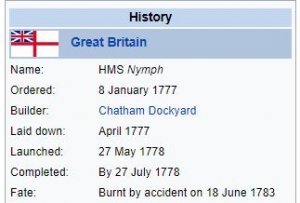
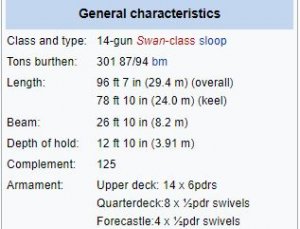
Construction and commissioning
Nymph was ordered from Chatham Dockyard on 8 January 1777 and laid down there in April that year under master shipwright Israel Pownoll. She was launched on 27 May 1778 and completed by 27 July 1778. She cost a total of £8,640.13.4d to build, including money spent on fitting and coppering her. She was later fitted to carry 16 6 pounder guns by Admiralty orders of 1779 and 1780.
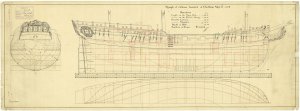
Scale: 1:48. Plan showing the body plan with stern board decoration, sheer lines with inboard detail and quarter gallery decoration and figurehead, and longitudinal half-breadth for Nymph (1778), a 14-gun Ship Sloop as built at Chatham Dockyard. Initialled by Edward Hunt [Surveyor of the Navy, 1778-1784]
Career
Nymph was commissioned in May 1778 under Commander William Denne, and served in the English Channel. She came under Commander John Blankett in January 1779 and sailed for the East Indies on 8 March that year to join Vice-Admiral Sir Edward Hughes' East India fleet. Her role was to protect English interests and island inhabitants from French and American privateers and her duties included protecting interests in Calcutta, Bombay and Madras and serving as an escort to East India merchant convoys. In January 1780 she came under Commander William Stevens, who went on to capture the American letter of marque Racoonon 9 October 1781, and, while sailing in company with HMS Amphion, took the American privateers Royal Louis on 9 October and Rambler on 30 October 1781.
She remained in the East Indies into 1782, during which time Commander John Sutton took over. Nymph returned to Britain later in the year and was refitted and re-coppered at Plymouth between August and October 1782. Commander Richard Hill then took command, and Nymph sailed for the Leeward Islands on 5 December to join Admiral Hugh Pigot and Rear-Admiral Sir Richard Hughes, of the Lesser Antilles squadron.
While at Tortola, in the Virgin Islands, a fire broke out on 28 June 1783. The crew abandoned ship and she burnt out and sank in Road Town's harbour, with the loss of three men.
Later discovery and loss
In February 1969, dredging in Road Town harbour revealed the remains of the Nymph. Artefacts were removed, but no archaeological survey or site excavation was conducted. The location of the wreck was subsequently lost for many years, and remains a mystery. Since 2005, the Department of Archaeology and Anthropology at the University of Bristol have been surveying Road Harbour in an effort to locate and survey the remains of HMS Nymph.
https://en.wikipedia.org/wiki/HMS_Nymph
27 May 1778 – Launch of HMS Nymph, a 14-gun Swan-class sloop of the Royal Navy launched at Chatham Dockyard
HMS Nymph was a 14-gun Swan-class sloop of the Royal Navy launched at Chatham Dockyard on 27 May 1778. She was accidentally burnt and sank in the British Virgin Islands in 1783.


Construction and commissioning
Nymph was ordered from Chatham Dockyard on 8 January 1777 and laid down there in April that year under master shipwright Israel Pownoll. She was launched on 27 May 1778 and completed by 27 July 1778. She cost a total of £8,640.13.4d to build, including money spent on fitting and coppering her. She was later fitted to carry 16 6 pounder guns by Admiralty orders of 1779 and 1780.

Scale: 1:48. Plan showing the body plan with stern board decoration, sheer lines with inboard detail and quarter gallery decoration and figurehead, and longitudinal half-breadth for Nymph (1778), a 14-gun Ship Sloop as built at Chatham Dockyard. Initialled by Edward Hunt [Surveyor of the Navy, 1778-1784]
Career
Nymph was commissioned in May 1778 under Commander William Denne, and served in the English Channel. She came under Commander John Blankett in January 1779 and sailed for the East Indies on 8 March that year to join Vice-Admiral Sir Edward Hughes' East India fleet. Her role was to protect English interests and island inhabitants from French and American privateers and her duties included protecting interests in Calcutta, Bombay and Madras and serving as an escort to East India merchant convoys. In January 1780 she came under Commander William Stevens, who went on to capture the American letter of marque Racoonon 9 October 1781, and, while sailing in company with HMS Amphion, took the American privateers Royal Louis on 9 October and Rambler on 30 October 1781.
She remained in the East Indies into 1782, during which time Commander John Sutton took over. Nymph returned to Britain later in the year and was refitted and re-coppered at Plymouth between August and October 1782. Commander Richard Hill then took command, and Nymph sailed for the Leeward Islands on 5 December to join Admiral Hugh Pigot and Rear-Admiral Sir Richard Hughes, of the Lesser Antilles squadron.
While at Tortola, in the Virgin Islands, a fire broke out on 28 June 1783. The crew abandoned ship and she burnt out and sank in Road Town's harbour, with the loss of three men.
Later discovery and loss
In February 1969, dredging in Road Town harbour revealed the remains of the Nymph. Artefacts were removed, but no archaeological survey or site excavation was conducted. The location of the wreck was subsequently lost for many years, and remains a mystery. Since 2005, the Department of Archaeology and Anthropology at the University of Bristol have been surveying Road Harbour in an effort to locate and survey the remains of HMS Nymph.
https://en.wikipedia.org/wiki/HMS_Nymph
Today in Naval History - Naval / Maritime Events in History
27 May 1782 – Launch of French Alcide, a 74-gun Pégase class ship of the line of the French Navy
The Alcide was a 74-gun Pégase class ship of the line of the French Navy, launched in 1782.
In 1782, she took part in the American war of Independence in De Grasse's fleet.
She took part in the Battle of Hyères, under captain Le Blond Saint-Hilaire. She was the last ship of the French rear when she was becalmed and had to fight HMS Victory, Culloden, and Cumberland. She managed to damage the rigging of Culloden and almost dismasted Victory, but was quickly battered by her overwhelmingly superior opponents. She surrendered to Cumberland at 2h. The frigates Justice and Alceste attempted to take her in tow to safety, but were repelled by gunfire from Victory.
Soon thereafter, a fire broke out, reportedly in her tops or by her own Heated shots. She exploded 30 minutes afterwards with the loss of 300.
sistership

Scale: 1:48. Plan showing the body plan, stern board outline with decoration detail and name in a cartouche on the counter, sheer lines with inboard detail and figurehead, and longitudinal half-breadth for Pegase (1782), a captured French Third Rate, as taken off at Portsmouth Dockyard. The plan shows the ship with the French layout of fittings, and the proposed alterations for fitting her as a British 74-gun Third Rate, two-decker. Signed by George White [Master Shipwright, Portsmouth Dockyard, 1779-1793]
sistership

Scale: 1:48. Plan showing the body plan, stern board outline, sheer lines with inboard detail, and longitudinal half-breadth for Puissant (1793), a captured French Third Rate, as taken off at Portsmouth Dockyard possibly after having been refitted as a prison ship. Signed by Nicholas Diddams [Master Shipwright, Portsmouth Dockyard, 1803-1823
Pégase class (1781 onwards) – Designed by Antoine Groignard.
Pégase 74 (launched 15 October 1781 at Brest) – Captured by the British in the Bay of Biscay in April 1782 and added to the RN under the same name, BU 1815
Dictateur 74 (launched 16 February 1782 at Toulon) – Renamed Liberté in September 1792, captured by the British at Toulon in August 1793 and burnt by them there in December 1793, repaired by the French but BU 1807
Suffisant 74 (launched 6 March 1782 at Toulon) – Captured by the British at Toulon in August 1793 and burnt by them there in December 1793
Puissant 74 (launched 13 March 1782 at Lorient) – Captured by the British at Toulon in August 1793 and added to the RN under the same name, sold in 1816
Alcide 74 (launched 27 May 1782 at Rochefort) – Captured by the British at Toulon in August 1793, retaken there by the French in December 1793, blown up by the British in the Battle of Hyeres in July 1795
Censeur 74 (launched 24 August 1782 at Rochefort) – Captured by the British at Toulon in August 1793, retaken there by the French in December 1793, captured by the British in the Battle of Cape Noli in March 1795, retaken by the French in October 1795, and transferred to Spain in June 1799, BU 1799
https://en.wikipedia.org/wiki/French_ship_Alcide_(1782)
27 May 1782 – Launch of French Alcide, a 74-gun Pégase class ship of the line of the French Navy
The Alcide was a 74-gun Pégase class ship of the line of the French Navy, launched in 1782.
In 1782, she took part in the American war of Independence in De Grasse's fleet.
She took part in the Battle of Hyères, under captain Le Blond Saint-Hilaire. She was the last ship of the French rear when she was becalmed and had to fight HMS Victory, Culloden, and Cumberland. She managed to damage the rigging of Culloden and almost dismasted Victory, but was quickly battered by her overwhelmingly superior opponents. She surrendered to Cumberland at 2h. The frigates Justice and Alceste attempted to take her in tow to safety, but were repelled by gunfire from Victory.
Soon thereafter, a fire broke out, reportedly in her tops or by her own Heated shots. She exploded 30 minutes afterwards with the loss of 300.
sistership

Scale: 1:48. Plan showing the body plan, stern board outline with decoration detail and name in a cartouche on the counter, sheer lines with inboard detail and figurehead, and longitudinal half-breadth for Pegase (1782), a captured French Third Rate, as taken off at Portsmouth Dockyard. The plan shows the ship with the French layout of fittings, and the proposed alterations for fitting her as a British 74-gun Third Rate, two-decker. Signed by George White [Master Shipwright, Portsmouth Dockyard, 1779-1793]
sistership

Scale: 1:48. Plan showing the body plan, stern board outline, sheer lines with inboard detail, and longitudinal half-breadth for Puissant (1793), a captured French Third Rate, as taken off at Portsmouth Dockyard possibly after having been refitted as a prison ship. Signed by Nicholas Diddams [Master Shipwright, Portsmouth Dockyard, 1803-1823
Pégase class (1781 onwards) – Designed by Antoine Groignard.
Pégase 74 (launched 15 October 1781 at Brest) – Captured by the British in the Bay of Biscay in April 1782 and added to the RN under the same name, BU 1815
Dictateur 74 (launched 16 February 1782 at Toulon) – Renamed Liberté in September 1792, captured by the British at Toulon in August 1793 and burnt by them there in December 1793, repaired by the French but BU 1807
Suffisant 74 (launched 6 March 1782 at Toulon) – Captured by the British at Toulon in August 1793 and burnt by them there in December 1793
Puissant 74 (launched 13 March 1782 at Lorient) – Captured by the British at Toulon in August 1793 and added to the RN under the same name, sold in 1816
Alcide 74 (launched 27 May 1782 at Rochefort) – Captured by the British at Toulon in August 1793, retaken there by the French in December 1793, blown up by the British in the Battle of Hyeres in July 1795
Censeur 74 (launched 24 August 1782 at Rochefort) – Captured by the British at Toulon in August 1793, retaken there by the French in December 1793, captured by the British in the Battle of Cape Noli in March 1795, retaken by the French in October 1795, and transferred to Spain in June 1799, BU 1799
https://en.wikipedia.org/wiki/French_ship_Alcide_(1782)
Today in Naval History - Naval / Maritime Events in History
27 May 1793 – HMS Venus (32), Cptn. Jonathan Faulknor, engaged french La Semillante (36).
On 27 May 1793, Venus, Captain Jonathon Faulkner, encountered the French frigate La Sémillante south-west of Cape Finisterre which resulted in close action.[2] "The sails, rigging and spars of the British frigate had taken the brunt of the enemy fire and were extremely cut up so that a further engagement was inadvisable. Indeed she was lucky to escape an encounter with a fresh opponent.
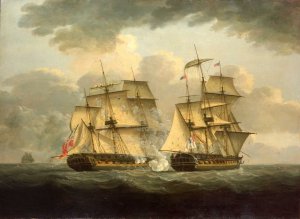
Action between HMS Venus (left) and French frigate La Sémillante, 27 May 1793.
An incident from the beginning of the French Revolutionary Wars, 1793-1815. The British ship ‘Venus’ commanded by Captain Jonathan Faulkner, sighted a strange sail at 03:00 when 120 miles south-west of Cape Finisterre. About 07:00 the ship put out blue colours and the ‘Venus’ answered by signalling a private code to which the other ship made no reply. The first shots were fired about 07:30 and then a close action from 08:00 to about 10:00. By this time the French frigate ‘Semillante’ was almost silenced, her captain and first lieutenant were killed and she had five feet of water in her hold. The ‘Venus’ was trying to close her to take possession when she bore away towards another ship that had appeared and which proved to be another French frigate. The sails, rigging and spars of the British frigate had taken the brunt of the enemy fire and were extremely cut up so that a further engagement was inadvisable. Indeed she was lucky to escape an encounter with a fresh opponent. In the right centre foreground, both frigates are shown starboard quarter view, with the ‘Semillante’ on the right. Most of her port lids have fallen shut, her main topgallant mast seems about to fall, and her colours are being struck. The ‘Venus’ is shown still firing although she is shot through and there are gaping holes in her main topsail. A seaman on the gunwhale of the quarter-deck can be seen putting out a small fire. In the left background of the painting is another French frigate, highlighting the precarious plight of the ‘Venus’. The painting is signed ‘T Elliott Pinxt’
HMS Venus (renamed HMS Heroine in 1809) was the name ship of the 36-gun Venus-class fifth-rate frigates of the Royal Navy. She was launched in 1758 and served for more than half a century until 1809. She was reduced from 36 guns to 32 guns in 1792. She was sold in 1822.
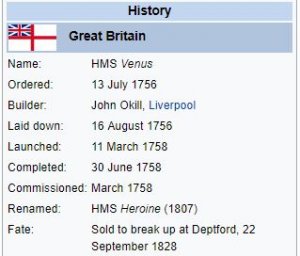
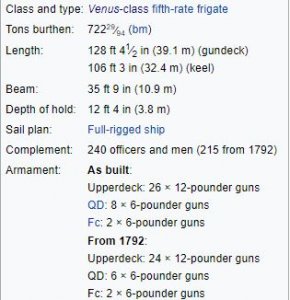
Career
On 18 May 1759, Venus, HMS Thames, and HMS Chatham, were in company when Venus intercepted the French frigate Arethuse near Audierne Bay (Baie d'Audierne (in French)). After a two-hour chase, Arethuselost her top masts and was overtaken. Thames and Venus engaged her with heavy fire, causing 60 casualties before she surrendered. Arethuse subsequently had a lengthy career as HMS Arethusa.
French Revolutionary Wars
On 27 May 1793, Venus, Captain Jonathon Faulkner, encountered the French frigate La Sémillante south-west of Cape Finisterre which resulted in close action. "The sails, rigging and spars of the British frigate had taken the brunt of the enemy fire and were extremely cut up so that a further engagement was inadvisable. Indeed she was lucky to escape an encounter with a fresh opponent."
On 17 July 1801, Tromp, Circe, and Venus left Portsmouth with a convoy to the West Indies.
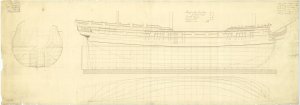
Lines (ZAZ2623)
Napoleonic Wars
On the morning of 10 July 1805, Venus encountered the French privateer brig Hirondelle. After a chase of 65 miles, during which Hirondelle threw two of her 6-pounder guns overboard, Venus succeeded in capturing her quarry. Hirondelle, of Dunkirk, was armed with four 6-pounder guns and twelve 3-pounder guns, and had a crew of 90 men. She left Gigeon, Spain, on 27 June, but had not captured anything. However, on prior cruise, she had captured several vessels, most notably the Falmouth packet Queen Charlotte, which had resisted for some two hours before striking her colours.
On 18 January 1807 Venus captured the French privateer brig Determinée of Guadeloupe, one hundred leagues east of Barbados after a chase of 16 hours. Determinée had a crew of 108 men and was pierced for 20 guns but carried only 14. The British took her into service as Netley.
Venus was paid-off and put into Ordinary in July 1807 at Woolwich. On 14 July 1807 she was renamed Heroine after the capture of the Danish vessel Venus.
Between March and May 1809 she was fitted for Baltic service. Captain Hood Hanway Christian recommissioned Heroine in March and commanded her until November 1809. Heroine participated in the reduction of Flushing in 1809 during the Walcheren Campaign. In this engagement Heroine was part of a squadron of ten frigates under the command of Captain Lord William Stuart. On 11 August 1809 this squadron sailed up the western Scheldt under a light wind, suffering minor damage from the shore batteries of Flushing and Cadzand. Two men were wounded on Heroine.
Fate
Heroine was paid off and laid up at Sheerness between November 1809 and December 1823. Between 1817 and 1820 she served as a receiving ship. Then between December 1823 and June 1824 she underwent fitting at Woolwich to serve as a temporary convict ship. The "Principal Officers and Commissioners of His Majesty's Navy offered "Heroine, of 32 guns and 722 tons", lying at Deptford, for sale on 22 September 1828. She was sold on that date to John Small Sedger for £1,170.
sistership Brilliant
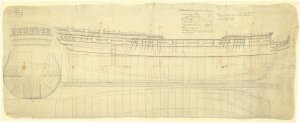
Lines & Profile (ZAZ2625)
The Venus-class frigates were three 36-gun sailing frigates of the fifth rate produced for the Royal Navy. They were designed in 1756 by Sir Thomas Slade, and were enlarged from his design for the 32-gun Southampton-class frigates, which had been approved four months earlier.
The 36-gun frigates, of which this was to be the only British design in the era of the 12-pounder frigate, carried the same battery of twenty-six 12-pounders as the 32-gun predecessors; the only difference lay in the secondary armament on the quarter deck, which was here doubled to eight 6-pounders. Slade's 36-gun design was approved on 13 July 1756, on which date two ships were approved to be built by contract to these plans. A third ship was ordered about two weeks later, to be built in a royal dockyard.
The Venus-class were faster than their Southampton-class predecessors, making up to 13 knots ahead of strong winds and ten knots while close-hauled compared with Southampton-class speeds of 12 and 8 knots respectively. Both Venus- and Southampton-class frigates were highly maneuverable and capable of withstanding heavy weather, in comparison with their French counterparts during the Seven Years' War.
Ships in class


 en.wikipedia.org
https://threedecks.org/index.php?display_type=show_battle&id=252
en.wikipedia.org
https://threedecks.org/index.php?display_type=show_battle&id=252
27 May 1793 – HMS Venus (32), Cptn. Jonathan Faulknor, engaged french La Semillante (36).
On 27 May 1793, Venus, Captain Jonathon Faulkner, encountered the French frigate La Sémillante south-west of Cape Finisterre which resulted in close action.[2] "The sails, rigging and spars of the British frigate had taken the brunt of the enemy fire and were extremely cut up so that a further engagement was inadvisable. Indeed she was lucky to escape an encounter with a fresh opponent.

Action between HMS Venus (left) and French frigate La Sémillante, 27 May 1793.
An incident from the beginning of the French Revolutionary Wars, 1793-1815. The British ship ‘Venus’ commanded by Captain Jonathan Faulkner, sighted a strange sail at 03:00 when 120 miles south-west of Cape Finisterre. About 07:00 the ship put out blue colours and the ‘Venus’ answered by signalling a private code to which the other ship made no reply. The first shots were fired about 07:30 and then a close action from 08:00 to about 10:00. By this time the French frigate ‘Semillante’ was almost silenced, her captain and first lieutenant were killed and she had five feet of water in her hold. The ‘Venus’ was trying to close her to take possession when she bore away towards another ship that had appeared and which proved to be another French frigate. The sails, rigging and spars of the British frigate had taken the brunt of the enemy fire and were extremely cut up so that a further engagement was inadvisable. Indeed she was lucky to escape an encounter with a fresh opponent. In the right centre foreground, both frigates are shown starboard quarter view, with the ‘Semillante’ on the right. Most of her port lids have fallen shut, her main topgallant mast seems about to fall, and her colours are being struck. The ‘Venus’ is shown still firing although she is shot through and there are gaping holes in her main topsail. A seaman on the gunwhale of the quarter-deck can be seen putting out a small fire. In the left background of the painting is another French frigate, highlighting the precarious plight of the ‘Venus’. The painting is signed ‘T Elliott Pinxt’
HMS Venus (renamed HMS Heroine in 1809) was the name ship of the 36-gun Venus-class fifth-rate frigates of the Royal Navy. She was launched in 1758 and served for more than half a century until 1809. She was reduced from 36 guns to 32 guns in 1792. She was sold in 1822.


Career
On 18 May 1759, Venus, HMS Thames, and HMS Chatham, were in company when Venus intercepted the French frigate Arethuse near Audierne Bay (Baie d'Audierne (in French)). After a two-hour chase, Arethuselost her top masts and was overtaken. Thames and Venus engaged her with heavy fire, causing 60 casualties before she surrendered. Arethuse subsequently had a lengthy career as HMS Arethusa.
French Revolutionary Wars
On 27 May 1793, Venus, Captain Jonathon Faulkner, encountered the French frigate La Sémillante south-west of Cape Finisterre which resulted in close action. "The sails, rigging and spars of the British frigate had taken the brunt of the enemy fire and were extremely cut up so that a further engagement was inadvisable. Indeed she was lucky to escape an encounter with a fresh opponent."
On 17 July 1801, Tromp, Circe, and Venus left Portsmouth with a convoy to the West Indies.

Lines (ZAZ2623)
Napoleonic Wars
On the morning of 10 July 1805, Venus encountered the French privateer brig Hirondelle. After a chase of 65 miles, during which Hirondelle threw two of her 6-pounder guns overboard, Venus succeeded in capturing her quarry. Hirondelle, of Dunkirk, was armed with four 6-pounder guns and twelve 3-pounder guns, and had a crew of 90 men. She left Gigeon, Spain, on 27 June, but had not captured anything. However, on prior cruise, she had captured several vessels, most notably the Falmouth packet Queen Charlotte, which had resisted for some two hours before striking her colours.
On 18 January 1807 Venus captured the French privateer brig Determinée of Guadeloupe, one hundred leagues east of Barbados after a chase of 16 hours. Determinée had a crew of 108 men and was pierced for 20 guns but carried only 14. The British took her into service as Netley.
Venus was paid-off and put into Ordinary in July 1807 at Woolwich. On 14 July 1807 she was renamed Heroine after the capture of the Danish vessel Venus.
Between March and May 1809 she was fitted for Baltic service. Captain Hood Hanway Christian recommissioned Heroine in March and commanded her until November 1809. Heroine participated in the reduction of Flushing in 1809 during the Walcheren Campaign. In this engagement Heroine was part of a squadron of ten frigates under the command of Captain Lord William Stuart. On 11 August 1809 this squadron sailed up the western Scheldt under a light wind, suffering minor damage from the shore batteries of Flushing and Cadzand. Two men were wounded on Heroine.
Fate
Heroine was paid off and laid up at Sheerness between November 1809 and December 1823. Between 1817 and 1820 she served as a receiving ship. Then between December 1823 and June 1824 she underwent fitting at Woolwich to serve as a temporary convict ship. The "Principal Officers and Commissioners of His Majesty's Navy offered "Heroine, of 32 guns and 722 tons", lying at Deptford, for sale on 22 September 1828. She was sold on that date to John Small Sedger for £1,170.
sistership Brilliant

Lines & Profile (ZAZ2625)
The Venus-class frigates were three 36-gun sailing frigates of the fifth rate produced for the Royal Navy. They were designed in 1756 by Sir Thomas Slade, and were enlarged from his design for the 32-gun Southampton-class frigates, which had been approved four months earlier.
The 36-gun frigates, of which this was to be the only British design in the era of the 12-pounder frigate, carried the same battery of twenty-six 12-pounders as the 32-gun predecessors; the only difference lay in the secondary armament on the quarter deck, which was here doubled to eight 6-pounders. Slade's 36-gun design was approved on 13 July 1756, on which date two ships were approved to be built by contract to these plans. A third ship was ordered about two weeks later, to be built in a royal dockyard.
The Venus-class were faster than their Southampton-class predecessors, making up to 13 knots ahead of strong winds and ten knots while close-hauled compared with Southampton-class speeds of 12 and 8 knots respectively. Both Venus- and Southampton-class frigates were highly maneuverable and capable of withstanding heavy weather, in comparison with their French counterparts during the Seven Years' War.
Ships in class


HMS Venus (1758) - Wikipedia
British Fifth Rate frigate 'Venus' (1758)
British Fifth Rate frigate 'Venus' (1758). Dates of service, name changes, previous and next incarnations, dimensions, armament, commanders, officers and crewmen, actions, battles, sources
threedecks.org
Today in Naval History - Naval / Maritime Events in History
27 May 1798 - HMS Seahorse versus french Sensible
After the capture of Malta by the French, the frigate Sensible, 36, Captain Bourde, was sent with dispatches and valuables to Toulon, and when on her way thither off Marittimo, was chased by the British Seahorse, 38, Captain Edward James Foote. The French ship turned and ran towards Malta, as she had but a very weak crew on board and was not properly equipped. In the night of the 26th-27th, the Seahorse gained upon her, and, after a running fight, brought her to close action at 4 A.M. Many of the Maltese galley slaves, who had been placed on board the Sensible, deserted their guns at the first broadside, and at the end of eight minutes' action the French captain, having made a vain attempt to board his enemy, hauled down his flag. He was censured by the French Directory for not having offered a more stubborn resistance, but, as a matter of fact, the force opposed to him was very superior, and he was acquitted with honour by a French court-martial on his return to Toulon.
HMS Seahorse was a 38-gun Artois-class fifth-rate frigate of the Royal Navy. She was launched in 1794 and broken up in 1819.
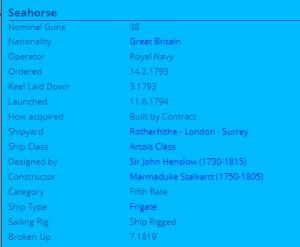
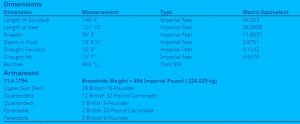

French La Sensible (1787 - 32)

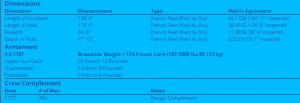

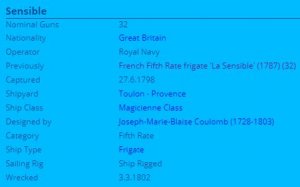

https://threedecks.org/index.php?display_type=show_battle&id=678

 en.wikipedia.org
en.wikipedia.org
27 May 1798 - HMS Seahorse versus french Sensible
After the capture of Malta by the French, the frigate Sensible, 36, Captain Bourde, was sent with dispatches and valuables to Toulon, and when on her way thither off Marittimo, was chased by the British Seahorse, 38, Captain Edward James Foote. The French ship turned and ran towards Malta, as she had but a very weak crew on board and was not properly equipped. In the night of the 26th-27th, the Seahorse gained upon her, and, after a running fight, brought her to close action at 4 A.M. Many of the Maltese galley slaves, who had been placed on board the Sensible, deserted their guns at the first broadside, and at the end of eight minutes' action the French captain, having made a vain attempt to board his enemy, hauled down his flag. He was censured by the French Directory for not having offered a more stubborn resistance, but, as a matter of fact, the force opposed to him was very superior, and he was acquitted with honour by a French court-martial on his return to Toulon.
HMS Seahorse was a 38-gun Artois-class fifth-rate frigate of the Royal Navy. She was launched in 1794 and broken up in 1819.



French La Sensible (1787 - 32)





https://threedecks.org/index.php?display_type=show_battle&id=678
British Fifth Rate frigate 'Seahorse' (1794)
British Fifth Rate frigate 'Seahorse' (1794). Dates of service, name changes, previous and next incarnations, dimensions, armament, commanders, officers and crewmen, actions, battles, sources
threedecks.org
British Fifth Rate frigate 'Sensible' (1798)
British Fifth Rate frigate 'Sensible' (1798). Dates of service, name changes, previous and next incarnations, dimensions, armament, commanders, officers and crewmen, actions, battles, sources
threedecks.org

HMS Seahorse (1794) - Wikipedia
Today in Naval History - Naval / Maritime Events in History
27 May 1813 - Action of 1813/05/27, 27th May 1813
Boats of HMS Apollo (38), Cptn. Bridges W. Taylor, and HMS Cerberus (32), Cptn. Thomas Garth, took 3 gunboats at Faro.
On May 27th, observing in Otranto a convoy which, it was expected, would make for Corfu with the first favourable wind, Captain Thomas Garth, with the Cerberus, took up a station off Fano, having first sent in two boats from the Cerberus, and two belonging to the Apollo, under Lieutenants John William Montagu and William Henry Nares, to lie in wait under the Apulian shore. At 1 A.M. on the 28th, the convoy came out, protected by eight gunboats; yet, in spite of the inequality of force, the boats attacked them with great determination. Nares boarded and carried one; Midshipman William Hutchison mastered another. In attempting a third, Master's Mate Thomas Richard Suett was shot through the heart. He, and 1 seaman, were the only British killed, and but one other person was wounded. Each of the captured gunboats mounted three guns. Four of the convoy were taken also.
HMS Apollo (1805 - 36)
HMS Apollo, the fifth ship of the Royal Navy to be named for the Greek god Apollo, was a fifth-rate frigate of the Lively class, carrying 38 guns, launched in 1805 and broken up in 1856.
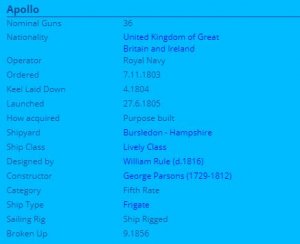

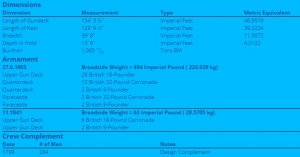

HMS Cerberus (1794 - 32)
HMS Cerberus was a 32-gun fifth-rate frigate of the Royal Navy. She served in the French Revolutionary and the Napoleonic Wars in the Channel, the Mediterranean, the Adriatic, and even briefly in the Baltic against the Russians. She participated in one boat action that won for her crew a clasp to the Naval General Service Medal (NGSM). She also captured many privateers and merchant vessels. Her biggest battle was the Battle of Lissa, which won for her crew another clasp to the NGSM. She was sold in 1814.
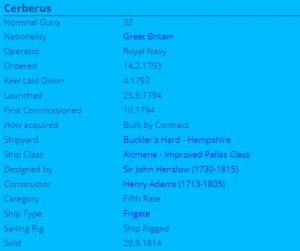
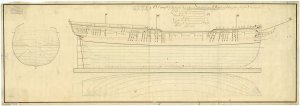
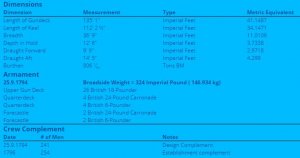


https://threedecks.org/index.php?display_type=show_battle&id=726

 en.wikipedia.org
en.wikipedia.org

 en.wikipedia.org
en.wikipedia.org
27 May 1813 - Action of 1813/05/27, 27th May 1813
Boats of HMS Apollo (38), Cptn. Bridges W. Taylor, and HMS Cerberus (32), Cptn. Thomas Garth, took 3 gunboats at Faro.
On May 27th, observing in Otranto a convoy which, it was expected, would make for Corfu with the first favourable wind, Captain Thomas Garth, with the Cerberus, took up a station off Fano, having first sent in two boats from the Cerberus, and two belonging to the Apollo, under Lieutenants John William Montagu and William Henry Nares, to lie in wait under the Apulian shore. At 1 A.M. on the 28th, the convoy came out, protected by eight gunboats; yet, in spite of the inequality of force, the boats attacked them with great determination. Nares boarded and carried one; Midshipman William Hutchison mastered another. In attempting a third, Master's Mate Thomas Richard Suett was shot through the heart. He, and 1 seaman, were the only British killed, and but one other person was wounded. Each of the captured gunboats mounted three guns. Four of the convoy were taken also.
HMS Apollo (1805 - 36)
HMS Apollo, the fifth ship of the Royal Navy to be named for the Greek god Apollo, was a fifth-rate frigate of the Lively class, carrying 38 guns, launched in 1805 and broken up in 1856.




HMS Cerberus (1794 - 32)
HMS Cerberus was a 32-gun fifth-rate frigate of the Royal Navy. She served in the French Revolutionary and the Napoleonic Wars in the Channel, the Mediterranean, the Adriatic, and even briefly in the Baltic against the Russians. She participated in one boat action that won for her crew a clasp to the Naval General Service Medal (NGSM). She also captured many privateers and merchant vessels. Her biggest battle was the Battle of Lissa, which won for her crew another clasp to the NGSM. She was sold in 1814.




https://threedecks.org/index.php?display_type=show_battle&id=726
British Fifth Rate frigate 'Apollo' (1805)
British Fifth Rate frigate 'Apollo' (1805). Dates of service, name changes, previous and next incarnations, dimensions, armament, commanders, officers and crewmen, actions, battles, sources
threedecks.org
British Fifth Rate frigate 'Cerberus' (1794)
British Fifth Rate frigate 'Cerberus' (1794). Dates of service, name changes, previous and next incarnations, dimensions, armament, commanders, officers and crewmen, actions, battles, sources
threedecks.org

HMS Apollo (1805) - Wikipedia

HMS Cerberus (1794) - Wikipedia
Today in Naval History - Naval / Maritime Events in History
27 May 1862 - USS Bienville captures the British blockade-runner Patras off Bulls Island, S.C.
and USS Santiago de Cuba captures the schooner Lucy C. Holmes off Charleston.
USS Bienville was a 1,558 long tons (1,583 t) (burden) wooden side-wheel paddle steamer acquired by the Union Navy early in the American Civil War. She was armed with heavy guns and assigned to the Union blockade of the waterways of the Confederate States of America.
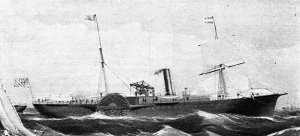
Built in Brooklyn, New York
Bienville built at Brooklyn, New York in 1860. She was a two-masted sail-steamer, with a Walking beam steam engine driving a pair of side paddle wheels. The Union Navy bought her in August 1861 as part of the great expansion that took place in the first months of the American Civil War.
Civil War operations
Assigned to the South Atlantic blockade
She was commissioned in October 1861 and soon took part in the expedition that seized future Naval bases at Port Royal and Beaufort, South Carolina. Bienville operated off the Confederacy's Atlantic coast for more than a year, taking part in the capture of positions along the Georgia and Florida shore as well as ending the careers of several blockade runners, among them the steamships Stettin (later USS Stettin) (taken on May 24, 1862) and Patras (May 27, 1862).
Gulf of Mexico operations
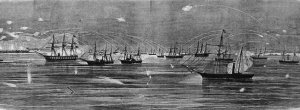
Bombardment and Capture of Port Royal, South Carolina, November 7, 1861
In 1863 USS Bienville was transferred to the Gulf of Mexico, where she continued her blockading work. She supported the capture of the entrances to Mobile Bay, Alabama on August 5, 1864. The USS Princess Royal and Bienville was stationed off the coast of Texas blockading Galveston. On the night of February 7, 1865, the two gunships sent a boat party into Galveston Bay, Texas to seize two schooners loaded with cotton. The actual prize sought was the destruction of Wren, a ship built by Laird, Son & Co. of Birkenhead (no. 317), along with sister ship (no. 318) the Lark, for Fraser, Trenholm and Company. The Wren had run aground February 6, 1865, but was freed narrowly escaping capture, and moored inside Galveston Harbor. The schooners Pet, with 256 bales of cotton on board, and Annie Sophia, with 220 bales, were anchored near the main channel at Fort Point. Acting Ensign George French was dispatched with twenty seamen and three officers to destroy the Wren and capture the schooners. Successful in capturing the schooners they were not able to get to the Wren.
Decommissioning and civilian career
Bienville was decommissioned soon after the end of the Civil War. After about two years in reserve, she was sold in October 1867. She operated under the same name as a commercial steamship until August 15, 1872, when a fire destroyed her at Watling Island, Bahamas.
USS Santiago de Cuba (1861) was a brig acquired by the Union Navy during the first year of the American Civil War. She was outfitted as a gunboat with powerful 20-pounder rifled guns and 32-pounder cannon and was assigned to the Union blockade of the Confederate States of America.
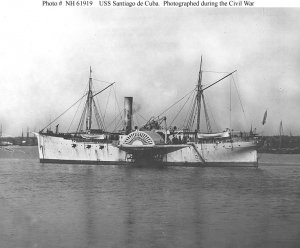
Commissioned in New York City in 1861
USS Santiago de Cuba was a wooden, brigantine-rigged, side-wheel steamship built in 1861 at Brooklyn, New York. She was purchased by the Navy on 6 September 1861 at New York City; and was commissioned at the New York Navy Yard on 5 November 1861, Commander Daniel B. Ridgely in command.
Civil War service
Gulf of Mexico operations
The new steamer was ordered to Havana, Cuba,
Santiago de Cuba scored next on 26 April 1862 when she took schooner, Mersey, of Charleston, South Carolina; and she captured schooner, Maria, on the 30th off Port Royal, South Carolina. Schooner, Lucy C. Holmes, laden with cotton, fell into her clutches on 27 May, and the Union side wheeler seized blockade runners, Columbia on 3 August and Lavinia on the 27th—both off Abaco in the Bahamas.
Searching for commerce raiders and blockade runners
In September, Santiago de Cuba was assigned to a newly organized "Flying Squadron," created to seek out and capture Confederate commerce raiders Alabama and Florida. The squadron caught several prizes but never found the elusive Southern warships.
On 21 June 1863, Santiago de Cuba overtook Victory off Palmetto Point, Eleuthera Island, ending a long chase after the British steamer had slipped through the blockade off Charleston with a cargo of cotton, tobacco, and turpentine. On the 25th, she took steamer, Britannia, in the same area. On 15 July, she boarded steamer, Lizzie, east of the Florida coast and sent the prize to Key West, Florida for trial.
Late in the year, Santiago de Cuba sailed north for repairs and decommissioned on 30 December 1863.
North Atlantic blockade operations
Overhaul completed, the side wheeler recommissioned on 6 June 1864 and resumed her chase. Some three months later, Santiago de Cuba took A. D. Vance at sea northeast of Wilmington, North Carolina attempting to carry a cargo of cotton to Europe. On 2 November 1864, blockade runner steamer, Lucy, struck her colors in compliance with a demand from Santiago de Cuba.
Soon thereafter, the steamer began preparation for a new experience. She was assigned to the task force in which Rear Admiral David Dixon Porter attacked Fort Fisher on Christmas Eve, 1864. During the operation, she protected the landing troops as they went ashore, supported them during the fighting, and covered them as they reluctantly reembarked the next day, under orders of General Benjamin F. Butler, the army commander.
Porter immediately began work organizing a new invasion force. The union warships and Army transports returned to the vicinity of Wilmington in mid-January 1865. After a bloody three-day fight, Fort Fisher fell on the 15th.
The next day, Santiago de Cuba embarked men wounded in the battle and sailed for Norfolk, Virginia.
Decommissioning and subsequent career
Before the war ended, Santiago de Cuba was the steamship that took Captain Robert Anderson (Civil War) and John George Nicolay, Private Secretary to President Lincoln, down to Cuba and then to Charlestown, SC for the ceremonial re-raising of the flag at Ft Sumter on Friday, April 14, 1865. This ceremony was intended to celebrate the ending of the civil war and be the event that would be remembered at the conclusion of the American Civil War. It is Lincoln's assassination on that date that history remembers.
Since the war had ended, Santiago de Cuba was decommissioned on 17 June 1865 at the Philadelphia Navy Yard. She was sold at public auction in Philadelphia, Pennsylvania, on 21 September 1865.
She was redocumented on 16 November 1865. For more than two decades, she operated in mercantile service. On 7 December 1886, her engines were removed, and she was rigged as a schooner. Records of her subsequent career have disappeared.
https://en.wikipedia.org/wiki/USS_Bienville
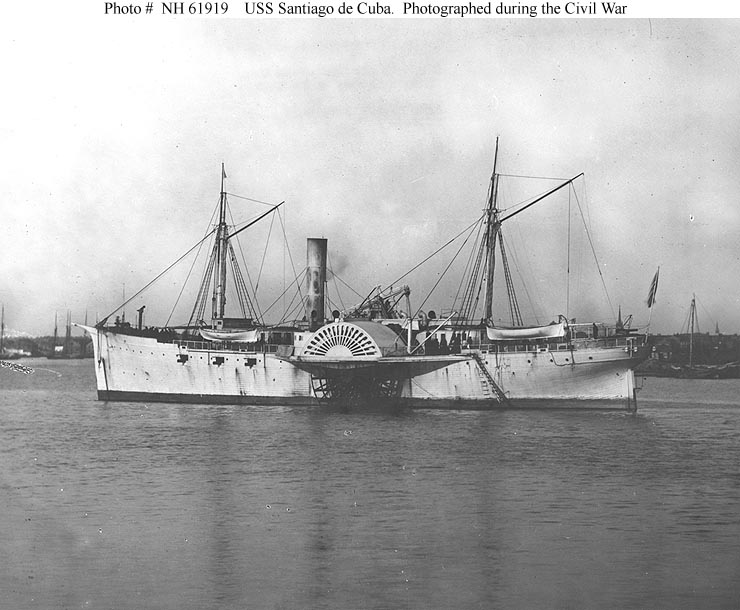
 en.wikipedia.org
en.wikipedia.org
27 May 1862 - USS Bienville captures the British blockade-runner Patras off Bulls Island, S.C.
and USS Santiago de Cuba captures the schooner Lucy C. Holmes off Charleston.
USS Bienville was a 1,558 long tons (1,583 t) (burden) wooden side-wheel paddle steamer acquired by the Union Navy early in the American Civil War. She was armed with heavy guns and assigned to the Union blockade of the waterways of the Confederate States of America.

Built in Brooklyn, New York
Bienville built at Brooklyn, New York in 1860. She was a two-masted sail-steamer, with a Walking beam steam engine driving a pair of side paddle wheels. The Union Navy bought her in August 1861 as part of the great expansion that took place in the first months of the American Civil War.
Civil War operations
Assigned to the South Atlantic blockade
She was commissioned in October 1861 and soon took part in the expedition that seized future Naval bases at Port Royal and Beaufort, South Carolina. Bienville operated off the Confederacy's Atlantic coast for more than a year, taking part in the capture of positions along the Georgia and Florida shore as well as ending the careers of several blockade runners, among them the steamships Stettin (later USS Stettin) (taken on May 24, 1862) and Patras (May 27, 1862).
Gulf of Mexico operations

Bombardment and Capture of Port Royal, South Carolina, November 7, 1861
In 1863 USS Bienville was transferred to the Gulf of Mexico, where she continued her blockading work. She supported the capture of the entrances to Mobile Bay, Alabama on August 5, 1864. The USS Princess Royal and Bienville was stationed off the coast of Texas blockading Galveston. On the night of February 7, 1865, the two gunships sent a boat party into Galveston Bay, Texas to seize two schooners loaded with cotton. The actual prize sought was the destruction of Wren, a ship built by Laird, Son & Co. of Birkenhead (no. 317), along with sister ship (no. 318) the Lark, for Fraser, Trenholm and Company. The Wren had run aground February 6, 1865, but was freed narrowly escaping capture, and moored inside Galveston Harbor. The schooners Pet, with 256 bales of cotton on board, and Annie Sophia, with 220 bales, were anchored near the main channel at Fort Point. Acting Ensign George French was dispatched with twenty seamen and three officers to destroy the Wren and capture the schooners. Successful in capturing the schooners they were not able to get to the Wren.
Decommissioning and civilian career
Bienville was decommissioned soon after the end of the Civil War. After about two years in reserve, she was sold in October 1867. She operated under the same name as a commercial steamship until August 15, 1872, when a fire destroyed her at Watling Island, Bahamas.
USS Santiago de Cuba (1861) was a brig acquired by the Union Navy during the first year of the American Civil War. She was outfitted as a gunboat with powerful 20-pounder rifled guns and 32-pounder cannon and was assigned to the Union blockade of the Confederate States of America.

Commissioned in New York City in 1861
USS Santiago de Cuba was a wooden, brigantine-rigged, side-wheel steamship built in 1861 at Brooklyn, New York. She was purchased by the Navy on 6 September 1861 at New York City; and was commissioned at the New York Navy Yard on 5 November 1861, Commander Daniel B. Ridgely in command.
Civil War service
Gulf of Mexico operations
The new steamer was ordered to Havana, Cuba,
She reached Havana on 17 November. On 3 December, she captured British blockade runner schooner, Victoria, at sea some 90 miles west of Point Isabel, Texas, and sent the prize to Galveston, Texas. Four days later, she chased and overtook British schooner, Eugenia Smith, but released her for want of evidence justifying a seizure. Thus, she began a career which kept her at sea during much of the Civil War.... to protect legitimate commerce and to suppress communications and traffic with or by the insurgents ...
Santiago de Cuba scored next on 26 April 1862 when she took schooner, Mersey, of Charleston, South Carolina; and she captured schooner, Maria, on the 30th off Port Royal, South Carolina. Schooner, Lucy C. Holmes, laden with cotton, fell into her clutches on 27 May, and the Union side wheeler seized blockade runners, Columbia on 3 August and Lavinia on the 27th—both off Abaco in the Bahamas.
Searching for commerce raiders and blockade runners
In September, Santiago de Cuba was assigned to a newly organized "Flying Squadron," created to seek out and capture Confederate commerce raiders Alabama and Florida. The squadron caught several prizes but never found the elusive Southern warships.
On 21 June 1863, Santiago de Cuba overtook Victory off Palmetto Point, Eleuthera Island, ending a long chase after the British steamer had slipped through the blockade off Charleston with a cargo of cotton, tobacco, and turpentine. On the 25th, she took steamer, Britannia, in the same area. On 15 July, she boarded steamer, Lizzie, east of the Florida coast and sent the prize to Key West, Florida for trial.
Late in the year, Santiago de Cuba sailed north for repairs and decommissioned on 30 December 1863.
North Atlantic blockade operations
Overhaul completed, the side wheeler recommissioned on 6 June 1864 and resumed her chase. Some three months later, Santiago de Cuba took A. D. Vance at sea northeast of Wilmington, North Carolina attempting to carry a cargo of cotton to Europe. On 2 November 1864, blockade runner steamer, Lucy, struck her colors in compliance with a demand from Santiago de Cuba.
Soon thereafter, the steamer began preparation for a new experience. She was assigned to the task force in which Rear Admiral David Dixon Porter attacked Fort Fisher on Christmas Eve, 1864. During the operation, she protected the landing troops as they went ashore, supported them during the fighting, and covered them as they reluctantly reembarked the next day, under orders of General Benjamin F. Butler, the army commander.
Porter immediately began work organizing a new invasion force. The union warships and Army transports returned to the vicinity of Wilmington in mid-January 1865. After a bloody three-day fight, Fort Fisher fell on the 15th.
The next day, Santiago de Cuba embarked men wounded in the battle and sailed for Norfolk, Virginia.
Decommissioning and subsequent career
Before the war ended, Santiago de Cuba was the steamship that took Captain Robert Anderson (Civil War) and John George Nicolay, Private Secretary to President Lincoln, down to Cuba and then to Charlestown, SC for the ceremonial re-raising of the flag at Ft Sumter on Friday, April 14, 1865. This ceremony was intended to celebrate the ending of the civil war and be the event that would be remembered at the conclusion of the American Civil War. It is Lincoln's assassination on that date that history remembers.
Since the war had ended, Santiago de Cuba was decommissioned on 17 June 1865 at the Philadelphia Navy Yard. She was sold at public auction in Philadelphia, Pennsylvania, on 21 September 1865.
She was redocumented on 16 November 1865. For more than two decades, she operated in mercantile service. On 7 December 1886, her engines were removed, and she was rigged as a schooner. Records of her subsequent career have disappeared.
https://en.wikipedia.org/wiki/USS_Bienville

USS Santiago de Cuba - Wikipedia
Today in Naval History - Naval / Maritime Events in History
27 May 1905 - Battle of Tsushima
May 27–28 Tsushima - Japanese defeat Russians in large fleet battle between Korea and Japan
The Battle of Tsushima (Russian: Цусимское сражение, Tsusimskoye srazheniye), also known as the Battle of Tsushima Strait and the Naval Battle of the Sea of Japan (Japanese: 日本海海戦, Nihonkai-Kaisen) in Japan, was a major naval battle fought between Russia and Japan during the Russo-Japanese War. It was naval history's only decisive sea battle fought by modern steel battleship fleets, and the first naval battle in which wireless telegraphy (radio) played a critically important role. It has been characterized as the "dying echo of the old era – for the last time in the history of naval warfare, ships of the line of a beaten fleet surrendered on the high seas".
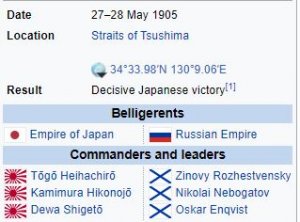
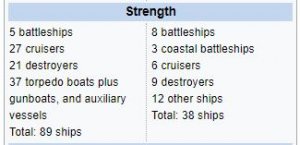
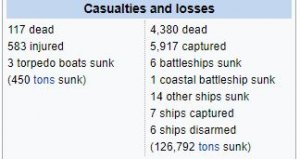
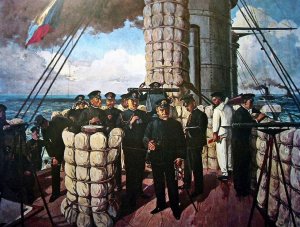
Admiral Tōgō on the bridge of Mikasa, at the beginning of the Battle of Tsushima in 1905. The signal flag being hoisted is the letter Z, which was a special instruction to the Fleet.
It was fought on 27–28 May 1905 (14–15 May in the Julian calendar then in use in Russia) in the Tsushima Strait between Korea and southern Japan. In this battle the Japanese fleet under Admiral Tōgō Heihachirō destroyed two-thirds of the Russian fleet, under Admiral Zinovy Rozhestvensky, which had traveled over 18,000 nautical miles (33,000 km) to reach the Far East. In London in 1906, Sir George Sydenham Clarke wrote, "The battle of Tsu-shima is by far the greatest and the most important naval event since Trafalgar"; decades later, historian Edmund Morris agreed with this judgment. The destruction of the Russian navy caused a bitter reaction from the Russian public, which induced a peace treaty in September 1905 without any further battles.
Prior to the Russo-Japanese War, countries constructed their battleships with mixed batteries of mainly 6-inch (152 mm), 8-inch (203 mm), 10-inch (254 mm) and 12-inch (305 mm) guns, with the intent that these battleships fight on the battle line in a close-quarter, decisive fleet action. The Battle of Tsushima conclusively demonstrated that battleship speed and big guns with longer ranges were more advantageous in naval battles than mixed batteries of different sizes.
The battle was also the first time that wireless telegraphy was used in naval combat. The wireless telegraph had been invented during the last half of the 1890s, and by the turn of the century nearly all major navies were adopting this improved communications technology. Nonetheless Tsushima would be "the first major sea battle in which wireless played any role whatsoever"
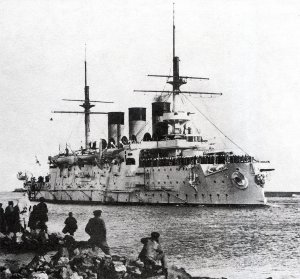
Russian battleship Oslyabya, the first warship sunk in the battle
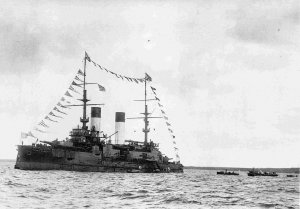
Other than the 20 wounded officers evacuated by a destroyer, Admiral Rozhestvensky's flagship Knyaz Suvorov was sunk with all hands

 en.wikipedia.org
en.wikipedia.org
27 May 1905 - Battle of Tsushima
May 27–28 Tsushima - Japanese defeat Russians in large fleet battle between Korea and Japan
The Battle of Tsushima (Russian: Цусимское сражение, Tsusimskoye srazheniye), also known as the Battle of Tsushima Strait and the Naval Battle of the Sea of Japan (Japanese: 日本海海戦, Nihonkai-Kaisen) in Japan, was a major naval battle fought between Russia and Japan during the Russo-Japanese War. It was naval history's only decisive sea battle fought by modern steel battleship fleets, and the first naval battle in which wireless telegraphy (radio) played a critically important role. It has been characterized as the "dying echo of the old era – for the last time in the history of naval warfare, ships of the line of a beaten fleet surrendered on the high seas".




Admiral Tōgō on the bridge of Mikasa, at the beginning of the Battle of Tsushima in 1905. The signal flag being hoisted is the letter Z, which was a special instruction to the Fleet.
It was fought on 27–28 May 1905 (14–15 May in the Julian calendar then in use in Russia) in the Tsushima Strait between Korea and southern Japan. In this battle the Japanese fleet under Admiral Tōgō Heihachirō destroyed two-thirds of the Russian fleet, under Admiral Zinovy Rozhestvensky, which had traveled over 18,000 nautical miles (33,000 km) to reach the Far East. In London in 1906, Sir George Sydenham Clarke wrote, "The battle of Tsu-shima is by far the greatest and the most important naval event since Trafalgar"; decades later, historian Edmund Morris agreed with this judgment. The destruction of the Russian navy caused a bitter reaction from the Russian public, which induced a peace treaty in September 1905 without any further battles.
Prior to the Russo-Japanese War, countries constructed their battleships with mixed batteries of mainly 6-inch (152 mm), 8-inch (203 mm), 10-inch (254 mm) and 12-inch (305 mm) guns, with the intent that these battleships fight on the battle line in a close-quarter, decisive fleet action. The Battle of Tsushima conclusively demonstrated that battleship speed and big guns with longer ranges were more advantageous in naval battles than mixed batteries of different sizes.
The battle was also the first time that wireless telegraphy was used in naval combat. The wireless telegraph had been invented during the last half of the 1890s, and by the turn of the century nearly all major navies were adopting this improved communications technology. Nonetheless Tsushima would be "the first major sea battle in which wireless played any role whatsoever"

Russian battleship Oslyabya, the first warship sunk in the battle

Other than the 20 wounded officers evacuated by a destroyer, Admiral Rozhestvensky's flagship Knyaz Suvorov was sunk with all hands

Battle of Tsushima - Wikipedia
Today in Naval History - Naval / Maritime Events in History
27 May 1915 - HMS Princess Irene, an ocean liner requisitioned by the Royal Navy on completion and converted to an auxiliary minelayer, exploded and sank off Sheerness, Kent with the loss of 352 lives.
HMS Princess Irene was a 5,394 GRT ocean liner which was built in 1914 by William Denny and Brothers Ltd, Dumbarton, Scotland for the Canadian Pacific Railway. She was requisitioned by the Royal Navy on completion and converted to an auxiliary minelayer. On 27 May 1915, she exploded and sank off Sheerness, Kent with the loss of 352 lives.
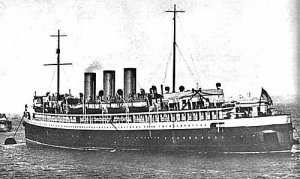
Description
Princess Irene was 395 feet (120 m) long. She had a beam of 54 feet (16 m) and a draught of 17 feet (5.2 m). She was powered by four steam turbines which were built by Denny's and could give the ship a service speed of 22.5 knots (41.7 km/h).
History
Princess Irene was built by William Denny and Brothers Ltd, Dumbarton for the Canadian Pacific Railway. She was launched on 20 October 1914. With her sister ship Princess Margaret, she was built to serve on the Vancouver – Victoria – Seattle route. Her port of registry was Victoria. Princess Irene was requisitioned by the Royal Navy on completion and converted to an auxiliary minelayer. She had a complement of 225 officers and men.
Loss
In May 1915, Princess Irene was moored in Saltpan Reach, on the Medway Estuary in Kent between Port Victoria and Sheerness, being loaded with mines in preparation for deployment on a minelaying mission. At 11:14 GMT on 27 May, Princess Irene exploded and disintegrated. A column of flame 300 feet (100 m) high was followed a few seconds later by another of similar height and a pall of smoke hung over the spot where Princess Irene had been, reaching to 1,200 feet (400 m).[6] Two barges laying alongside her were also destroyed. The explosion was larger than that which had destroyed HMS Bulwark in the Medway six months earlier, although the loss of life was less. A total of 352 people were killed, including 273 officers and men, and 76 dockyard workers who were on board Princess Irene. On the Isle of Grain a girl of nine was killed by flying débris, and a farmhand died of shock.[4] A collier half a mile (800 m) away had its crane blown off its mountings. A part of one of Princess Irene's boilers landed on the ship; a man working on the ship died from injuries sustained when he was struck by a piece of metal weighing 70 pounds (32 kg).
Wreckage was flung up to 20 miles (32 km) away, with people near Sittingbourne being injured by flying débris, some of which landed in Bredhurst.[2] Severed heads were found at Hartlip and on the Isle of Grain. A case of butter landed at Rainham, 6 miles (10 km) away. A 10-ton (10,160 kg) section of the ship landed on the Isle of Grain. The Admiralty's oil storage tanks there were damaged. The sole survivor from Princess Irene was a stoker, who suffered severe burns.[4] Three of her crew had a lucky escape as they were ashore at the time.
The victims whose bodies were recovered were buried at Woodlands Road Cemetery, Gillingham. A memorial service for the victims was held at the Dockyard Church, Sheerness on 1 June 1915. It was led by Randall Davidson, the Archbishop of Canterbury. Inquests were held on two victims of the disaster. The coroner stated that he did not intend to hold an inquest for any other victim unless there were exceptional circumstances that warranted it.
A Court of Inquiry was held into the loss of Princess Irene. Evidence was given that priming of the mines was being carried out hurriedly and by untrained personnel. A faulty primer was blamed for the explosion. Following the loss of HMS Natal on 30 December 1915 and HMS Vanguard on 9 July 1917, both caused by internal explosions, suspicion was raised at the inquiry into the loss of Natal that sabotage was to blame for the loss of all four ships. A worker at Chatham Dockyard was named as a suspect, but a thorough investigation by Special Branch cleared him of any blame.
Memorials

The Naval War Memorial, Southsea, on which victims from Princess Irene are commemorated.
A memorial to those lost on Bulwark and Princess Irene was erected at the Dockyard Church, Sheerness in 1921. It was dedicated by Archdeacon Ingles, the Chaplain of the Fleet. It was unveiled by Hugh Evan-Thomas, Commander-in-Chief, The Nore. Victims of both ships are also commemorated on the Naval War Memorial at Southsea.
Another memorial was placed in Woodlands Road Cemetery, Gillingham, as part of the Naval Burial Ground.
Media coverage
On 19 November 2002, the story of Princess Irene was covered by BBC Radio Four's Making History programme. The remains of Princess Irene are a hazard to ships using Thamesport, but it is not planned to raise her.

 en.wikipedia.org
en.wikipedia.org
27 May 1915 - HMS Princess Irene, an ocean liner requisitioned by the Royal Navy on completion and converted to an auxiliary minelayer, exploded and sank off Sheerness, Kent with the loss of 352 lives.
HMS Princess Irene was a 5,394 GRT ocean liner which was built in 1914 by William Denny and Brothers Ltd, Dumbarton, Scotland for the Canadian Pacific Railway. She was requisitioned by the Royal Navy on completion and converted to an auxiliary minelayer. On 27 May 1915, she exploded and sank off Sheerness, Kent with the loss of 352 lives.

Description
Princess Irene was 395 feet (120 m) long. She had a beam of 54 feet (16 m) and a draught of 17 feet (5.2 m). She was powered by four steam turbines which were built by Denny's and could give the ship a service speed of 22.5 knots (41.7 km/h).
History
Princess Irene was built by William Denny and Brothers Ltd, Dumbarton for the Canadian Pacific Railway. She was launched on 20 October 1914. With her sister ship Princess Margaret, she was built to serve on the Vancouver – Victoria – Seattle route. Her port of registry was Victoria. Princess Irene was requisitioned by the Royal Navy on completion and converted to an auxiliary minelayer. She had a complement of 225 officers and men.
Loss
In May 1915, Princess Irene was moored in Saltpan Reach, on the Medway Estuary in Kent between Port Victoria and Sheerness, being loaded with mines in preparation for deployment on a minelaying mission. At 11:14 GMT on 27 May, Princess Irene exploded and disintegrated. A column of flame 300 feet (100 m) high was followed a few seconds later by another of similar height and a pall of smoke hung over the spot where Princess Irene had been, reaching to 1,200 feet (400 m).[6] Two barges laying alongside her were also destroyed. The explosion was larger than that which had destroyed HMS Bulwark in the Medway six months earlier, although the loss of life was less. A total of 352 people were killed, including 273 officers and men, and 76 dockyard workers who were on board Princess Irene. On the Isle of Grain a girl of nine was killed by flying débris, and a farmhand died of shock.[4] A collier half a mile (800 m) away had its crane blown off its mountings. A part of one of Princess Irene's boilers landed on the ship; a man working on the ship died from injuries sustained when he was struck by a piece of metal weighing 70 pounds (32 kg).
Wreckage was flung up to 20 miles (32 km) away, with people near Sittingbourne being injured by flying débris, some of which landed in Bredhurst.[2] Severed heads were found at Hartlip and on the Isle of Grain. A case of butter landed at Rainham, 6 miles (10 km) away. A 10-ton (10,160 kg) section of the ship landed on the Isle of Grain. The Admiralty's oil storage tanks there were damaged. The sole survivor from Princess Irene was a stoker, who suffered severe burns.[4] Three of her crew had a lucky escape as they were ashore at the time.
The victims whose bodies were recovered were buried at Woodlands Road Cemetery, Gillingham. A memorial service for the victims was held at the Dockyard Church, Sheerness on 1 June 1915. It was led by Randall Davidson, the Archbishop of Canterbury. Inquests were held on two victims of the disaster. The coroner stated that he did not intend to hold an inquest for any other victim unless there were exceptional circumstances that warranted it.
A Court of Inquiry was held into the loss of Princess Irene. Evidence was given that priming of the mines was being carried out hurriedly and by untrained personnel. A faulty primer was blamed for the explosion. Following the loss of HMS Natal on 30 December 1915 and HMS Vanguard on 9 July 1917, both caused by internal explosions, suspicion was raised at the inquiry into the loss of Natal that sabotage was to blame for the loss of all four ships. A worker at Chatham Dockyard was named as a suspect, but a thorough investigation by Special Branch cleared him of any blame.
Memorials

The Naval War Memorial, Southsea, on which victims from Princess Irene are commemorated.
A memorial to those lost on Bulwark and Princess Irene was erected at the Dockyard Church, Sheerness in 1921. It was dedicated by Archdeacon Ingles, the Chaplain of the Fleet. It was unveiled by Hugh Evan-Thomas, Commander-in-Chief, The Nore. Victims of both ships are also commemorated on the Naval War Memorial at Southsea.
Another memorial was placed in Woodlands Road Cemetery, Gillingham, as part of the Naval Burial Ground.
Media coverage
On 19 November 2002, the story of Princess Irene was covered by BBC Radio Four's Making History programme. The remains of Princess Irene are a hazard to ships using Thamesport, but it is not planned to raise her.

HMS Princess Irene - Wikipedia
Today in Naval History - Naval / Maritime Events in History
27 May 1915 - HMS Majestic – while stationed off W Beach at Cape Helles, Majestic became the third battleship to be torpedoed off Gallipoli in two weeks. SM fired one torpedo through the defensive screen of destroyers and anti-torpedo nets, hitting Majestic and causing a huge explosion. She began to list to port and in nine minutes capsized in 54 feet (16 m) of water killing 49 men. Her masts hit the mud of the sea bottom and her upturned hull remained visible for many months until it finally submerged when her foremast collapsed in a storm.
HMS Majestic was a Majestic-class pre-dreadnought battleship of the Royal Navy. Commissioned in 1895, she was the largest predreadnought launched at the time. She served with the Channel Fleet until 1904, following which she was assigned to the Atlantic Fleet. In 1907, she was part of the Home Fleet, firstly assigned to the Nore Division and then with the Devonport Division. From 1912, she was part of the 7th Battle Squadron.
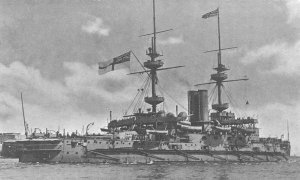
When World War I broke out Majestic, together with the rest of the squadron, was attached to the Channel Fleet during the early stages of the war before being detached for escort duties with Canadian troop convoys. She then had spells as a guard ship at the Nore and the Humber. In early 1915, she was dispatched to the Mediterranean for service in the Dardanelles Campaign. She participated in bombardments of Turkish forts and supported the Allied landings at Gallipoli. On 27 May 1915, she was torpedoed by a U-boat at Cape Helles, sinking with the loss of 49 men.
Design
Main article: Majestic-class battleship

Right elevation, deck plan, and hull section as depicted in Brassey's Naval Annual 1902
Majestic was 421 feet (128 m) long overall and had a beam of 75 ft (23 m) and a draft of 27 ft (8.2 m). She displaced up to 16,060 t (15,810 long tons; 17,700 short tons) at full combat load. Her propulsion system consisted of two 3-cylinder triple expansion engines powered by eight coal-fired cylindrical boilers. By 1907–1908, she was re-boilered with oil-fired models. Her engines provided a top speed of 16 knots (30 km/h; 18 mph) at 10,000 indicated horsepower (7,500 kW). The Majestics were considered good seaboats with an easy roll and good steamers, although they suffered from high fuel consumption. She had a crew of 672 officers and ratings.
The ship was armed with four BL 12-inch Mk VIII guns in twin-gun turrets, one forward and one aft. The turrets were placed on pear-shaped barbettes; six of her sisters had the same arrangement, but her sisters Caesar and Illustrious and all future British battleship classes had circular barbettes. Majestic also carried twelve QF 6-inch /40 guns. They were mounted in casemates in two gun decks amidships. She also carried sixteen QF 12-pounder guns and twelve QF 2-pounder guns. She was also equipped with five 18 in (460 mm) torpedo tubes, four of which were submerged in the ship's hull, with the last in a deck-mounted launcher.

Scale 1:48. A plan showing the inboard profile of the battleship HMS Majestic (1895). The plan shows the ship as completed in 1896, with subsequent alterations up to 1904

Scale 1:48. A plan showing the upper deck of the battleship HMS Majestic (1895). The plan shows the ship as completed in 1896, with subsequent alterations up to 1904
Majestic and the other ships of her class had 9 inches (229 mm) of Harvey armour, which allowed equal protection with less cost in weight compared to previous types of armour. This allowed Majestic and her sisters to have a deeper and lighter belt than previous battleships without any loss in protection. The barbettes for the main battery were protected with 14 in (360 mm) of armour, and the conning tower had the same thickness of steel on the sides. The ship's armoured deck was 2.5 to 4.5 in (64 to 114 mm) thick.
Operational history
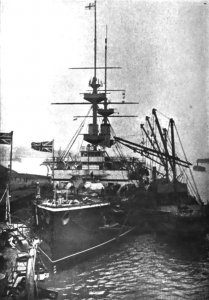
Majestic being coaled circa 1904
Majestic was laid down at the Portsmouth Dockyard in February 1894. She was launched on 31 January 1895, after which fitting-out work commenced. She was commissioned into the Royal Navy less than a year later, in December 1895, serving with the Channel Squadron at the Portsmouth division. She was present at the Fleet Review at Spithead for the Diamond Jubilee of Queen Victoria on 26 June 1897, and was later flagshipto Vice-Admiral Sir Harry Rawson, Commander-in-Chief of the Channel Fleet. Captain George Egerton was appointed in command on 28 June 1899, and paid off in April 1901, when Captain Edward Eden Bradfordwas appointed in command as she became the flagship of Rear-Admiral Arthur Wilson, who had been appointed Commander-in-Chief of the Channel Squadron. She took part in the Coronation Review held at Spithead for King Edward VII on 16 August 1902, and in September that year was head of a squadron visiting Nauplia and Souda Bay at Crete in the Mediterranean Sea. She underwent a refit at Portsmouth from February to July 1904, and then became a unit of the Atlantic Fleet when a reorganisation resulted in the Channel Fleet becoming the Atlantic Fleet in January 1905. On 1 October 1906, she paid off into reserve at Portsmouth.
Majestic recommissioned at Portsmouth on 26 February 1907 to become flagship of the Nore Division in the new Home Fleet, stationed at the Nore. She began a refit later that year in which she received radio and new fire control systems. When the flag was transferred to another ship in January 1908, she became a private ship in the Nore Division. In June 1908, Majestic transferred to the Devonport Division of the Home Fleet, stationed at Devonport. Her refit was completed in 1909, and in March 1909 she transferred to the 3rd Division at Devonport, then in August 1910 to the 4th Division at Devonport, where she underwent another refit in 1911. In May 1912, Majestic became part of the 7th Battle Squadron in the 3rd Fleet at Devonport. On 14 July 1912 she collided with her sister ship Victorious during manoeuvres, suffering no serious damage.
World War I
Upon the outbreak of World War I in August 1914, Majestic and the rest of the 7th Battle Squadron were assigned to the Channel Fleet. Majestic underwent a refit in August and September 1914, then covered the passage of the British Expeditionary Force to France in September 1914. She was detached from the 7th Battle Squadron from 3 October 1914 to 14 October 1914 to escort the first Canadian troop convoy. At the end of October 1914, Majestic was transferred to the Nore to serve as guard ship there. On 3 November 1914, she transferred to the Humber to serve as guard ship there. In December 1914 she became a unit of the Dover Patrol, and combined with battleship Revenge to bombard German coastal artillery from off of Nieuwpoort, Belgium, on 15 December 1914. In January 1915, she was based at Portland.
Dardanelles campaign
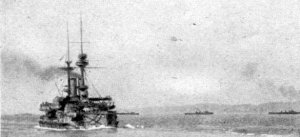
Majestic steaming out of Mudros harbour with several destroyers
In February 1915, Majestic was assigned to participate in the upcoming Dardanelles Campaign to open the Turkish Straits, and she departed early that month under the command of Captain H. F. G. Talbot to join the Mediterranean Fleet. Upon arriving at Malta, she was fitted with what was termed "mine-catching" gear so that she could serve as a "mine-bumper". She joined the Dardanelles force on 24 February 1915, and on 26 February 1915 departed Tenedos to bombard the Ottoman Turkish inner forts at the Dardanelles that morning. On 26 February 1915, Majestic and battleships Albion and Triumph became the first Allied heavy ships to enter the Turkish Straits during the campaign, firing on the inner forts from 0914 until 1740 hours. Majestic took a hit below the waterline, but was able to continue operations and patrolled the area again on 27 February 1915. She supported the early landings, shelling the forts from 1125 until 1645 hours on 1 March 1915 and again while patrolling on 3 March 1915. She arrived at Mudros on 8 March 1915.
On 9 March 1915, Majestic circumnavigated the entrance to the Dardanelles and bombarded Ottoman Turkish positions from 1007 until 1215 hours. She returned to Tenedos on 10 March 1915, patrolled off the Dardanelles again on 15 March 1915, and again returned to Tenedos on 16 March 1915. Majestic participated in the final attempt to force the straits by naval power alone on 18 March 1915. She opened fire on Fort 9 at 1420 hours and also engaged Turkish field guns hidden in woods. She shelled Fort 9 until she ceased fire at 18:35; the fort meanwhile fired on the mortally damaged battleship Ocean. Majestic was hit four times, twice in her lower tops and twice on her forecastle, and returned to Tenedos at 2200 hours with one dead and some wounded crew members. Majestic returned to patrol duties on 22 March 1915. She shelled Turkish positions on 28 March 1915 from 0950 to 1015 and from 1250 to 1340 hours and again opened fire on 14 April at 1458 hours. On 18 April, she fired on the abandoned British submarine E15 aground near Fort Dardanos and in danger of being captured; two picket boats, one from Majestic and one from Triumph, destroyed E15 with torpedoes, although the boat from Majestic was itself sunk by Turkish shore batteries while retiring. Majestic returned to Tenedos on 21 April 1915.
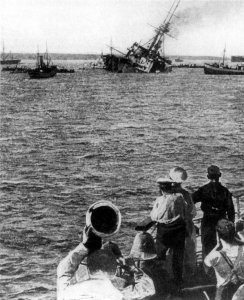
Majestic sinking at the Dardanelles, 27 May 1915
On 25 April 1915, Majestic was back in action, signalling London that Allied landings had begun at Gallipoli and supporting them with coastal bombardments until 1915 hours. She brought 99 wounded troops aboard at 2110 hours and recovered all her boats before anchoring off Gallipoli for the night. On 26 April 1915, she was back in action early, opening fire at 0617 hours. On 27 April 1915 she exchanged fire with Turkish guns, with several Turkish shells achieving very near misses before both sides ceased firing at 1130 hours. On 29 April 1915 she again was anchored off Gallipoli. Majestic relieved Triumph as flagship of Admiral Nicholson, commanding the squadrons supporting the troops ashore off Cape Helles, on 25 May 1915.
Loss
On 27 May 1915, while stationed off W Beach at Cape Helles, Majestic became the third battleship to be torpedoed off the Gallipoli peninsula in two weeks. Around 0645 hours, Commander Otto Hersing of the German submarine U-21fired a single torpedo through the defensive screen of destroyers and anti-torpedo nets, striking Majestic and causing a huge explosion. The ship began to list to port and in nine minutes had capsized in 54 feet (16 m) of water, killing 49 men. Her masts hit the mud of the sea bottom, and her upturned hull remained visible for many months until it was finally submerged when her foremast collapsed during a storm.
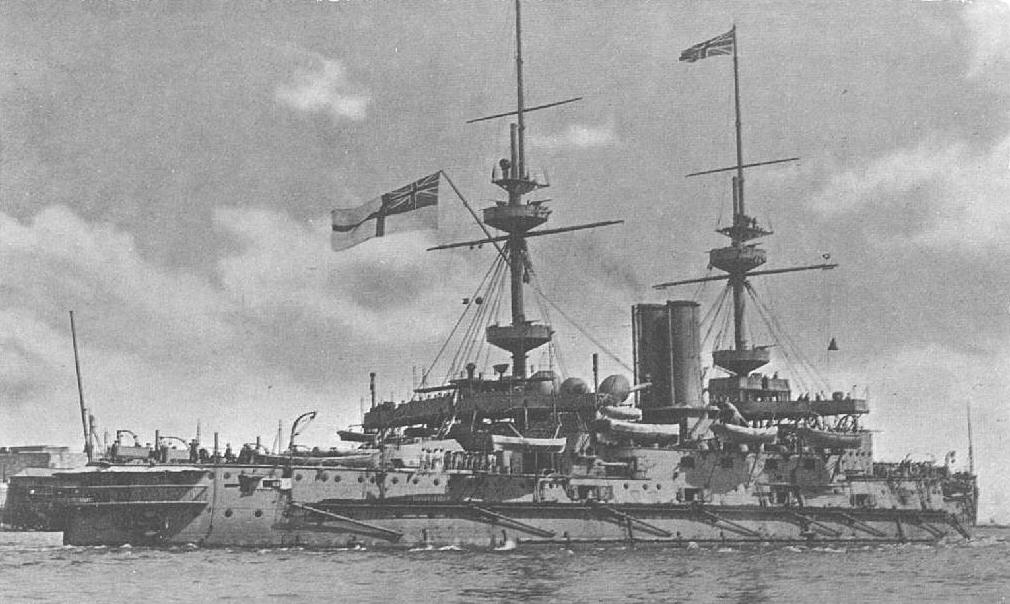
 en.wikipedia.org
en.wikipedia.org

 en.wikipedia.org
en.wikipedia.org
27 May 1915 - HMS Majestic – while stationed off W Beach at Cape Helles, Majestic became the third battleship to be torpedoed off Gallipoli in two weeks. SM fired one torpedo through the defensive screen of destroyers and anti-torpedo nets, hitting Majestic and causing a huge explosion. She began to list to port and in nine minutes capsized in 54 feet (16 m) of water killing 49 men. Her masts hit the mud of the sea bottom and her upturned hull remained visible for many months until it finally submerged when her foremast collapsed in a storm.
HMS Majestic was a Majestic-class pre-dreadnought battleship of the Royal Navy. Commissioned in 1895, she was the largest predreadnought launched at the time. She served with the Channel Fleet until 1904, following which she was assigned to the Atlantic Fleet. In 1907, she was part of the Home Fleet, firstly assigned to the Nore Division and then with the Devonport Division. From 1912, she was part of the 7th Battle Squadron.

When World War I broke out Majestic, together with the rest of the squadron, was attached to the Channel Fleet during the early stages of the war before being detached for escort duties with Canadian troop convoys. She then had spells as a guard ship at the Nore and the Humber. In early 1915, she was dispatched to the Mediterranean for service in the Dardanelles Campaign. She participated in bombardments of Turkish forts and supported the Allied landings at Gallipoli. On 27 May 1915, she was torpedoed by a U-boat at Cape Helles, sinking with the loss of 49 men.
Design
Main article: Majestic-class battleship

Right elevation, deck plan, and hull section as depicted in Brassey's Naval Annual 1902
Majestic was 421 feet (128 m) long overall and had a beam of 75 ft (23 m) and a draft of 27 ft (8.2 m). She displaced up to 16,060 t (15,810 long tons; 17,700 short tons) at full combat load. Her propulsion system consisted of two 3-cylinder triple expansion engines powered by eight coal-fired cylindrical boilers. By 1907–1908, she was re-boilered with oil-fired models. Her engines provided a top speed of 16 knots (30 km/h; 18 mph) at 10,000 indicated horsepower (7,500 kW). The Majestics were considered good seaboats with an easy roll and good steamers, although they suffered from high fuel consumption. She had a crew of 672 officers and ratings.
The ship was armed with four BL 12-inch Mk VIII guns in twin-gun turrets, one forward and one aft. The turrets were placed on pear-shaped barbettes; six of her sisters had the same arrangement, but her sisters Caesar and Illustrious and all future British battleship classes had circular barbettes. Majestic also carried twelve QF 6-inch /40 guns. They were mounted in casemates in two gun decks amidships. She also carried sixteen QF 12-pounder guns and twelve QF 2-pounder guns. She was also equipped with five 18 in (460 mm) torpedo tubes, four of which were submerged in the ship's hull, with the last in a deck-mounted launcher.

Scale 1:48. A plan showing the inboard profile of the battleship HMS Majestic (1895). The plan shows the ship as completed in 1896, with subsequent alterations up to 1904

Scale 1:48. A plan showing the upper deck of the battleship HMS Majestic (1895). The plan shows the ship as completed in 1896, with subsequent alterations up to 1904
Majestic and the other ships of her class had 9 inches (229 mm) of Harvey armour, which allowed equal protection with less cost in weight compared to previous types of armour. This allowed Majestic and her sisters to have a deeper and lighter belt than previous battleships without any loss in protection. The barbettes for the main battery were protected with 14 in (360 mm) of armour, and the conning tower had the same thickness of steel on the sides. The ship's armoured deck was 2.5 to 4.5 in (64 to 114 mm) thick.
Operational history

Majestic being coaled circa 1904
Majestic was laid down at the Portsmouth Dockyard in February 1894. She was launched on 31 January 1895, after which fitting-out work commenced. She was commissioned into the Royal Navy less than a year later, in December 1895, serving with the Channel Squadron at the Portsmouth division. She was present at the Fleet Review at Spithead for the Diamond Jubilee of Queen Victoria on 26 June 1897, and was later flagshipto Vice-Admiral Sir Harry Rawson, Commander-in-Chief of the Channel Fleet. Captain George Egerton was appointed in command on 28 June 1899, and paid off in April 1901, when Captain Edward Eden Bradfordwas appointed in command as she became the flagship of Rear-Admiral Arthur Wilson, who had been appointed Commander-in-Chief of the Channel Squadron. She took part in the Coronation Review held at Spithead for King Edward VII on 16 August 1902, and in September that year was head of a squadron visiting Nauplia and Souda Bay at Crete in the Mediterranean Sea. She underwent a refit at Portsmouth from February to July 1904, and then became a unit of the Atlantic Fleet when a reorganisation resulted in the Channel Fleet becoming the Atlantic Fleet in January 1905. On 1 October 1906, she paid off into reserve at Portsmouth.
Majestic recommissioned at Portsmouth on 26 February 1907 to become flagship of the Nore Division in the new Home Fleet, stationed at the Nore. She began a refit later that year in which she received radio and new fire control systems. When the flag was transferred to another ship in January 1908, she became a private ship in the Nore Division. In June 1908, Majestic transferred to the Devonport Division of the Home Fleet, stationed at Devonport. Her refit was completed in 1909, and in March 1909 she transferred to the 3rd Division at Devonport, then in August 1910 to the 4th Division at Devonport, where she underwent another refit in 1911. In May 1912, Majestic became part of the 7th Battle Squadron in the 3rd Fleet at Devonport. On 14 July 1912 she collided with her sister ship Victorious during manoeuvres, suffering no serious damage.
World War I
Upon the outbreak of World War I in August 1914, Majestic and the rest of the 7th Battle Squadron were assigned to the Channel Fleet. Majestic underwent a refit in August and September 1914, then covered the passage of the British Expeditionary Force to France in September 1914. She was detached from the 7th Battle Squadron from 3 October 1914 to 14 October 1914 to escort the first Canadian troop convoy. At the end of October 1914, Majestic was transferred to the Nore to serve as guard ship there. On 3 November 1914, she transferred to the Humber to serve as guard ship there. In December 1914 she became a unit of the Dover Patrol, and combined with battleship Revenge to bombard German coastal artillery from off of Nieuwpoort, Belgium, on 15 December 1914. In January 1915, she was based at Portland.
Dardanelles campaign

Majestic steaming out of Mudros harbour with several destroyers
In February 1915, Majestic was assigned to participate in the upcoming Dardanelles Campaign to open the Turkish Straits, and she departed early that month under the command of Captain H. F. G. Talbot to join the Mediterranean Fleet. Upon arriving at Malta, she was fitted with what was termed "mine-catching" gear so that she could serve as a "mine-bumper". She joined the Dardanelles force on 24 February 1915, and on 26 February 1915 departed Tenedos to bombard the Ottoman Turkish inner forts at the Dardanelles that morning. On 26 February 1915, Majestic and battleships Albion and Triumph became the first Allied heavy ships to enter the Turkish Straits during the campaign, firing on the inner forts from 0914 until 1740 hours. Majestic took a hit below the waterline, but was able to continue operations and patrolled the area again on 27 February 1915. She supported the early landings, shelling the forts from 1125 until 1645 hours on 1 March 1915 and again while patrolling on 3 March 1915. She arrived at Mudros on 8 March 1915.
On 9 March 1915, Majestic circumnavigated the entrance to the Dardanelles and bombarded Ottoman Turkish positions from 1007 until 1215 hours. She returned to Tenedos on 10 March 1915, patrolled off the Dardanelles again on 15 March 1915, and again returned to Tenedos on 16 March 1915. Majestic participated in the final attempt to force the straits by naval power alone on 18 March 1915. She opened fire on Fort 9 at 1420 hours and also engaged Turkish field guns hidden in woods. She shelled Fort 9 until she ceased fire at 18:35; the fort meanwhile fired on the mortally damaged battleship Ocean. Majestic was hit four times, twice in her lower tops and twice on her forecastle, and returned to Tenedos at 2200 hours with one dead and some wounded crew members. Majestic returned to patrol duties on 22 March 1915. She shelled Turkish positions on 28 March 1915 from 0950 to 1015 and from 1250 to 1340 hours and again opened fire on 14 April at 1458 hours. On 18 April, she fired on the abandoned British submarine E15 aground near Fort Dardanos and in danger of being captured; two picket boats, one from Majestic and one from Triumph, destroyed E15 with torpedoes, although the boat from Majestic was itself sunk by Turkish shore batteries while retiring. Majestic returned to Tenedos on 21 April 1915.

Majestic sinking at the Dardanelles, 27 May 1915
On 25 April 1915, Majestic was back in action, signalling London that Allied landings had begun at Gallipoli and supporting them with coastal bombardments until 1915 hours. She brought 99 wounded troops aboard at 2110 hours and recovered all her boats before anchoring off Gallipoli for the night. On 26 April 1915, she was back in action early, opening fire at 0617 hours. On 27 April 1915 she exchanged fire with Turkish guns, with several Turkish shells achieving very near misses before both sides ceased firing at 1130 hours. On 29 April 1915 she again was anchored off Gallipoli. Majestic relieved Triumph as flagship of Admiral Nicholson, commanding the squadrons supporting the troops ashore off Cape Helles, on 25 May 1915.
Loss
On 27 May 1915, while stationed off W Beach at Cape Helles, Majestic became the third battleship to be torpedoed off the Gallipoli peninsula in two weeks. Around 0645 hours, Commander Otto Hersing of the German submarine U-21fired a single torpedo through the defensive screen of destroyers and anti-torpedo nets, striking Majestic and causing a huge explosion. The ship began to list to port and in nine minutes had capsized in 54 feet (16 m) of water, killing 49 men. Her masts hit the mud of the sea bottom, and her upturned hull remained visible for many months until it was finally submerged when her foremast collapsed during a storm.

HMS Majestic (1895) - Wikipedia

Majestic-class battleship - Wikipedia
Today in Naval History - Naval / Maritime Events in History
27 May 1941 - After being hunted by British forces following the sinking of HMS Hood, german battleship Bismarck was herself sunk three days later
Of the more than 2,200 crew aboard, over 2,000 were killed, 114 survived.
The last battle of the German battleship Bismarck took place in the Atlantic Ocean approximately 300 nmi (350 mi; 560 km) west of Brest, France, on 26–27 May 1941. Although it was a decisive action between capital ships, it has no generally accepted name.
On 24 May, before the final action, Bismarck's fuel tanks were damaged and several machinery compartments, including a boiler room, were flooded in the Battle of the Denmark Strait. Her intention was to reach the port of Brest for repair. Late in the day Bismarck briefly turned on her pursuers (Prince of Wales and the heavy cruisers Norfolk and Suffolk) to cover the escape of her companion, the heavy cruiser Prinz Eugen to continue further into the Atlantic. Early on 25 May the British forces lost contact with Bismarck, which headed ESE towards France while the British searched NE, presuming she was returning to Norway. Later on 25 May Admiral Lütjens, apparently unaware that he had lost his pursuers, broke radio silence to send a coded message to Germany. This allowed the British to triangulate the approximate position of the Bismarck and aircraft were dispatched to hunt for the German battleship. She was rediscovered in the late morning of 26 May by a Catalina flying boat from No. 209 Squadron RAF and subsequently shadowed by aircraft from Force H steaming north from Gibraltar.
The final action consisted of four main phases. The first phase late on the 26th consisted of air strikes by torpedo bombers from the British aircraft carrier Ark Royal, which disabled Bismarck's steering gear, jamming her rudders in a turning position and preventing her escape. The second phase was the shadowing and harassment of Bismarck during the night of 26/27 May by British destroyers, with no serious damage to any ship. The third phase on the morning of 27 May was an attack by the British battleships King George V and Rodney supported by cruisers. After about 100 minutes of fighting, Bismarck was sunk by the combined effects of shellfire, torpedo hits and deliberate scuttling. On the British side, Rodney was lightly damaged by near-misses and by the blast effects of her own guns. British warships rescued 111 survivors from Bismarck before being obliged to withdraw because of an apparent U-boat sighting, leaving several hundred men to their fate. The following morning, a U-boat and a German weathership rescued five more survivors. In the final phase the withdrawing British ships were attacked on 27 May by aircraft of the Luftwaffe, resulting in the loss of the destroyer HMS Mashona.
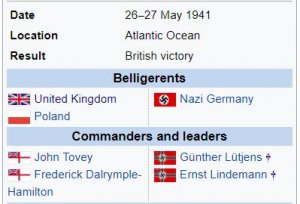
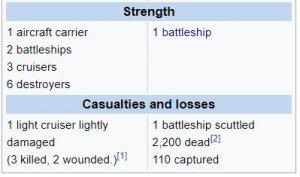
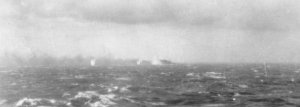
The Final Battle, 27 May 1941. Surrounded by shell splashes, Bismarck burns on the horizon.
Night of 26/27 May
At dusk that evening, and in atrocious weather conditions, Swordfish from Ark Royal launched an attack. The first wave mistakenly targeted Sheffield which had been detached from Force H under orders to close and shadow Bismarck. Although precious time was lost by this incident, it proved beneficial to the British in that the magnetic detonators on the torpedoes used against Sheffield were seen to be defective and for the following attack on Bismarck were replaced by those designed to explode on contact. Despite the lateness of the day, it was decided to try again. The attack commenced in near darkness at around 21:00 but once again the Swordfish torpedo bombers found Bismarck with their ASV II radars. A hit by a single torpedo from a Swordfish, hitting her port side, jammed Bismarck's rudder and steering gear 12° to port. This resulted in her being, initially, able to steam only in a large circle. Repair efforts by the crew to free the rudder failed. Bismarck attempted to steer by alternating the power of her three propeller shafts, which, in the prevailing force 8 wind and sea state, resulted in the ship being forced to sail towards King George V and Rodney, two British battleships that had been pursuing Bismarck from the west. At 23:40 on 26 May, Admiral Lütjens delivered to Group West, the German command base, the signal "Ship unmanoeuvrable. We will fight to the last shell. Long live the Führer."
Throughout that night, Bismarck was the target of intermittent torpedo attacks by the Tribal-class destroyers HMS Cossack, Sikh, Maori and Zulu, and the Polish destroyer ORP Piorun. Neither side scored a hit, but the constant worrying tactics of the British helped wear down the morale of the Germans and deepened the fatigue of an already exhausted crew.
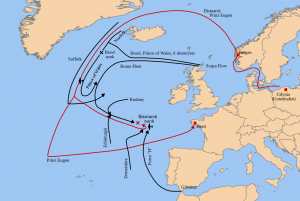
Map of Operation "Rheinübung" and Royal Navy operations against the battleship Bismarck
The sinking of Bismarck
The morning of Tuesday 27 May 1941 brought a heavy grey sky, a rising sea and a tearing wind from the northwest. Because of this northwesterly gale, Admiral Tovey concluded an attack on Bismarck from windward was undesirable. He decided to approach on a northwesterly bearing. Provided the enemy continued steering northward, he would deploy to the south on an opposite course at a range of approximately 15,000 yd (14,000 m). Bismarck was sighted bearing 118° at a distance of 25,000 yd (23,000 m).
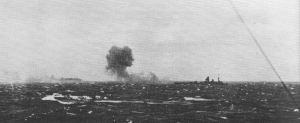
Rodney firing on Bismarck, which can be seen burning in the distance
Rodney and King George V drew closer to Bismarck in line abreast, their enemy well illuminated by the morning sun in the background. Rodney steered to the east so that her gunfire would work the length of Bismarck, while King George V took the side. They opened fire at 08:47. Bismarck returned fire, but her inability to steer and her list to port severely affected her shooting accuracy. Her low speed of 11 kn (13 mph; 20 km/h) also made her an easy target and she was soon hit several times by the large guns of the British battleships, with the heavy cruisers Norfolk and Dorsetshire adding their firepower later, after Bismarck's heavy guns had all been put out of action. One 16-inch (406 mm) salvo from Rodney destroyed the forward control post, killing most of the senior officers, while other salvoes destroyed all four gun turrets. Within 30 minutes, Bismarck's guns had all been silenced, and the ship was even lower in the water. Rodney now closed to point-blank range (approximately 3 km (1.9 mi)) to fire into the superstructure while King George V fired from further out; so her fire would strike Bismarck from a more vertical angle and be more likely to penetrate the decks.
Bismarck continued to fly her ensign. The battleship's upper works were almost completely destroyed and although her engines were still functioning, she was slowly settling by the stern from uncontrolled flooding with a 20-degree list to port. She no longer had any functioning guns, so First Officer Hans Oels ordered the men below decks to abandon ship; he instructed the engine-room crews to open the ship's watertight doors and prepare scuttling charges. Gerhard Junack, the chief engineering officer, primed the charges and ordered the crew to abandon the ship. Junack and his comrades heard the demolition charges detonate as they made their way up through the various levels. Most of the crew went into the water, but few sailors from the lower engine spaces got out alive.
With no sign of surrender, despite the unequal struggle, the British were loath to leave Bismarck. Their fuel and shell supplies were low – a demonstration of how difficult it was for a battleship to sink a similar unit even in an unbalanced engagement. However, when it became obvious that their enemy could not reach port, Rodney, King George V and the destroyers were sent home. Norfolk had used her last torpedoes; therefore, Dorsetshire launched three torpedoes at a comparatively short range, at least one of which impacted on the superstructure as Bismarck was already largely underwater. Bismarckwent under the waves at 10:39 that morning.
Dorsetshire and Maori attempted to rescue survivors, but a U-boat alarm caused them to leave the scene after having rescued only 111 Bismarck sailors, abandoning the majority of Bismarck's survivors from the 2,200-man crew (around 800) to the mercy of the water. The next morning, U-74, dispatched to try to rescue Bismarck’s logbook (and which heard sinking noises from a distance), picked up three survivors and the German weather ship Sachsenwald picked up two survivors.
Aftermath
After the sinking, Admiral John Tovey said, "The Bismarck had put up a most gallant fight against impossible odds worthy of the old days of the Imperial German Navy, and she went down with her colours flying."
The Board of the Admiralty issued a message of thanks to those involved:
After the battle, the British warships returned to the United Kingdom with 111 Bismarck survivors. One died later of his wounds. After a period of interrogation and processing, the survivors spent the rest of the war as prisoners. No British ship was sunk during this action, but the destroyer HMS Mashona was sunk by the Luftwaffe during the withdrawal the following day.
Several Bismarck survivors spoke afterwards of a sailor on the Dorsetshire, Midshipman Joe Brooks, who tried to jump into the water to rescue a German sailor who had lost his arms. In a 1989 National Geographic documentary on the Bismarck, one of the survivors said, "the name Joe Brooks meant something to us; our government should've given that man a medal for humaneness."
Order of battle
Axis
Unsinkable Sam (also known as Oskar or Oscar) is the nickname of a real or fictitious cat, reportedly in service as a ship's cat during World War II both in the Kriegsmarine and the Royal Navy, surviving the sinking of three ships in total.
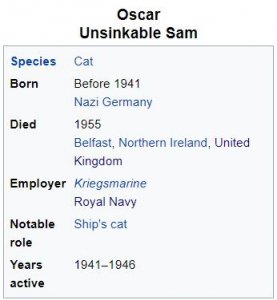
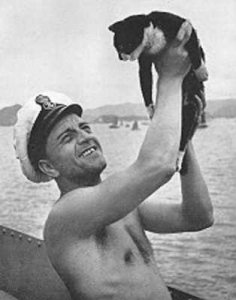

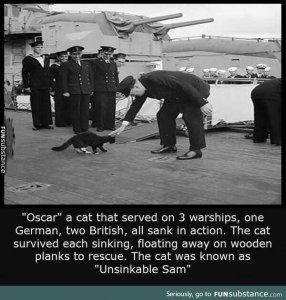
History
The cat's original name is unknown. The name "Oscar" was given by the crew of the British destroyer HMS Cossack that rescued him from the sea following the sinking of the German battleship Bismarck. "Oscar" was derived from the International Code of Signals for the letter 'O', which is code for "Man Overboard" (the German spelling, "Oskar", was sometimes used since he was a "German" cat).
Bismarck

Bismarck
The black and white patched cat was supposedly owned by an unknown crewman of the German battleship Bismarck and was on board the ship on 18 May 1941 when she set sail on Operation Rheinübung (German for Rhine Exercise), Bismarck's only mission. Bismarck was sunk after a fierce sea-battle on 27 May, from which only 115 from her crew of over 2,100 survived. Hours later, Oscar was found floating on a board and picked from the water by the British destroyer HMS Cossack. Unaware of what his name had been on Bismarck, the crew of Cossack named their new mascot "Oscar".
HMS Cossack

HMS Cossack
The cat served on board Cossack for the next few months as the ship carried out convoy escort duties in the Mediterranean Sea and north Atlantic Ocean. On 24 October 1941, Cossack was escorting a convoy from Gibraltar to Great Britain when she was severely damaged by a torpedo fired by the German submarine U-563. Crew were transferred to the destroyer HMS Legion, and an attempt was made to tow the badly listing Cossack back to Gibraltar. However, worsening weather conditions meant the task became impossible and had to be abandoned. On 27 October, a day after the tow was slipped, Cossack sank to the west of Gibraltar. The initial explosion had blown off one third of the forward section of the ship, killing 159 of the crew, but Oscar survived this too and was brought to the shore establishment in Gibraltar.
HMS Ark Royal
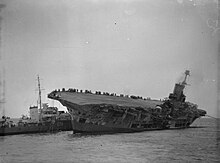
HMS Ark Royal sinking
Now nicknamed "Unsinkable Sam", the cat was soon transferred to the aircraft carrier HMS Ark Royal, which coincidentally had been instrumental in the destruction of Bismarck (along with Cossack). However, Sam was to find no more luck there, and when returning from Malta on 14 November 1941 this ship too was torpedoed, this time by U-81. Attempts were also made to tow Ark Royal to Gibraltar, but the unstoppable inflow of water made the task futile. The carrier rolled over and sank 30 miles from Gibraltar. The slow rate at which the ship sank meant that all but one of the crew could be saved. The survivors, including Sam, who had been found clinging to a floating plank by a motor launch and described as "angry but quite unharmed", were transferred to HMS Lightning and the same HMS Legion which had rescued the crew of Cossack. Legion would itself be sunk in 1942, and Lightning in 1943.
The loss of Ark Royal proved the end of Sam's shipborne career. He was transferred first to the offices of the Governor of Gibraltar and then sent back to the United Kingdom, where he saw out the remainder of the war living in a seaman's home in Belfast called the "Home for Sailors". Sam died in 1955. A pastel portrait of Sam (titled Oscar, the Bismarck's Cat) by the artist Georgina Shaw-Baker is in the possession of the National Maritime Museum in Greenwich.
Historicity
Some authorities question whether Oskar/Sam's biography might be a "sea story", because – for example – there are pictures of two different cats identified as Oskar/Sam. The sinking of Bismarck and rescue of a limited number of survivors took place in desperate conditions; British ships were ordered not to stop as there was believed to be a U-boat in the area, and many survivors were left to die of exposure. Pointedly, there is no mention of this incident in Ludovic Kennedy's detailed account of the sinking, suggesting that information later gleaned from sailors regarding the cat's true service were apocryphal.

 en.wikipedia.org
https://en.wikipedia.org/wiki/Last_battle_of_the_battleship_Bismarck
en.wikipedia.org
https://en.wikipedia.org/wiki/Last_battle_of_the_battleship_Bismarck

 en.wikipedia.org
en.wikipedia.org
27 May 1941 - After being hunted by British forces following the sinking of HMS Hood, german battleship Bismarck was herself sunk three days later
Of the more than 2,200 crew aboard, over 2,000 were killed, 114 survived.
The last battle of the German battleship Bismarck took place in the Atlantic Ocean approximately 300 nmi (350 mi; 560 km) west of Brest, France, on 26–27 May 1941. Although it was a decisive action between capital ships, it has no generally accepted name.
On 24 May, before the final action, Bismarck's fuel tanks were damaged and several machinery compartments, including a boiler room, were flooded in the Battle of the Denmark Strait. Her intention was to reach the port of Brest for repair. Late in the day Bismarck briefly turned on her pursuers (Prince of Wales and the heavy cruisers Norfolk and Suffolk) to cover the escape of her companion, the heavy cruiser Prinz Eugen to continue further into the Atlantic. Early on 25 May the British forces lost contact with Bismarck, which headed ESE towards France while the British searched NE, presuming she was returning to Norway. Later on 25 May Admiral Lütjens, apparently unaware that he had lost his pursuers, broke radio silence to send a coded message to Germany. This allowed the British to triangulate the approximate position of the Bismarck and aircraft were dispatched to hunt for the German battleship. She was rediscovered in the late morning of 26 May by a Catalina flying boat from No. 209 Squadron RAF and subsequently shadowed by aircraft from Force H steaming north from Gibraltar.
The final action consisted of four main phases. The first phase late on the 26th consisted of air strikes by torpedo bombers from the British aircraft carrier Ark Royal, which disabled Bismarck's steering gear, jamming her rudders in a turning position and preventing her escape. The second phase was the shadowing and harassment of Bismarck during the night of 26/27 May by British destroyers, with no serious damage to any ship. The third phase on the morning of 27 May was an attack by the British battleships King George V and Rodney supported by cruisers. After about 100 minutes of fighting, Bismarck was sunk by the combined effects of shellfire, torpedo hits and deliberate scuttling. On the British side, Rodney was lightly damaged by near-misses and by the blast effects of her own guns. British warships rescued 111 survivors from Bismarck before being obliged to withdraw because of an apparent U-boat sighting, leaving several hundred men to their fate. The following morning, a U-boat and a German weathership rescued five more survivors. In the final phase the withdrawing British ships were attacked on 27 May by aircraft of the Luftwaffe, resulting in the loss of the destroyer HMS Mashona.



The Final Battle, 27 May 1941. Surrounded by shell splashes, Bismarck burns on the horizon.
Night of 26/27 May
At dusk that evening, and in atrocious weather conditions, Swordfish from Ark Royal launched an attack. The first wave mistakenly targeted Sheffield which had been detached from Force H under orders to close and shadow Bismarck. Although precious time was lost by this incident, it proved beneficial to the British in that the magnetic detonators on the torpedoes used against Sheffield were seen to be defective and for the following attack on Bismarck were replaced by those designed to explode on contact. Despite the lateness of the day, it was decided to try again. The attack commenced in near darkness at around 21:00 but once again the Swordfish torpedo bombers found Bismarck with their ASV II radars. A hit by a single torpedo from a Swordfish, hitting her port side, jammed Bismarck's rudder and steering gear 12° to port. This resulted in her being, initially, able to steam only in a large circle. Repair efforts by the crew to free the rudder failed. Bismarck attempted to steer by alternating the power of her three propeller shafts, which, in the prevailing force 8 wind and sea state, resulted in the ship being forced to sail towards King George V and Rodney, two British battleships that had been pursuing Bismarck from the west. At 23:40 on 26 May, Admiral Lütjens delivered to Group West, the German command base, the signal "Ship unmanoeuvrable. We will fight to the last shell. Long live the Führer."
Throughout that night, Bismarck was the target of intermittent torpedo attacks by the Tribal-class destroyers HMS Cossack, Sikh, Maori and Zulu, and the Polish destroyer ORP Piorun. Neither side scored a hit, but the constant worrying tactics of the British helped wear down the morale of the Germans and deepened the fatigue of an already exhausted crew.

Map of Operation "Rheinübung" and Royal Navy operations against the battleship Bismarck
The sinking of Bismarck
The morning of Tuesday 27 May 1941 brought a heavy grey sky, a rising sea and a tearing wind from the northwest. Because of this northwesterly gale, Admiral Tovey concluded an attack on Bismarck from windward was undesirable. He decided to approach on a northwesterly bearing. Provided the enemy continued steering northward, he would deploy to the south on an opposite course at a range of approximately 15,000 yd (14,000 m). Bismarck was sighted bearing 118° at a distance of 25,000 yd (23,000 m).

Rodney firing on Bismarck, which can be seen burning in the distance
Rodney and King George V drew closer to Bismarck in line abreast, their enemy well illuminated by the morning sun in the background. Rodney steered to the east so that her gunfire would work the length of Bismarck, while King George V took the side. They opened fire at 08:47. Bismarck returned fire, but her inability to steer and her list to port severely affected her shooting accuracy. Her low speed of 11 kn (13 mph; 20 km/h) also made her an easy target and she was soon hit several times by the large guns of the British battleships, with the heavy cruisers Norfolk and Dorsetshire adding their firepower later, after Bismarck's heavy guns had all been put out of action. One 16-inch (406 mm) salvo from Rodney destroyed the forward control post, killing most of the senior officers, while other salvoes destroyed all four gun turrets. Within 30 minutes, Bismarck's guns had all been silenced, and the ship was even lower in the water. Rodney now closed to point-blank range (approximately 3 km (1.9 mi)) to fire into the superstructure while King George V fired from further out; so her fire would strike Bismarck from a more vertical angle and be more likely to penetrate the decks.
Bismarck continued to fly her ensign. The battleship's upper works were almost completely destroyed and although her engines were still functioning, she was slowly settling by the stern from uncontrolled flooding with a 20-degree list to port. She no longer had any functioning guns, so First Officer Hans Oels ordered the men below decks to abandon ship; he instructed the engine-room crews to open the ship's watertight doors and prepare scuttling charges. Gerhard Junack, the chief engineering officer, primed the charges and ordered the crew to abandon the ship. Junack and his comrades heard the demolition charges detonate as they made their way up through the various levels. Most of the crew went into the water, but few sailors from the lower engine spaces got out alive.
With no sign of surrender, despite the unequal struggle, the British were loath to leave Bismarck. Their fuel and shell supplies were low – a demonstration of how difficult it was for a battleship to sink a similar unit even in an unbalanced engagement. However, when it became obvious that their enemy could not reach port, Rodney, King George V and the destroyers were sent home. Norfolk had used her last torpedoes; therefore, Dorsetshire launched three torpedoes at a comparatively short range, at least one of which impacted on the superstructure as Bismarck was already largely underwater. Bismarckwent under the waves at 10:39 that morning.
Dorsetshire and Maori attempted to rescue survivors, but a U-boat alarm caused them to leave the scene after having rescued only 111 Bismarck sailors, abandoning the majority of Bismarck's survivors from the 2,200-man crew (around 800) to the mercy of the water. The next morning, U-74, dispatched to try to rescue Bismarck’s logbook (and which heard sinking noises from a distance), picked up three survivors and the German weather ship Sachsenwald picked up two survivors.
Aftermath
After the sinking, Admiral John Tovey said, "The Bismarck had put up a most gallant fight against impossible odds worthy of the old days of the Imperial German Navy, and she went down with her colours flying."
The Board of the Admiralty issued a message of thanks to those involved:
Unaware of the fate of the ship, Group West, the German command base, continued to issue signals to Bismarck for some hours, until Reuters reported news from Britain that the ship had been sunk. In Britain, the House of Commons was informed of the sinking early that afternoon.Their Lordships congratulate C.-in-C., Home Fleet, and all concerned in the unrelenting pursuit and successful destruction of the enemy's most powerful warship. The loss of H.M.S. Hood and her company, which is so deeply regretted, has thus been avenged and the Atlantic made more secure for our trade and that of our allies.
From the information at present available to Their Lordships there can be no doubt that had it not been for the gallantry, skill, and devotion to duty of the Fleet Air Arm in both Victorious and Ark Royal, our object might not have been achieved.
After the battle, the British warships returned to the United Kingdom with 111 Bismarck survivors. One died later of his wounds. After a period of interrogation and processing, the survivors spent the rest of the war as prisoners. No British ship was sunk during this action, but the destroyer HMS Mashona was sunk by the Luftwaffe during the withdrawal the following day.
Several Bismarck survivors spoke afterwards of a sailor on the Dorsetshire, Midshipman Joe Brooks, who tried to jump into the water to rescue a German sailor who had lost his arms. In a 1989 National Geographic documentary on the Bismarck, one of the survivors said, "the name Joe Brooks meant something to us; our government should've given that man a medal for humaneness."
Order of battle
Axis
- German battleship Bismarck
- The British battleships King George V and Rodney.
- The British aircraft carrier Ark Royal
- The British heavy cruisers Norfolk and Dorsetshire.
- The British light cruiser Sheffield.
- The British destroyers Cossack, Sikh, Zulu, Maori, Mashona, Tartar
- The Polish destroyer ORP Piorun
- Spanish heavy cruiser Canarias (attempted to rescue some survivors from Bismarck)
Unsinkable Sam (also known as Oskar or Oscar) is the nickname of a real or fictitious cat, reportedly in service as a ship's cat during World War II both in the Kriegsmarine and the Royal Navy, surviving the sinking of three ships in total.




History
The cat's original name is unknown. The name "Oscar" was given by the crew of the British destroyer HMS Cossack that rescued him from the sea following the sinking of the German battleship Bismarck. "Oscar" was derived from the International Code of Signals for the letter 'O', which is code for "Man Overboard" (the German spelling, "Oskar", was sometimes used since he was a "German" cat).
Bismarck

Bismarck
The black and white patched cat was supposedly owned by an unknown crewman of the German battleship Bismarck and was on board the ship on 18 May 1941 when she set sail on Operation Rheinübung (German for Rhine Exercise), Bismarck's only mission. Bismarck was sunk after a fierce sea-battle on 27 May, from which only 115 from her crew of over 2,100 survived. Hours later, Oscar was found floating on a board and picked from the water by the British destroyer HMS Cossack. Unaware of what his name had been on Bismarck, the crew of Cossack named their new mascot "Oscar".
HMS Cossack

HMS Cossack
The cat served on board Cossack for the next few months as the ship carried out convoy escort duties in the Mediterranean Sea and north Atlantic Ocean. On 24 October 1941, Cossack was escorting a convoy from Gibraltar to Great Britain when she was severely damaged by a torpedo fired by the German submarine U-563. Crew were transferred to the destroyer HMS Legion, and an attempt was made to tow the badly listing Cossack back to Gibraltar. However, worsening weather conditions meant the task became impossible and had to be abandoned. On 27 October, a day after the tow was slipped, Cossack sank to the west of Gibraltar. The initial explosion had blown off one third of the forward section of the ship, killing 159 of the crew, but Oscar survived this too and was brought to the shore establishment in Gibraltar.
HMS Ark Royal

HMS Ark Royal sinking
Now nicknamed "Unsinkable Sam", the cat was soon transferred to the aircraft carrier HMS Ark Royal, which coincidentally had been instrumental in the destruction of Bismarck (along with Cossack). However, Sam was to find no more luck there, and when returning from Malta on 14 November 1941 this ship too was torpedoed, this time by U-81. Attempts were also made to tow Ark Royal to Gibraltar, but the unstoppable inflow of water made the task futile. The carrier rolled over and sank 30 miles from Gibraltar. The slow rate at which the ship sank meant that all but one of the crew could be saved. The survivors, including Sam, who had been found clinging to a floating plank by a motor launch and described as "angry but quite unharmed", were transferred to HMS Lightning and the same HMS Legion which had rescued the crew of Cossack. Legion would itself be sunk in 1942, and Lightning in 1943.
The loss of Ark Royal proved the end of Sam's shipborne career. He was transferred first to the offices of the Governor of Gibraltar and then sent back to the United Kingdom, where he saw out the remainder of the war living in a seaman's home in Belfast called the "Home for Sailors". Sam died in 1955. A pastel portrait of Sam (titled Oscar, the Bismarck's Cat) by the artist Georgina Shaw-Baker is in the possession of the National Maritime Museum in Greenwich.
Historicity
Some authorities question whether Oskar/Sam's biography might be a "sea story", because – for example – there are pictures of two different cats identified as Oskar/Sam. The sinking of Bismarck and rescue of a limited number of survivors took place in desperate conditions; British ships were ordered not to stop as there was believed to be a U-boat in the area, and many survivors were left to die of exposure. Pointedly, there is no mention of this incident in Ludovic Kennedy's detailed account of the sinking, suggesting that information later gleaned from sailors regarding the cat's true service were apocryphal.

German battleship Bismarck - Wikipedia

Unsinkable Sam - Wikipedia
Today in Naval History - Naval / Maritime Events in History
27 May 1941 - German battleship Bismarck was scuttled by her crew, and sank with heavy loss of life
Part I
Bismarck was the first of two Bismarck-class battleships built for Nazi Germany's Kriegsmarine. Named after Chancellor Otto von Bismarck, the ship was laid down at the Blohm & Voss shipyard in Hamburg in July 1936 and launched in February 1939. Work was completed in August 1940, when she was commissioned into the German fleet. Bismarck and her sister ship Tirpitz were the largest battleships ever built by Germany, and two of the largest built by any European power.
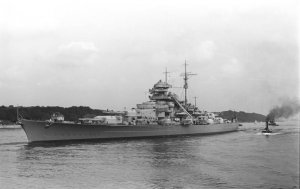
In the course of the warship's eight-month career under its sole commanding officer, Captain Ernst Lindemann, Bismarck conducted only one offensive operation, lasting 8 days in May 1941, codenamed Rheinübung. The ship, along with the heavy cruiser Prinz Eugen, was to break into the Atlantic Ocean and raid Allied shipping from North America to Great Britain. The two ships were detected several times off Scandinavia, and British naval units were deployed to block their route. At the Battle of the Denmark Strait, the battlecruiser HMS Hood initially engaged Prinz Eugen, probably by mistake, while HMS Prince of Wales engaged Bismarck. In the ensuing battle Hood was destroyed by the combined fire of Bismarck and Prinz Eugen, which then damaged Prince of Wales and forced her retreat. Bismarck suffered sufficient damage from three hits to force an end to the raiding mission.
The destruction of Hood spurred a relentless pursuit by the Royal Navy involving dozens of warships. Two days later, heading for occupied France to effect repairs, Bismarck was attacked by 16 obsolescent Fairey Swordfish biplane torpedo bombers from the aircraft carrier HMS Ark Royal; one scored a hit that rendered the battleship's steering gear inoperable. In her final battle the following morning, the already-crippled Bismarck was severely damaged during a sustained engagement with two British battleships and two heavy cruisers, was scuttled by her crew, and sank with heavy loss of life. Most experts agree that the battle damage would have caused her to sink eventually. The wreck was located in June 1989 by Robert Ballard, and has since been further surveyed by several other expeditions.
Characteristics
Main article: Bismarck-class battleship
The two Bismarck-class battleships were designed in the mid-1930s by the German Kriegsmarine as a counter to French naval expansion, specifically the two Richelieu-class battleships France had started in 1935. Laid down after the signing of the Anglo-German Naval Agreement of 1935, Bismarck and her sister Tirpitz were nominally within the 35,000-long-ton (36,000 t) limit imposed by the Washington regime that governed battleship construction in the interwar period. The ships secretly exceeded the figure by a wide margin, though before either vessel was completed, the international treaty system had fallen apart following Japan's withdrawal in 1937, allowing signatories to invoke an "escalator clause" that permitted displacements as high as 45,000 long tons (46,000 t).
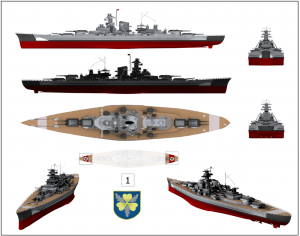
3D rendering of Bismarck based on its configuration during Operation Rheinübung
Bismarck displaced 41,700 t (41,000 long tons) as built and 50,300 t (49,500 long tons) fully loaded, with an overall length of 251 m (823 ft 6 in), a beam of 36 m (118 ft 1 in) and a maximum draft of 9.9 m (32 ft 6 in). The battleship was Germany's largest warship, and displaced more than any other European battleship, with the exception of HMS Vanguard, commissioned after the end of the war.[5] Bismarck was powered by three Blohm & Voss geared steam turbines and twelve oil-fired Wagner superheated boilers, which developed a total of 148,116 shp (110,450 kW) and yielded a maximum speed of 30.01 knots (55.58 km/h; 34.53 mph) on speed trials. The ship had a cruising range of 8,870 nautical miles (16,430 km; 10,210 mi) at 19 knots (35 km/h; 22 mph). Bismarck was equipped with three FuMO 23 search radar sets, mounted on the forward and stern rangefinders and foretop.
The standard crew numbered 103 officers and 1,962 enlisted men. The crew was divided into twelve divisions of between 180 and 220 men. The first six divisions were assigned to the ship's armament, divisions one to four for the main and secondary batteries and five and six manning anti-aircraft guns. The seventh division consisted of specialists, including cooks and carpenters, and the eighth division consisted of ammunition handlers. The radio operators, signalmen, and quartermasters were assigned to the ninth division. The last three divisions were the engine room personnel. When Bismarck left port, fleet staff, prize crews, and war correspondents increased the crew complement to over 2,200 men. Roughly 200 of the engine room personnel came from the light cruiser Karlsruhe, which had been lost during Operation Weserübung, the German invasion of Norway. Bismarck's crew published a ship's newspaper titled Die Schiffsglocke (The Ship's Bell); this paper was only published once, on 23 April 1941, by the commander of the engineering department, Gerhard Junack.
Bismarck was armed with eight 38 cm (15 in) SK C/34 guns arranged in four twin gun turrets: two super-firing turrets forward—"Anton" and "Bruno"—and two aft—"Caesar" and "Dora". Secondary armament consisted of twelve 15 cm (5.9 in) L/55 guns, sixteen 10.5 cm (4.1 in) L/65 and sixteen 3.7 cm (1.5 in) L/83, and twelve 2 cm (0.79 in) anti-aircraft guns. Bismarck also carried four Arado Ar 196 reconnaissance floatplanes, with a single large hangar and a double-ended catapult. The ship's main belt was 320 mm (12.6 in) thick and was covered by a pair of upper and main armoured decks that were 50 mm (2.0 in) and 100 to 120 mm (3.9 to 4.7 in) thick, respectively. The 38 cm (15 in) turrets were protected by 360 mm (14.2 in) thick faces and 220 mm (8.7 in) thick sides.
Service history
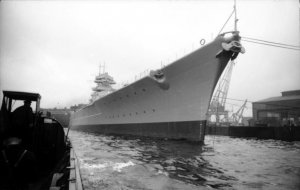
Bismarck in port in Hamburg
Bismarck was ordered under the name Ersatz Hannover ("Hannover replacement"), a replacement for the old pre-dreadnought SMS Hannover, under contract "F".The contract was awarded to the Blohm & Voss shipyard in Hamburg, where the keel was laid on 1 July 1936 at Helgen IX. The ship was launched on 14 February 1939 and during the elaborate ceremonies was christened by Dorothee von Löwenfeld, granddaughter of Chancellor Otto von Bismarck, the ship's namesake. Adolf Hitler made the christening speech. Fitting-out work followed the launch, during which time the original straight stem was replaced with a raked "Atlantic bow" similar to those of the Scharnhorst-class battleships. Bismarck was commissioned into the fleet on 24 August 1940 for sea trials, which were conducted in the Baltic. Kapitän zur See Ernst Lindemann took command of the ship at the time of commissioning.
On 15 September 1940, three weeks after commissioning, Bismarck left Hamburg to begin sea trials in Kiel Bay. Sperrbrecher 13 escorted the ship to Arcona on 28 September, and then on to Gotenhafen for trials in the Gulf of Danzig. The ship's power-plant was given a thorough workout; Bismarck made measured-mile and high speed runs. As the ship's stability and manoeuvrability were being tested, a flaw in her design was discovered. When attempting to steer the ship solely through altering propeller revolutions, the crew learned that Bismarck could be kept on course only with great difficulty. Even with the outboard screws running at full power in opposite directions, they generated only a slight turning ability. Bismarck's main battery guns were first test-fired in late November. The tests proved she was a very stable gun platform. Trials lasted until December; Bismarck returned to Hamburg, arriving on 9 December, for minor alterations and the completion of the fitting-out process.
The ship was scheduled to return to Kiel on 24 January 1941, but a merchant vessel had been sunk in the Kiel Canal and prevented use of the waterway. Severe weather hampered efforts to remove the wreck, and Bismarck was not able to reach Kiel until March. The delay greatly frustrated Lindemann, who remarked that "[Bismarck] had been tied down at Hamburg for five weeks ... the precious time at sea lost as a result cannot be made up, and a significant delay in the final war deployment of the ship thus is unavoidable." While waiting to reach Kiel, Bismarck hosted Captain Anders Forshell, the Swedish naval attaché to Berlin. He returned to Sweden with a detailed description of the ship, which was subsequently leaked to Britain by pro-British elements in the Swedish Navy. The information provided the Royal Navy with its first full description of the vessel, although it lacked important facts, including top speed, radius of action, and displacement.
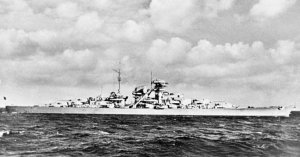
Bismarck on trials; the rangefinders had not yet been installed
On 6 March, Bismarck received the order to steam to Kiel. On the way, the ship was escorted by several Messerschmitt Bf 109 fighters and a pair of armed merchant vessels, along with an icebreaker. At 08:45 on 8 March, Bismarck briefly ran aground on the southern shore of the Kiel Canal; she was freed within an hour. The ship reached Kiel the following day, where her crew stocked ammunition, fuel, and other supplies and applied a coat of dazzle paint to camouflage her. British bombers attacked the harbour without success on 12 March. On 17 March, the old battleship Schlesien, now used as an icebreaker, escorted Bismarck through the ice to Gotenhafen, where the latter continued combat readiness training.
The Naval High Command (Oberkommando der Marine or OKM), commanded by Admiral Erich Raeder, intended to continue the practice of using heavy ships as surface raiders against Allied merchant traffic in the Atlantic Ocean. The two Scharnhorst-class battleships were based in Brest, France, at the time, having just completed Operation Berlin, a major raid into the Atlantic. Bismarck's sister ship Tirpitz rapidly approached completion. Bismarck and Tirpitz were to sortie from the Baltic and rendezvous with the two Scharnhorst-class ships in the Atlantic; the operation was initially scheduled for around 25 April 1941, when a new moon period would make conditions more favourable.
Work on Tirpitz was completed later than anticipated, and she was not commissioned until 25 February; the ship was not ready for combat until late in the year. To further complicate the situation, Gneisenau was torpedoed in Brest and damaged further by bombs when in drydock. Scharnhorst required a boiler overhaul following Operation Berlin; the workers discovered during the overhaul that the boilers were in worse condition than expected. She would also be unavailable for the planned sortie. Attacks by British bombers on supply depots in Kiel delayed repairs to the heavy cruisers Admiral Scheer and Admiral Hipper. The two ships would not be ready for action until July or August. Admiral Günther Lütjens, Flottenchef (Fleet Chief) of the Kriegsmarine, chosen to lead the operation, wished to delay the operation at least until either Scharnhorst or Tirpitz became available, but the OKM decided to proceed with the operation, codenamed Operation Rheinübung, with a force consisting of only Bismarck and the heavy cruiser Prinz Eugen. At a final meeting with Raeder in Paris on 26 April, Lütjens was encouraged by his commander-in-chief to proceed and he eventually decided that an operation should begin as soon as possible to prevent the enemy gaining any respite.

 en.wikipedia.org
en.wikipedia.org
27 May 1941 - German battleship Bismarck was scuttled by her crew, and sank with heavy loss of life
Part I
Bismarck was the first of two Bismarck-class battleships built for Nazi Germany's Kriegsmarine. Named after Chancellor Otto von Bismarck, the ship was laid down at the Blohm & Voss shipyard in Hamburg in July 1936 and launched in February 1939. Work was completed in August 1940, when she was commissioned into the German fleet. Bismarck and her sister ship Tirpitz were the largest battleships ever built by Germany, and two of the largest built by any European power.

In the course of the warship's eight-month career under its sole commanding officer, Captain Ernst Lindemann, Bismarck conducted only one offensive operation, lasting 8 days in May 1941, codenamed Rheinübung. The ship, along with the heavy cruiser Prinz Eugen, was to break into the Atlantic Ocean and raid Allied shipping from North America to Great Britain. The two ships were detected several times off Scandinavia, and British naval units were deployed to block their route. At the Battle of the Denmark Strait, the battlecruiser HMS Hood initially engaged Prinz Eugen, probably by mistake, while HMS Prince of Wales engaged Bismarck. In the ensuing battle Hood was destroyed by the combined fire of Bismarck and Prinz Eugen, which then damaged Prince of Wales and forced her retreat. Bismarck suffered sufficient damage from three hits to force an end to the raiding mission.
The destruction of Hood spurred a relentless pursuit by the Royal Navy involving dozens of warships. Two days later, heading for occupied France to effect repairs, Bismarck was attacked by 16 obsolescent Fairey Swordfish biplane torpedo bombers from the aircraft carrier HMS Ark Royal; one scored a hit that rendered the battleship's steering gear inoperable. In her final battle the following morning, the already-crippled Bismarck was severely damaged during a sustained engagement with two British battleships and two heavy cruisers, was scuttled by her crew, and sank with heavy loss of life. Most experts agree that the battle damage would have caused her to sink eventually. The wreck was located in June 1989 by Robert Ballard, and has since been further surveyed by several other expeditions.
Characteristics
Main article: Bismarck-class battleship
The two Bismarck-class battleships were designed in the mid-1930s by the German Kriegsmarine as a counter to French naval expansion, specifically the two Richelieu-class battleships France had started in 1935. Laid down after the signing of the Anglo-German Naval Agreement of 1935, Bismarck and her sister Tirpitz were nominally within the 35,000-long-ton (36,000 t) limit imposed by the Washington regime that governed battleship construction in the interwar period. The ships secretly exceeded the figure by a wide margin, though before either vessel was completed, the international treaty system had fallen apart following Japan's withdrawal in 1937, allowing signatories to invoke an "escalator clause" that permitted displacements as high as 45,000 long tons (46,000 t).

3D rendering of Bismarck based on its configuration during Operation Rheinübung
Bismarck displaced 41,700 t (41,000 long tons) as built and 50,300 t (49,500 long tons) fully loaded, with an overall length of 251 m (823 ft 6 in), a beam of 36 m (118 ft 1 in) and a maximum draft of 9.9 m (32 ft 6 in). The battleship was Germany's largest warship, and displaced more than any other European battleship, with the exception of HMS Vanguard, commissioned after the end of the war.[5] Bismarck was powered by three Blohm & Voss geared steam turbines and twelve oil-fired Wagner superheated boilers, which developed a total of 148,116 shp (110,450 kW) and yielded a maximum speed of 30.01 knots (55.58 km/h; 34.53 mph) on speed trials. The ship had a cruising range of 8,870 nautical miles (16,430 km; 10,210 mi) at 19 knots (35 km/h; 22 mph). Bismarck was equipped with three FuMO 23 search radar sets, mounted on the forward and stern rangefinders and foretop.
The standard crew numbered 103 officers and 1,962 enlisted men. The crew was divided into twelve divisions of between 180 and 220 men. The first six divisions were assigned to the ship's armament, divisions one to four for the main and secondary batteries and five and six manning anti-aircraft guns. The seventh division consisted of specialists, including cooks and carpenters, and the eighth division consisted of ammunition handlers. The radio operators, signalmen, and quartermasters were assigned to the ninth division. The last three divisions were the engine room personnel. When Bismarck left port, fleet staff, prize crews, and war correspondents increased the crew complement to over 2,200 men. Roughly 200 of the engine room personnel came from the light cruiser Karlsruhe, which had been lost during Operation Weserübung, the German invasion of Norway. Bismarck's crew published a ship's newspaper titled Die Schiffsglocke (The Ship's Bell); this paper was only published once, on 23 April 1941, by the commander of the engineering department, Gerhard Junack.
Bismarck was armed with eight 38 cm (15 in) SK C/34 guns arranged in four twin gun turrets: two super-firing turrets forward—"Anton" and "Bruno"—and two aft—"Caesar" and "Dora". Secondary armament consisted of twelve 15 cm (5.9 in) L/55 guns, sixteen 10.5 cm (4.1 in) L/65 and sixteen 3.7 cm (1.5 in) L/83, and twelve 2 cm (0.79 in) anti-aircraft guns. Bismarck also carried four Arado Ar 196 reconnaissance floatplanes, with a single large hangar and a double-ended catapult. The ship's main belt was 320 mm (12.6 in) thick and was covered by a pair of upper and main armoured decks that were 50 mm (2.0 in) and 100 to 120 mm (3.9 to 4.7 in) thick, respectively. The 38 cm (15 in) turrets were protected by 360 mm (14.2 in) thick faces and 220 mm (8.7 in) thick sides.
Service history

Bismarck in port in Hamburg
Bismarck was ordered under the name Ersatz Hannover ("Hannover replacement"), a replacement for the old pre-dreadnought SMS Hannover, under contract "F".The contract was awarded to the Blohm & Voss shipyard in Hamburg, where the keel was laid on 1 July 1936 at Helgen IX. The ship was launched on 14 February 1939 and during the elaborate ceremonies was christened by Dorothee von Löwenfeld, granddaughter of Chancellor Otto von Bismarck, the ship's namesake. Adolf Hitler made the christening speech. Fitting-out work followed the launch, during which time the original straight stem was replaced with a raked "Atlantic bow" similar to those of the Scharnhorst-class battleships. Bismarck was commissioned into the fleet on 24 August 1940 for sea trials, which were conducted in the Baltic. Kapitän zur See Ernst Lindemann took command of the ship at the time of commissioning.
On 15 September 1940, three weeks after commissioning, Bismarck left Hamburg to begin sea trials in Kiel Bay. Sperrbrecher 13 escorted the ship to Arcona on 28 September, and then on to Gotenhafen for trials in the Gulf of Danzig. The ship's power-plant was given a thorough workout; Bismarck made measured-mile and high speed runs. As the ship's stability and manoeuvrability were being tested, a flaw in her design was discovered. When attempting to steer the ship solely through altering propeller revolutions, the crew learned that Bismarck could be kept on course only with great difficulty. Even with the outboard screws running at full power in opposite directions, they generated only a slight turning ability. Bismarck's main battery guns were first test-fired in late November. The tests proved she was a very stable gun platform. Trials lasted until December; Bismarck returned to Hamburg, arriving on 9 December, for minor alterations and the completion of the fitting-out process.
The ship was scheduled to return to Kiel on 24 January 1941, but a merchant vessel had been sunk in the Kiel Canal and prevented use of the waterway. Severe weather hampered efforts to remove the wreck, and Bismarck was not able to reach Kiel until March. The delay greatly frustrated Lindemann, who remarked that "[Bismarck] had been tied down at Hamburg for five weeks ... the precious time at sea lost as a result cannot be made up, and a significant delay in the final war deployment of the ship thus is unavoidable." While waiting to reach Kiel, Bismarck hosted Captain Anders Forshell, the Swedish naval attaché to Berlin. He returned to Sweden with a detailed description of the ship, which was subsequently leaked to Britain by pro-British elements in the Swedish Navy. The information provided the Royal Navy with its first full description of the vessel, although it lacked important facts, including top speed, radius of action, and displacement.

Bismarck on trials; the rangefinders had not yet been installed
On 6 March, Bismarck received the order to steam to Kiel. On the way, the ship was escorted by several Messerschmitt Bf 109 fighters and a pair of armed merchant vessels, along with an icebreaker. At 08:45 on 8 March, Bismarck briefly ran aground on the southern shore of the Kiel Canal; she was freed within an hour. The ship reached Kiel the following day, where her crew stocked ammunition, fuel, and other supplies and applied a coat of dazzle paint to camouflage her. British bombers attacked the harbour without success on 12 March. On 17 March, the old battleship Schlesien, now used as an icebreaker, escorted Bismarck through the ice to Gotenhafen, where the latter continued combat readiness training.
The Naval High Command (Oberkommando der Marine or OKM), commanded by Admiral Erich Raeder, intended to continue the practice of using heavy ships as surface raiders against Allied merchant traffic in the Atlantic Ocean. The two Scharnhorst-class battleships were based in Brest, France, at the time, having just completed Operation Berlin, a major raid into the Atlantic. Bismarck's sister ship Tirpitz rapidly approached completion. Bismarck and Tirpitz were to sortie from the Baltic and rendezvous with the two Scharnhorst-class ships in the Atlantic; the operation was initially scheduled for around 25 April 1941, when a new moon period would make conditions more favourable.
Work on Tirpitz was completed later than anticipated, and she was not commissioned until 25 February; the ship was not ready for combat until late in the year. To further complicate the situation, Gneisenau was torpedoed in Brest and damaged further by bombs when in drydock. Scharnhorst required a boiler overhaul following Operation Berlin; the workers discovered during the overhaul that the boilers were in worse condition than expected. She would also be unavailable for the planned sortie. Attacks by British bombers on supply depots in Kiel delayed repairs to the heavy cruisers Admiral Scheer and Admiral Hipper. The two ships would not be ready for action until July or August. Admiral Günther Lütjens, Flottenchef (Fleet Chief) of the Kriegsmarine, chosen to lead the operation, wished to delay the operation at least until either Scharnhorst or Tirpitz became available, but the OKM decided to proceed with the operation, codenamed Operation Rheinübung, with a force consisting of only Bismarck and the heavy cruiser Prinz Eugen. At a final meeting with Raeder in Paris on 26 April, Lütjens was encouraged by his commander-in-chief to proceed and he eventually decided that an operation should begin as soon as possible to prevent the enemy gaining any respite.

German battleship Bismarck - Wikipedia
Today in Naval History - Naval / Maritime Events in History
27 May 1941 - German battleship Bismarck was scuttled by her crew, and sank with heavy loss of life
Part II
Operation Rheinübung
Main article: Operation Rheinübung
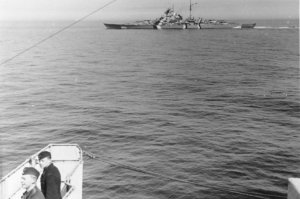
Bismarck, photographed from Prinz Eugen, in the Baltic at the outset of Operation Rheinübung
On 5 May 1941, Hitler and Wilhelm Keitel, with a large entourage, arrived to view Bismarck and Tirpitz in Gotenhafen. The men were given an extensive tour of the ships, after which Hitler met with Lütjens to discuss the upcoming mission. On 16 May, Lütjens reported that Bismarck and Prinz Eugen were fully prepared for Operation Rheinübung; he was therefore ordered to proceed with the mission on the evening of 19 May. As part of the operational plans, a group of eighteen supply ships would be positioned to support Bismarck and Prinz Eugen. Four U-boats would be placed along the convoy routes between Halifax and Britain to scout for the raiders.
By the start of the operation, Bismarck's crew had increased to 2,221 officers and enlisted men. This included an admiral's staff of nearly 65 and a prize crew of 80 sailors, who could be used to crew transports captured during the mission. At 02:00 on 19 May, Bismarck departed Gotenhafen and made for the Danish straits. She was joined at 11:25 by Prinz Eugen, which had departed the previous night at 21:18, off Cape Arkona. The two ships were escorted by three destroyers—Z10 Hans Lody, Z16 Friedrich Eckoldt, and Z23—and a flotilla of minesweepers. The Luftwaffe provided air cover during the voyage out of German waters. At around noon on 20 May, Lindemann informed the ship's crew via loudspeaker of the ship's mission. At approximately the same time, a group of ten or twelve Swedish aircraft flying reconnaissance encountered the German force and reported its composition and heading, though the Germans did not see the Swedes.
An hour later, the German flotilla encountered the Swedish cruiser HSwMS Gotland; the cruiser shadowed the Germans for two hours in the Kattegat. Gotland transmitted a report to naval headquarters, stating: "Two large ships, three destroyers, five escort vessels, and 10–12 aircraft passed Marstrand, course 205°/20'."[35] The OKM was not concerned about the security risk posed by Gotland, though both Lütjens and Lindemann believed operational secrecy had been lost. The report eventually made its way to Captain Henry Denham, the British naval attaché to Sweden, who transmitted the information to the Admiralty. The code-breakers at Bletchley Park confirmed that an Atlantic raid was imminent, as they had decrypted reports that Bismarck and Prinz Eugen had taken on prize crews and requested additional navigational charts from headquarters. A pair of Supermarine Spitfires was ordered to search the Norwegian coast for the flotilla.
German aerial reconnaissance confirmed that one aircraft carrier, three battleships, and four cruisers remained at anchor in the main British naval base at Scapa Flow, which confirmed to Lütjens that the British were unaware of his operation. On the evening of 20 May, Bismarck and the rest of the flotilla reached the Norwegian coast; the minesweepers were detached and the two raiders and their destroyer escorts continued north. The following morning, radio-intercept officers on board Prinz Eugen picked up a signal ordering British reconnaissance aircraft to search for two battleships and three destroyers northbound off the Norwegian coast. At 7:00 on the 21st, the Germans spotted four unidentified aircraft, which quickly departed. Shortly after 12:00, the flotilla reached Bergen and anchored at Grimstadfjord, where the ships' crews painted over the Baltic camouflage with the standard "outboard grey" worn by German warships operating in the Atlantic.
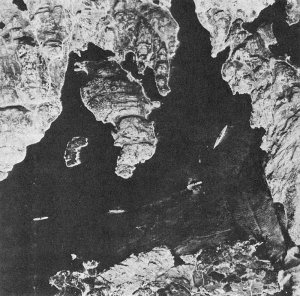
Aerial reconnaissance photo showing Bismarck anchored (on the right) in Norway
When Bismarck was in Norway, a pair of Bf 109 fighters circled overhead to protect her from British air attacks, but Flying Officer Michael Suckling managed to fly his Spitfire directly over the German flotilla at a height of 8,000 m (26,000 ft) and take photos of Bismarck and her escorts. Upon receipt of the information, Admiral John Tovey ordered the battlecruiser HMS Hood, the newly commissioned battleship HMS Prince of Wales, and six destroyers to reinforce the pair of cruisers patrolling the Denmark Strait. The rest of the Home Fleet was placed on high alert in Scapa Flow. Eighteen bombers were dispatched to attack the Germans, but weather over the fjord had worsened and they were unable to find the German warships.
Bismarck did not replenish her fuel stores in Norway, as her operational orders did not require her to do so. She had left port 200 t (200 long tons) short of a full load, and had since expended another 1,000 t (980 long tons) on the voyage from Gotenhafen. Prinz Eugen took on 764 t (752 long tons) of fuel. At 19:30 on 21 May, Bismarck, Prinz Eugen, and the three escorting destroyers left Bergen. At midnight, when the force was in the open sea, heading towards the Arctic Ocean, Raeder disclosed the operation to Hitler, who reluctantly consented to the raid. The three escorting destroyers were detached at 04:14 on 22 May, while the force steamed off Trondheim. At around 12:00, Lütjens ordered his two ships to turn toward the Denmark Strait to attempt the break-out into the open Atlantic.
By 04:00 on 23 May, Lütjens ordered Bismarck and Prinz Eugen to increase speed to 27 knots (50 km/h; 31 mph) to make the dash through the Denmark Strait. Upon entering the Strait, both ships activated their FuMO radar detection equipment sets. Bismarck led Prinz Eugen by about 700 m (770 yd); mist reduced visibility to 3,000 to 4,000 m (3,300 to 4,400 yd). The Germans encountered some ice at around 10:00, which necessitated a reduction in speed to 24 knots (44 km/h; 28 mph). Two hours later, the pair had reached a point north of Iceland. The ships were forced to zigzag to avoid ice floes. At 19:22, hydrophone and radar operators aboard the German warships detected the cruiser HMS Suffolk at a range of approximately 12,500 m (13,700 yd). Prinz Eugen's radio-intercept team decrypted the radio signals being sent by Suffolk and learned that their location had been reported.
Lütjens gave permission for Prinz Eugen to engage Suffolk, but the captain of the German cruiser could not clearly make out his target and so held fire. Suffolk quickly retreated to a safe distance and shadowed the German ships. At 20:30, the heavy cruiser HMS Norfolk joined Suffolk, but approached the German raiders too closely. Lütjens ordered his ships to engage the British cruiser; Bismarck fired five salvoes, three of which straddled Norfolk and rained shell splinters on her decks. The cruiser laid a smoke screen and fled into a fog bank, ending the brief engagement. The concussion from the 38 cm guns' firing disabled Bismarck's FuMO 23 radar set; this prompted Lütjens to order Prinz Eugen to take station ahead so she could use her functioning radar to scout for the formation.
At around 22:00, Lütjens ordered Bismarck to make a 180-degree turn in an effort to surprise the two heavy cruisers shadowing him. Although Bismarck was visually obscured in a rain squall, Suffolk's radar quickly detected the manoeuvre, allowing the cruiser to evade. The cruisers remained on station through the night, continually relaying the location and bearing of the German ships. The harsh weather broke on the morning of 24 May, revealing a clear sky. At 05:07, hydrophone operators aboard Prinz Eugen detected a pair of unidentified vessels approaching the German formation at a range of 20 nmi (37 km; 23 mi), reporting "Noise of two fast-moving turbine ships at 280° relative bearing!"
Battle of the Denmark Strait
Main article: Battle of the Denmark Strait
At 05:45 on 24 May, German lookouts spotted smoke on the horizon; this turned out to be from Hood and Prince of Wales, under the command of Vice Admiral Lancelot Holland. Lütjens ordered his ships' crews to battle stations. By 05:52, the range had fallen to 26,000 m (28,000 yd) and Hood opened fire, followed by Prince of Wales a minute later. Hood engaged Prinz Eugen, which the British thought to be Bismarck, while Prince of Wales fired on Bismarck. Adalbert Schneider, the first gunnery officer aboard Bismarck, twice requested permission to return fire, but Lütjens hesitated. Lindemann intervened, muttering "I will not let my ship be shot out from under my ass." He demanded permission to fire from Lütjens, who relented and at 05:55 ordered his ships to engage the British.
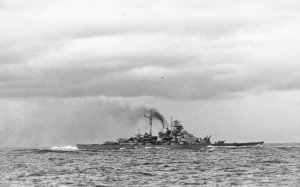
Bismarck as seen from Prinz Eugenafter the Battle of the Denmark Strait
The British ships approached the German ships head on, which permitted them to use only their forward guns; Bismarck and Prinz Eugen could fire full broadsides. Several minutes after opening fire, Holland ordered a 20° turn to port, which would allow his ships to engage with their rear gun turrets. Both German ships concentrated their fire on Hood. About a minute after opening fire, Prinz Eugen scored a hit with a high-explosive 20.3 cm (8.0 in) shell; the explosion detonated unrotated projectile ammunition and started a large fire, which was quickly extinguished. After firing three four-gun salvoes, Schneider had found the range to Hood; he immediately ordered rapid-fire salvoes from Bismarck's eight 38 cm guns. He also ordered the ship's 15 cm secondary guns to engage Prince of Wales. Holland then ordered a second 20° turn to port, to bring his ships on a parallel course with Bismarck and Prinz Eugen. Lütjens ordered Prinz Eugen to shift fire and target Prince of Wales, to keep both of his opponents under fire. Within a few minutes, Prinz Eugen scored a pair of hits on the battleship that started a small fire.
Lütjens then ordered Prinz Eugen to drop behind Bismarck, so she could continue to monitor the location of Norfolk and Suffolk, which were still 10 to 12 nmi (19 to 22 km; 12 to 14 mi) to the east. At 06:00, Hood was completing the second turn to port when Bismarck's fifth salvo hit. Two of the shells landed short, striking the water close to the ship, but at least one of the 38 cm armour-piercing shells struck Hood and penetrated her thin deck armour. The shell reached Hood's rear ammunition magazine and detonated 112 t (110 long tons) of cordite propellant. The massive explosion broke the back of the ship between the main mast and the rear funnel; the forward section continued to move forward briefly before the in-rushing water caused the bow to rise into the air at a steep angle. The stern also rose as water rushed into the ripped-open compartments. Schneider exclaimed "He is sinking!" over the ship's loudspeakers. In only eight minutes of firing, Hood had disappeared, taking all but three of her crew of 1,419 men with her.
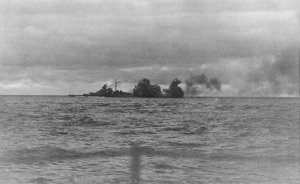
Bismarck firing her main battery during the battle
Bismarck then shifted fire to Prince of Wales. The British battleship scored a hit on Bismarck with her sixth salvo, but the German ship found her mark with her first salvo. One of the shells struck the bridge on Prince of Wales, though it did not explode and instead exited the other side, killing everyone in the ship's command centre, save Captain John Leach, the ship's commanding officer, and one other. The two German ships continued to fire upon Prince of Wales, causing serious damage. Guns malfunctioned on the recently commissioned British ship, which still had civilian technicians aboard. Despite the technical faults in the main battery, Prince of Wales scored three hits on Bismarck in the engagement. The first struck her in the forecastle above the waterline but low enough to allow the crashing waves to enter the hull. The second shell struck below the armoured belt and exploded on contact with the torpedo bulkhead, completely flooding a turbo-generator room and partially flooding an adjacent boiler room. The third shell passed through one of the boats carried aboard the ship and then went through the floatplane catapult without exploding.
At 06:13, Leach gave the order to retreat; only five of his ship's ten 14 in (360 mm) guns were still firing and his ship had sustained significant damage. Prince of Wales made a 160° turn and laid a smoke screen to cover her withdrawal. The Germans ceased fire as the range widened. Though Lindemann strongly advocated chasing Prince of Wales and destroying her, Lütjens obeyed operational orders to shun any avoidable engagement with enemy forces that were not protecting a convoy, firmly rejecting the request, and instead ordered Bismarck and Prinz Eugen to head for the North Atlantic. In the engagement, Bismarck had fired 93 armour-piercing shells and had been hit by three shells in return. The forecastle hit allowed 1,000 to 2,000 t (980 to 1,970 long tons) of water to flood into the ship, which contaminated fuel oil stored in the bow. Lütjens refused to reduce speed to allow damage control teams to repair the shell hole which widened and allowed more water into the ship. The second hit caused some additional flooding. Shell-splinters from the second hit also damaged a steam line in the turbo-generator room, but this was not serious, as Bismarck had sufficient other generator reserves. The combined flooding from these two hits caused a 9-degree list to port and a 3-degree trim by the bow.

 en.wikipedia.org
en.wikipedia.org
27 May 1941 - German battleship Bismarck was scuttled by her crew, and sank with heavy loss of life
Part II
Operation Rheinübung
Main article: Operation Rheinübung

Bismarck, photographed from Prinz Eugen, in the Baltic at the outset of Operation Rheinübung
On 5 May 1941, Hitler and Wilhelm Keitel, with a large entourage, arrived to view Bismarck and Tirpitz in Gotenhafen. The men were given an extensive tour of the ships, after which Hitler met with Lütjens to discuss the upcoming mission. On 16 May, Lütjens reported that Bismarck and Prinz Eugen were fully prepared for Operation Rheinübung; he was therefore ordered to proceed with the mission on the evening of 19 May. As part of the operational plans, a group of eighteen supply ships would be positioned to support Bismarck and Prinz Eugen. Four U-boats would be placed along the convoy routes between Halifax and Britain to scout for the raiders.
By the start of the operation, Bismarck's crew had increased to 2,221 officers and enlisted men. This included an admiral's staff of nearly 65 and a prize crew of 80 sailors, who could be used to crew transports captured during the mission. At 02:00 on 19 May, Bismarck departed Gotenhafen and made for the Danish straits. She was joined at 11:25 by Prinz Eugen, which had departed the previous night at 21:18, off Cape Arkona. The two ships were escorted by three destroyers—Z10 Hans Lody, Z16 Friedrich Eckoldt, and Z23—and a flotilla of minesweepers. The Luftwaffe provided air cover during the voyage out of German waters. At around noon on 20 May, Lindemann informed the ship's crew via loudspeaker of the ship's mission. At approximately the same time, a group of ten or twelve Swedish aircraft flying reconnaissance encountered the German force and reported its composition and heading, though the Germans did not see the Swedes.
An hour later, the German flotilla encountered the Swedish cruiser HSwMS Gotland; the cruiser shadowed the Germans for two hours in the Kattegat. Gotland transmitted a report to naval headquarters, stating: "Two large ships, three destroyers, five escort vessels, and 10–12 aircraft passed Marstrand, course 205°/20'."[35] The OKM was not concerned about the security risk posed by Gotland, though both Lütjens and Lindemann believed operational secrecy had been lost. The report eventually made its way to Captain Henry Denham, the British naval attaché to Sweden, who transmitted the information to the Admiralty. The code-breakers at Bletchley Park confirmed that an Atlantic raid was imminent, as they had decrypted reports that Bismarck and Prinz Eugen had taken on prize crews and requested additional navigational charts from headquarters. A pair of Supermarine Spitfires was ordered to search the Norwegian coast for the flotilla.
German aerial reconnaissance confirmed that one aircraft carrier, three battleships, and four cruisers remained at anchor in the main British naval base at Scapa Flow, which confirmed to Lütjens that the British were unaware of his operation. On the evening of 20 May, Bismarck and the rest of the flotilla reached the Norwegian coast; the minesweepers were detached and the two raiders and their destroyer escorts continued north. The following morning, radio-intercept officers on board Prinz Eugen picked up a signal ordering British reconnaissance aircraft to search for two battleships and three destroyers northbound off the Norwegian coast. At 7:00 on the 21st, the Germans spotted four unidentified aircraft, which quickly departed. Shortly after 12:00, the flotilla reached Bergen and anchored at Grimstadfjord, where the ships' crews painted over the Baltic camouflage with the standard "outboard grey" worn by German warships operating in the Atlantic.

Aerial reconnaissance photo showing Bismarck anchored (on the right) in Norway
When Bismarck was in Norway, a pair of Bf 109 fighters circled overhead to protect her from British air attacks, but Flying Officer Michael Suckling managed to fly his Spitfire directly over the German flotilla at a height of 8,000 m (26,000 ft) and take photos of Bismarck and her escorts. Upon receipt of the information, Admiral John Tovey ordered the battlecruiser HMS Hood, the newly commissioned battleship HMS Prince of Wales, and six destroyers to reinforce the pair of cruisers patrolling the Denmark Strait. The rest of the Home Fleet was placed on high alert in Scapa Flow. Eighteen bombers were dispatched to attack the Germans, but weather over the fjord had worsened and they were unable to find the German warships.
Bismarck did not replenish her fuel stores in Norway, as her operational orders did not require her to do so. She had left port 200 t (200 long tons) short of a full load, and had since expended another 1,000 t (980 long tons) on the voyage from Gotenhafen. Prinz Eugen took on 764 t (752 long tons) of fuel. At 19:30 on 21 May, Bismarck, Prinz Eugen, and the three escorting destroyers left Bergen. At midnight, when the force was in the open sea, heading towards the Arctic Ocean, Raeder disclosed the operation to Hitler, who reluctantly consented to the raid. The three escorting destroyers were detached at 04:14 on 22 May, while the force steamed off Trondheim. At around 12:00, Lütjens ordered his two ships to turn toward the Denmark Strait to attempt the break-out into the open Atlantic.
By 04:00 on 23 May, Lütjens ordered Bismarck and Prinz Eugen to increase speed to 27 knots (50 km/h; 31 mph) to make the dash through the Denmark Strait. Upon entering the Strait, both ships activated their FuMO radar detection equipment sets. Bismarck led Prinz Eugen by about 700 m (770 yd); mist reduced visibility to 3,000 to 4,000 m (3,300 to 4,400 yd). The Germans encountered some ice at around 10:00, which necessitated a reduction in speed to 24 knots (44 km/h; 28 mph). Two hours later, the pair had reached a point north of Iceland. The ships were forced to zigzag to avoid ice floes. At 19:22, hydrophone and radar operators aboard the German warships detected the cruiser HMS Suffolk at a range of approximately 12,500 m (13,700 yd). Prinz Eugen's radio-intercept team decrypted the radio signals being sent by Suffolk and learned that their location had been reported.
Lütjens gave permission for Prinz Eugen to engage Suffolk, but the captain of the German cruiser could not clearly make out his target and so held fire. Suffolk quickly retreated to a safe distance and shadowed the German ships. At 20:30, the heavy cruiser HMS Norfolk joined Suffolk, but approached the German raiders too closely. Lütjens ordered his ships to engage the British cruiser; Bismarck fired five salvoes, three of which straddled Norfolk and rained shell splinters on her decks. The cruiser laid a smoke screen and fled into a fog bank, ending the brief engagement. The concussion from the 38 cm guns' firing disabled Bismarck's FuMO 23 radar set; this prompted Lütjens to order Prinz Eugen to take station ahead so she could use her functioning radar to scout for the formation.
At around 22:00, Lütjens ordered Bismarck to make a 180-degree turn in an effort to surprise the two heavy cruisers shadowing him. Although Bismarck was visually obscured in a rain squall, Suffolk's radar quickly detected the manoeuvre, allowing the cruiser to evade. The cruisers remained on station through the night, continually relaying the location and bearing of the German ships. The harsh weather broke on the morning of 24 May, revealing a clear sky. At 05:07, hydrophone operators aboard Prinz Eugen detected a pair of unidentified vessels approaching the German formation at a range of 20 nmi (37 km; 23 mi), reporting "Noise of two fast-moving turbine ships at 280° relative bearing!"
Battle of the Denmark Strait
Main article: Battle of the Denmark Strait
At 05:45 on 24 May, German lookouts spotted smoke on the horizon; this turned out to be from Hood and Prince of Wales, under the command of Vice Admiral Lancelot Holland. Lütjens ordered his ships' crews to battle stations. By 05:52, the range had fallen to 26,000 m (28,000 yd) and Hood opened fire, followed by Prince of Wales a minute later. Hood engaged Prinz Eugen, which the British thought to be Bismarck, while Prince of Wales fired on Bismarck. Adalbert Schneider, the first gunnery officer aboard Bismarck, twice requested permission to return fire, but Lütjens hesitated. Lindemann intervened, muttering "I will not let my ship be shot out from under my ass." He demanded permission to fire from Lütjens, who relented and at 05:55 ordered his ships to engage the British.

Bismarck as seen from Prinz Eugenafter the Battle of the Denmark Strait
The British ships approached the German ships head on, which permitted them to use only their forward guns; Bismarck and Prinz Eugen could fire full broadsides. Several minutes after opening fire, Holland ordered a 20° turn to port, which would allow his ships to engage with their rear gun turrets. Both German ships concentrated their fire on Hood. About a minute after opening fire, Prinz Eugen scored a hit with a high-explosive 20.3 cm (8.0 in) shell; the explosion detonated unrotated projectile ammunition and started a large fire, which was quickly extinguished. After firing three four-gun salvoes, Schneider had found the range to Hood; he immediately ordered rapid-fire salvoes from Bismarck's eight 38 cm guns. He also ordered the ship's 15 cm secondary guns to engage Prince of Wales. Holland then ordered a second 20° turn to port, to bring his ships on a parallel course with Bismarck and Prinz Eugen. Lütjens ordered Prinz Eugen to shift fire and target Prince of Wales, to keep both of his opponents under fire. Within a few minutes, Prinz Eugen scored a pair of hits on the battleship that started a small fire.
Lütjens then ordered Prinz Eugen to drop behind Bismarck, so she could continue to monitor the location of Norfolk and Suffolk, which were still 10 to 12 nmi (19 to 22 km; 12 to 14 mi) to the east. At 06:00, Hood was completing the second turn to port when Bismarck's fifth salvo hit. Two of the shells landed short, striking the water close to the ship, but at least one of the 38 cm armour-piercing shells struck Hood and penetrated her thin deck armour. The shell reached Hood's rear ammunition magazine and detonated 112 t (110 long tons) of cordite propellant. The massive explosion broke the back of the ship between the main mast and the rear funnel; the forward section continued to move forward briefly before the in-rushing water caused the bow to rise into the air at a steep angle. The stern also rose as water rushed into the ripped-open compartments. Schneider exclaimed "He is sinking!" over the ship's loudspeakers. In only eight minutes of firing, Hood had disappeared, taking all but three of her crew of 1,419 men with her.

Bismarck firing her main battery during the battle
Bismarck then shifted fire to Prince of Wales. The British battleship scored a hit on Bismarck with her sixth salvo, but the German ship found her mark with her first salvo. One of the shells struck the bridge on Prince of Wales, though it did not explode and instead exited the other side, killing everyone in the ship's command centre, save Captain John Leach, the ship's commanding officer, and one other. The two German ships continued to fire upon Prince of Wales, causing serious damage. Guns malfunctioned on the recently commissioned British ship, which still had civilian technicians aboard. Despite the technical faults in the main battery, Prince of Wales scored three hits on Bismarck in the engagement. The first struck her in the forecastle above the waterline but low enough to allow the crashing waves to enter the hull. The second shell struck below the armoured belt and exploded on contact with the torpedo bulkhead, completely flooding a turbo-generator room and partially flooding an adjacent boiler room. The third shell passed through one of the boats carried aboard the ship and then went through the floatplane catapult without exploding.
At 06:13, Leach gave the order to retreat; only five of his ship's ten 14 in (360 mm) guns were still firing and his ship had sustained significant damage. Prince of Wales made a 160° turn and laid a smoke screen to cover her withdrawal. The Germans ceased fire as the range widened. Though Lindemann strongly advocated chasing Prince of Wales and destroying her, Lütjens obeyed operational orders to shun any avoidable engagement with enemy forces that were not protecting a convoy, firmly rejecting the request, and instead ordered Bismarck and Prinz Eugen to head for the North Atlantic. In the engagement, Bismarck had fired 93 armour-piercing shells and had been hit by three shells in return. The forecastle hit allowed 1,000 to 2,000 t (980 to 1,970 long tons) of water to flood into the ship, which contaminated fuel oil stored in the bow. Lütjens refused to reduce speed to allow damage control teams to repair the shell hole which widened and allowed more water into the ship. The second hit caused some additional flooding. Shell-splinters from the second hit also damaged a steam line in the turbo-generator room, but this was not serious, as Bismarck had sufficient other generator reserves. The combined flooding from these two hits caused a 9-degree list to port and a 3-degree trim by the bow.

German battleship Bismarck - Wikipedia
Today in Naval History - Naval / Maritime Events in History
27 May 1941 - German battleship Bismarck was scuttled by her crew, and sank with heavy loss of life
Part III
Chase
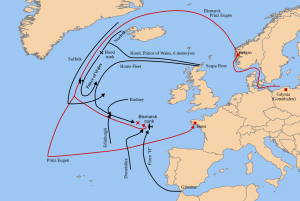
Map showing the course of Bismarck and the ships that pursued her
After the engagement, Lütjens reported, "Battlecruiser, probably Hood, sunk. Another battleship, King George V or Renown, turned away damaged. Two heavy cruisers maintain contact." At 08:01, he transmitted a damage report and his intentions to OKM, which were to detach Prinz Eugen for commerce raiding and to make for Saint-Nazaire for repairs. Shortly after 10:00, Lütjens ordered Prinz Eugen to fall behind Bismarck to determine the severity of the oil leakage from the bow hit. After confirming "broad streams of oil on both sides of [Bismarck's] wake", Prinz Eugen returned to the forward position. About an hour later, a British Short Sunderland flying boat reported the oil slick to Suffolk and Norfolk, which had been joined by the damaged Prince of Wales. Rear Admiral Frederic Wake-Walker, the commander of the two cruisers, ordered Prince of Wales to remain behind his ships.
The Royal Navy ordered all warships in the area to join the pursuit of Bismarck and Prinz Eugen. Tovey's Home Fleet was steaming to intercept the German raiders, but on the morning of 24 May was still over 350 nmi (650 km; 400 mi) away. The Admiralty ordered the light cruisers Manchester, Birmingham, and Arethusa to patrol the Denmark Strait in the event that Lütjens attempted to retrace his route. The battleship Rodney, which had been escorting RMS Britannic and was due for a refit in the Boston Navy Yard, joined Tovey. Two old Revenge-class battleships were ordered into the hunt: Revenge, from Halifax, and Ramillies, which was escorting Convoy HX 127. In all, six battleships and battlecruisers, two aircraft carriers, thirteen cruisers, and twenty-one destroyers were committed to the chase. By around 17:00, the crew aboard Prince of Wales restored nine of her ten main guns to working order, which permitted Wake-Walker to place her in the front of his formation to attack Bismarck if the opportunity arose.
With the weather worsening, Lütjens attempted to detach Prinz Eugen at 16:40. The squall was not heavy enough to cover her withdrawal from Wake-Walker's cruisers, which continued to maintain radar contact. Prinz Eugen was therefore recalled temporarily. The cruiser was successfully detached at 18:14. Bismarck turned around to face Wake-Walker's formation, forcing Suffolk to turn away at high speed. Prince of Wales fired twelve salvos at Bismarck, which responded with nine salvos, none of which hit. The action diverted British attention and permitted Prinz Eugen to slip away. After Bismarck resumed her previous heading, Wake-Walker's three ships took up station on Bismarck's port side.
Although Bismarck had been damaged in the engagement and forced to reduce speed, she was still capable of reaching 27 to 28 knots (50 to 52 km/h; 31 to 32 mph), the maximum speed of Tovey's King George V. Unless Bismarck could be slowed, the British would be unable to prevent her from reaching Saint-Nazaire. Shortly before 16:00 on 25 May, Tovey detached the aircraft carrier Victorious and four light cruisers to shape a course that would position her to launch her torpedo bombers. At 22:00, Victorious launched the strike, which comprised six Fairey Fulmar fighters and nine Fairey Swordfish torpedo bombers of 825 Naval Air Squadron, led by Lt Cdr Eugene Esmonde. The inexperienced aviators nearly attacked Norfolk and the U.S. Coast Guard cutter USCGC Modoc on their approach; the confusion alerted Bismarck's anti-aircraft gunners.
Bismarck also used her main and secondary batteries to fire at maximum depression to create giant splashes in the paths of the incoming torpedo bombers. None of the attacking aircraft were shot down. Bismarck evaded eight of the torpedoes launched at her, but the ninth struck amidships on the main armoured belt, throwing one man into a bulkhead and killing him and injuring five others. The explosion also caused minor damage to electrical equipment. The ship suffered more serious damage from manoeuvres to evade the torpedoes: rapid shifts in speed and course loosened collision mats, which increased the flooding from the forward shell hole and eventually forced abandonment of the port number 2 boiler room. This loss of a second boiler, combined with fuel losses and increasing bow trim, forced the ship to slow to 16 knots (30 km/h; 18 mph). Divers repaired the collision mats in the bow, after which speed increased to 20 knots (37 km/h; 23 mph), the speed that the command staff determined was the most economical for the voyage to occupied France.
Shortly after the Swordfish departed the scene, Bismarck and Prince of Wales engaged in a brief artillery duel. Neither scored a hit. Bismarck's damage control teams resumed work after the short engagement. The sea water that had flooded the number 2 port side boiler threatened to enter the number 4 turbo-generator feedwater system, which would have permitted saltwater to reach the turbines. The saltwater would have damaged the turbine blades and thus greatly reduced the ship's speed. By morning on 25 May, the danger had passed. The ship slowed to 12 knots (22 km/h; 14 mph) to allow divers to pump fuel from the forward compartments to the rear tanks; two hoses were successfully connected and a few hundred tons of fuel were transferred.
As the chase entered open waters, Wake-Walker's ships were compelled to zig-zag to avoid German U-boats that might be in the area. This required the ships to steam for ten minutes to port, then ten minutes to starboard, to keep the ships on the same base course. For the last few minutes of the turn to port, Bismarck was out of range of Suffolk's radar. At 03:00 on 25 May, Lütjens ordered an increase to maximum speed, which at this point was 28 knots (52 km/h; 32 mph). He then ordered the ship to circle away to the west and then north. This manoeuvre coincided with the period during which his ship was out of radar range; Bismarck successfully broke radar contact and circled back behind her pursuers. Suffolk's captain assumed that Bismarck had broken off to the west and attempted to find her by also steaming west. After half an hour, he informed Wake-Walker, who ordered the three ships to disperse at daylight to search visually.
The Royal Navy search became frantic, as many of the British ships were low on fuel. Victorious and her escorting cruisers were sent west, Wake-Walker's ships continued to the south and west, and Tovey continued to steam toward the mid-Atlantic. Force H, with the aircraft carrier Ark Royal and steaming up from Gibraltar, was still at least a day away. Unaware that he had shaken off Wake-Walker, Lütjens sent long radio messages to Naval Group West headquarters in Paris. The signals were intercepted by the British, from which bearings were determined. They were wrongly plotted on board King George V, leading Tovey to believe that Bismarck was heading back to Germany through the Iceland-Faeroe gap, which kept his fleet on the wrong course for seven hours. By the time the mistake had been discovered, Bismarck had put a sizeable gap between herself and the British ships.
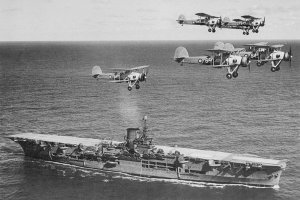
The aircraft carrier HMS Ark Royal with a flight of Swordfish overhead
British code-breakers were able to decrypt some of the German signals, including an order to the Luftwaffe to provide support for Bismarck making for Brest, decrypted by Jane Fawcett on 25 May 1941. The French Resistance provided the British with confirmation that Luftwaffe units were relocating there. Tovey could now turn his forces toward France to converge in areas through which Bismarck would have to pass. A squadron of Coastal Command PBY Catalinas based in Northern Ireland joined the search, covering areas where Bismarck might head in the attempt to reach occupied France. At 10:30 on 26 May, a Catalina piloted by Ensign Leonard B. Smith of the US Navy located her, some 690 nmi (1,280 km; 790 mi) northwest of Brest. At her current speed, she would have been close enough to reach the protection of U-boats and the Luftwaffe in less than a day. Most British forces were not close enough to stop her.
The only possibility for the Royal Navy was Ark Royal with Force H, under the command of Admiral James Somerville. Victorious, Prince of Wales, Suffolk and Repulse were forced to break off the search due to fuel shortage; the only heavy ships remaining apart from Force H were King George V and Rodney, but they were too distant. Ark Royal's Swordfish were already searching nearby when the Catalina found her. Several torpedo bombers also located the battleship, about 60 nmi (110 km; 69 mi) away from Ark Royal. Somerville ordered an attack as soon as the Swordfish returned and were rearmed with torpedoes. He detached the cruiser Sheffield to shadow Bismarck, though Ark Royal's aviators were not informed of this. As a result, the Swordfish, which were armed with torpedoes equipped with new magnetic detonators, accidentally attacked Sheffield. The magnetic detonators failed to work properly and Sheffield emerged unscathed.
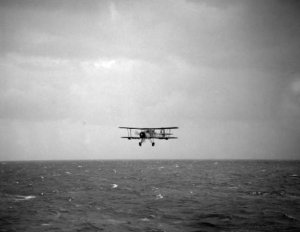
A Swordfish returns to Ark Royal after making the torpedo attack against Bismarck
Upon returning to Ark Royal, the Swordfish loaded torpedoes equipped with contact detonators. The second attack comprised fifteen aircraft and was launched at 19:10. At 20:47, the torpedo bombers began their attack descent through the clouds. As the Swordfish approached, Bismarck fired her main battery at Sheffield, straddling the cruiser with her second salvo. Shell fragments rained down on Sheffield, killing three men and wounding several others. Sheffield quickly retreated under cover of a smoke screen. The Swordfish then attacked; Bismarck began to turn violently as her anti-aircraft batteries engaged the bombers. One torpedo hit amidships on the port side, just below the bottom edge of the main armour belt. The force of the explosion was largely contained by the underwater protection system and the belt armour but some structural damage caused minor flooding.
The second torpedo struck Bismarck in her stern on the port side, near the port rudder shaft. The coupling on the port rudder assembly was badly damaged and the rudder became locked in a 12° turn to port. The explosion also caused much shock damage. The crew eventually managed to repair the starboard rudder but the port rudder remained jammed. A suggestion to sever the port rudder with explosives was dismissed by Lütjens, as damage to the screws would have left the battleship helpless. At 21:15, Lütjens reported that the ship was unmanoeuvrable.
Sinking
With the port rudder jammed, Bismarck was now steaming in a large circle, unable to escape from Tovey's forces. Though fuel shortages had reduced the number of ships available to the British, the battleships King George V and Rodney were still available, along with the heavy cruisers Dorsetshire and Norfolk. Lütjens signalled headquarters at 21:40 on the 26th: "Ship unmanoeuvrable. We will fight to the last shell. Long live the Führer." The mood of the crew became increasingly depressed, especially as messages from the naval command reached the ship. Intended to boost morale, the messages only highlighted the desperate situation in which the crew found itself. As darkness fell, Bismarck briefly fired on Sheffield, though the cruiser quickly fled. Sheffield lost contact in the low visibility and Captain Philip Vian's group of five destroyers was ordered to keep contact with Bismarck through the night.
The ships encountered Bismarck at 22:38; the battleship quickly engaged them with her main battery. After firing three salvos, she straddled the Polish destroyer ORP Piorun. The destroyer continued to close the range until a near miss at around 12,000 m (39,000 ft) forced her to turn away. Throughout the night and into the morning, Vian's destroyers harried Bismarck, illuminating her with star shells and firing dozens of torpedoes, none of which hit. Between 05:00 and 06:00, Bismarck's crew attempted to launch one of the Arado 196 float planes to carry away the ship's war diary, footage of the engagement with Hood, and other important documents. The third shell hit from Prince of Wales had damaged the steam line on the aircraft catapult, rendering it inoperative. As it was not possible to launch the aircraft it had become a fire hazard, and was pushed overboard.
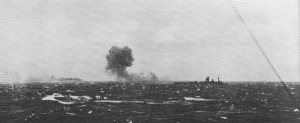
Rodney firing on Bismarck, which can be seen burning in the distance
After daybreak on 27 May, King George V led the attack. Rodney followed off her port quarter; Tovey intended to steam directly at Bismarck until he was about 8 nmi (15 km; 9.2 mi) away. At that point, he would turn south to put his ships parallel to his target. At 08:43, lookouts on King George V spotted her, some 23,000 m (25,000 yd) away. Four minutes later, Rodney's two forward turrets, comprising six 16 in (406 mm) guns, opened fire, then King George V's 14 in (356 mm) guns began firing. Bismarck returned fire at 08:50 with her forward guns; with her second salvo, she straddled Rodney. Thereafter, Bismarck's ability to aim her guns deteriorated as the ship, unable to steer, moved erratically in the heavy seas and deprived Schneider of a predictable course for range calculations.
As the range fell, the ships' secondary batteries joined the battle. Norfolk and Dorsetshire closed and began firing with their 8 in (203 mm) guns. At 09:02, a 16-inch shell from Rodney struck Bismarck's forward superstructure, killing hundreds of men and severely damaging the two forward turrets. According to survivors, this salvo probably killed both Lindemann and Lütjens and the rest of the bridge staff. The main fire control director was also destroyed by this hit, which probably also killed Schneider. A second shell from this salvo struck the forward main battery, which was disabled, though it would manage to fire one last salvo at 09:27. Lieutenant von Müllenheim-Rechberg, in the rear control station, took over firing control for the rear turrets. He managed to fire three salvos before a shell destroyed the gun director, disabling his equipment. He gave the order for the guns to fire independently, but by 09:31, all four main battery turrets had been put out of action. One of Bismarck's shells exploded 20 feet off Rodney's bow and damaged her starboard torpedo tube—the closest Bismarck came to a direct hit on her opponents.
By 10:00, Tovey's two battleships had fired over 700 main battery shells, many at very close range; Bismarck had been reduced to a shambles, aflame from stem to stern. She was slowly settling by the stern from uncontrolled flooding with a 20 degree list to port. Rodney closed to 2,700 m (3,000 yd), point-blank range for guns of that size, and continued to fire. Tovey could not cease fire until the Germans struck their ensigns or it became clear they were abandoning ship. Rodney fired two torpedoes from her port-side tube and claimed one hit. According to Ludovic Kennedy, "if true, [this is] the only instance in history of one battleship torpedoing another".
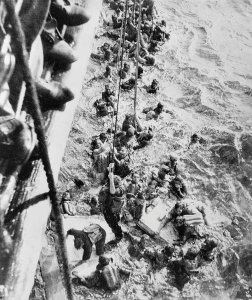
HMS Dorsetshire picking up survivors
First Officer Hans Oels ordered the men below decks to abandon ship; he instructed the engine room crews to open the ship's watertight doors and prepare scuttling charges. Gerhard Junack, the chief engineering officer, ordered his men to set the demolition charges with a 9-minute fuse but the intercom system broke down and he sent a messenger to confirm the order to scuttle the ship. The messenger never returned and Junack primed the charges and ordered the crew to abandon the ship. Junack and his comrades heard the demolition charges detonate as they made their way up through the various levels. Oels rushed throughout the ship, ordering men to abandon their posts. After he reached the deck a huge explosion killed him and about a hundred others.
The four British ships fired more than 2,800 shells at Bismarck, and scored more than 400 hits, but were unable to sink Bismarck by gunfire. At around 10:20, running low on fuel, Tovey ordered the cruiser Dorsetshire to sink Bismarck with torpedoes and sent his battleships back to port. Dorsetshire fired a pair of torpedoes into Bismarck's starboard side, one of which hit. Dorsetshire then moved around to her port side and fired another torpedo, which also hit. By the time these torpedo attacks took place, the ship was already listing so badly that the deck was partly awash. It appears that the final torpedo may have detonated against Bismarck's port side superstructure, which was by then already underwater. Around 10:35, Bismarck capsized to port and slowly sank by the stern, disappearing from the surface at 10:40. Some survivors reported they saw Captain Lindemann standing at attention at the stem of the ship as she sank.
Junack, who had abandoned ship by the time it capsized, observed no underwater damage to the ship's starboard side. Von Müllenheim-Rechberg reported the same but assumed that the port side, which was then under water, had been more significantly damaged. Around 400 men were now in the water; Dorsetshire and the destroyer Maori moved in and lowered ropes to pull the survivors aboard. At 11:40, Dorsetshire's captain ordered the rescue effort abandoned after lookouts spotted what they thought was a U-boat. Dorsetshire had rescued 85 men and Maori had picked up 25 by the time they left the scene. A U-boat later reached the survivors and found three men, and a German trawler rescued another two. One of the men picked up by the British died of his wounds the following day. Out of a crew of over 2,200 men, only 114 survived.
In 1959, C. S. Forester published his novel Last Nine Days of the Bismarck. The book was adapted for the movie Sink the Bismarck!, released the following year. For dramatic effect the film showed Bismarck sinking a British destroyer and shooting down two aircraft, neither of which happened. That same year, Johnny Horton released the song "Sink the Bismark".

 en.wikipedia.org
en.wikipedia.org
27 May 1941 - German battleship Bismarck was scuttled by her crew, and sank with heavy loss of life
Part III
Chase

Map showing the course of Bismarck and the ships that pursued her
After the engagement, Lütjens reported, "Battlecruiser, probably Hood, sunk. Another battleship, King George V or Renown, turned away damaged. Two heavy cruisers maintain contact." At 08:01, he transmitted a damage report and his intentions to OKM, which were to detach Prinz Eugen for commerce raiding and to make for Saint-Nazaire for repairs. Shortly after 10:00, Lütjens ordered Prinz Eugen to fall behind Bismarck to determine the severity of the oil leakage from the bow hit. After confirming "broad streams of oil on both sides of [Bismarck's] wake", Prinz Eugen returned to the forward position. About an hour later, a British Short Sunderland flying boat reported the oil slick to Suffolk and Norfolk, which had been joined by the damaged Prince of Wales. Rear Admiral Frederic Wake-Walker, the commander of the two cruisers, ordered Prince of Wales to remain behind his ships.
The Royal Navy ordered all warships in the area to join the pursuit of Bismarck and Prinz Eugen. Tovey's Home Fleet was steaming to intercept the German raiders, but on the morning of 24 May was still over 350 nmi (650 km; 400 mi) away. The Admiralty ordered the light cruisers Manchester, Birmingham, and Arethusa to patrol the Denmark Strait in the event that Lütjens attempted to retrace his route. The battleship Rodney, which had been escorting RMS Britannic and was due for a refit in the Boston Navy Yard, joined Tovey. Two old Revenge-class battleships were ordered into the hunt: Revenge, from Halifax, and Ramillies, which was escorting Convoy HX 127. In all, six battleships and battlecruisers, two aircraft carriers, thirteen cruisers, and twenty-one destroyers were committed to the chase. By around 17:00, the crew aboard Prince of Wales restored nine of her ten main guns to working order, which permitted Wake-Walker to place her in the front of his formation to attack Bismarck if the opportunity arose.
With the weather worsening, Lütjens attempted to detach Prinz Eugen at 16:40. The squall was not heavy enough to cover her withdrawal from Wake-Walker's cruisers, which continued to maintain radar contact. Prinz Eugen was therefore recalled temporarily. The cruiser was successfully detached at 18:14. Bismarck turned around to face Wake-Walker's formation, forcing Suffolk to turn away at high speed. Prince of Wales fired twelve salvos at Bismarck, which responded with nine salvos, none of which hit. The action diverted British attention and permitted Prinz Eugen to slip away. After Bismarck resumed her previous heading, Wake-Walker's three ships took up station on Bismarck's port side.
Although Bismarck had been damaged in the engagement and forced to reduce speed, she was still capable of reaching 27 to 28 knots (50 to 52 km/h; 31 to 32 mph), the maximum speed of Tovey's King George V. Unless Bismarck could be slowed, the British would be unable to prevent her from reaching Saint-Nazaire. Shortly before 16:00 on 25 May, Tovey detached the aircraft carrier Victorious and four light cruisers to shape a course that would position her to launch her torpedo bombers. At 22:00, Victorious launched the strike, which comprised six Fairey Fulmar fighters and nine Fairey Swordfish torpedo bombers of 825 Naval Air Squadron, led by Lt Cdr Eugene Esmonde. The inexperienced aviators nearly attacked Norfolk and the U.S. Coast Guard cutter USCGC Modoc on their approach; the confusion alerted Bismarck's anti-aircraft gunners.
Bismarck also used her main and secondary batteries to fire at maximum depression to create giant splashes in the paths of the incoming torpedo bombers. None of the attacking aircraft were shot down. Bismarck evaded eight of the torpedoes launched at her, but the ninth struck amidships on the main armoured belt, throwing one man into a bulkhead and killing him and injuring five others. The explosion also caused minor damage to electrical equipment. The ship suffered more serious damage from manoeuvres to evade the torpedoes: rapid shifts in speed and course loosened collision mats, which increased the flooding from the forward shell hole and eventually forced abandonment of the port number 2 boiler room. This loss of a second boiler, combined with fuel losses and increasing bow trim, forced the ship to slow to 16 knots (30 km/h; 18 mph). Divers repaired the collision mats in the bow, after which speed increased to 20 knots (37 km/h; 23 mph), the speed that the command staff determined was the most economical for the voyage to occupied France.
Shortly after the Swordfish departed the scene, Bismarck and Prince of Wales engaged in a brief artillery duel. Neither scored a hit. Bismarck's damage control teams resumed work after the short engagement. The sea water that had flooded the number 2 port side boiler threatened to enter the number 4 turbo-generator feedwater system, which would have permitted saltwater to reach the turbines. The saltwater would have damaged the turbine blades and thus greatly reduced the ship's speed. By morning on 25 May, the danger had passed. The ship slowed to 12 knots (22 km/h; 14 mph) to allow divers to pump fuel from the forward compartments to the rear tanks; two hoses were successfully connected and a few hundred tons of fuel were transferred.
As the chase entered open waters, Wake-Walker's ships were compelled to zig-zag to avoid German U-boats that might be in the area. This required the ships to steam for ten minutes to port, then ten minutes to starboard, to keep the ships on the same base course. For the last few minutes of the turn to port, Bismarck was out of range of Suffolk's radar. At 03:00 on 25 May, Lütjens ordered an increase to maximum speed, which at this point was 28 knots (52 km/h; 32 mph). He then ordered the ship to circle away to the west and then north. This manoeuvre coincided with the period during which his ship was out of radar range; Bismarck successfully broke radar contact and circled back behind her pursuers. Suffolk's captain assumed that Bismarck had broken off to the west and attempted to find her by also steaming west. After half an hour, he informed Wake-Walker, who ordered the three ships to disperse at daylight to search visually.
The Royal Navy search became frantic, as many of the British ships were low on fuel. Victorious and her escorting cruisers were sent west, Wake-Walker's ships continued to the south and west, and Tovey continued to steam toward the mid-Atlantic. Force H, with the aircraft carrier Ark Royal and steaming up from Gibraltar, was still at least a day away. Unaware that he had shaken off Wake-Walker, Lütjens sent long radio messages to Naval Group West headquarters in Paris. The signals were intercepted by the British, from which bearings were determined. They were wrongly plotted on board King George V, leading Tovey to believe that Bismarck was heading back to Germany through the Iceland-Faeroe gap, which kept his fleet on the wrong course for seven hours. By the time the mistake had been discovered, Bismarck had put a sizeable gap between herself and the British ships.

The aircraft carrier HMS Ark Royal with a flight of Swordfish overhead
British code-breakers were able to decrypt some of the German signals, including an order to the Luftwaffe to provide support for Bismarck making for Brest, decrypted by Jane Fawcett on 25 May 1941. The French Resistance provided the British with confirmation that Luftwaffe units were relocating there. Tovey could now turn his forces toward France to converge in areas through which Bismarck would have to pass. A squadron of Coastal Command PBY Catalinas based in Northern Ireland joined the search, covering areas where Bismarck might head in the attempt to reach occupied France. At 10:30 on 26 May, a Catalina piloted by Ensign Leonard B. Smith of the US Navy located her, some 690 nmi (1,280 km; 790 mi) northwest of Brest. At her current speed, she would have been close enough to reach the protection of U-boats and the Luftwaffe in less than a day. Most British forces were not close enough to stop her.
The only possibility for the Royal Navy was Ark Royal with Force H, under the command of Admiral James Somerville. Victorious, Prince of Wales, Suffolk and Repulse were forced to break off the search due to fuel shortage; the only heavy ships remaining apart from Force H were King George V and Rodney, but they were too distant. Ark Royal's Swordfish were already searching nearby when the Catalina found her. Several torpedo bombers also located the battleship, about 60 nmi (110 km; 69 mi) away from Ark Royal. Somerville ordered an attack as soon as the Swordfish returned and were rearmed with torpedoes. He detached the cruiser Sheffield to shadow Bismarck, though Ark Royal's aviators were not informed of this. As a result, the Swordfish, which were armed with torpedoes equipped with new magnetic detonators, accidentally attacked Sheffield. The magnetic detonators failed to work properly and Sheffield emerged unscathed.

A Swordfish returns to Ark Royal after making the torpedo attack against Bismarck
Upon returning to Ark Royal, the Swordfish loaded torpedoes equipped with contact detonators. The second attack comprised fifteen aircraft and was launched at 19:10. At 20:47, the torpedo bombers began their attack descent through the clouds. As the Swordfish approached, Bismarck fired her main battery at Sheffield, straddling the cruiser with her second salvo. Shell fragments rained down on Sheffield, killing three men and wounding several others. Sheffield quickly retreated under cover of a smoke screen. The Swordfish then attacked; Bismarck began to turn violently as her anti-aircraft batteries engaged the bombers. One torpedo hit amidships on the port side, just below the bottom edge of the main armour belt. The force of the explosion was largely contained by the underwater protection system and the belt armour but some structural damage caused minor flooding.
The second torpedo struck Bismarck in her stern on the port side, near the port rudder shaft. The coupling on the port rudder assembly was badly damaged and the rudder became locked in a 12° turn to port. The explosion also caused much shock damage. The crew eventually managed to repair the starboard rudder but the port rudder remained jammed. A suggestion to sever the port rudder with explosives was dismissed by Lütjens, as damage to the screws would have left the battleship helpless. At 21:15, Lütjens reported that the ship was unmanoeuvrable.
Sinking
With the port rudder jammed, Bismarck was now steaming in a large circle, unable to escape from Tovey's forces. Though fuel shortages had reduced the number of ships available to the British, the battleships King George V and Rodney were still available, along with the heavy cruisers Dorsetshire and Norfolk. Lütjens signalled headquarters at 21:40 on the 26th: "Ship unmanoeuvrable. We will fight to the last shell. Long live the Führer." The mood of the crew became increasingly depressed, especially as messages from the naval command reached the ship. Intended to boost morale, the messages only highlighted the desperate situation in which the crew found itself. As darkness fell, Bismarck briefly fired on Sheffield, though the cruiser quickly fled. Sheffield lost contact in the low visibility and Captain Philip Vian's group of five destroyers was ordered to keep contact with Bismarck through the night.
The ships encountered Bismarck at 22:38; the battleship quickly engaged them with her main battery. After firing three salvos, she straddled the Polish destroyer ORP Piorun. The destroyer continued to close the range until a near miss at around 12,000 m (39,000 ft) forced her to turn away. Throughout the night and into the morning, Vian's destroyers harried Bismarck, illuminating her with star shells and firing dozens of torpedoes, none of which hit. Between 05:00 and 06:00, Bismarck's crew attempted to launch one of the Arado 196 float planes to carry away the ship's war diary, footage of the engagement with Hood, and other important documents. The third shell hit from Prince of Wales had damaged the steam line on the aircraft catapult, rendering it inoperative. As it was not possible to launch the aircraft it had become a fire hazard, and was pushed overboard.

Rodney firing on Bismarck, which can be seen burning in the distance
After daybreak on 27 May, King George V led the attack. Rodney followed off her port quarter; Tovey intended to steam directly at Bismarck until he was about 8 nmi (15 km; 9.2 mi) away. At that point, he would turn south to put his ships parallel to his target. At 08:43, lookouts on King George V spotted her, some 23,000 m (25,000 yd) away. Four minutes later, Rodney's two forward turrets, comprising six 16 in (406 mm) guns, opened fire, then King George V's 14 in (356 mm) guns began firing. Bismarck returned fire at 08:50 with her forward guns; with her second salvo, she straddled Rodney. Thereafter, Bismarck's ability to aim her guns deteriorated as the ship, unable to steer, moved erratically in the heavy seas and deprived Schneider of a predictable course for range calculations.
As the range fell, the ships' secondary batteries joined the battle. Norfolk and Dorsetshire closed and began firing with their 8 in (203 mm) guns. At 09:02, a 16-inch shell from Rodney struck Bismarck's forward superstructure, killing hundreds of men and severely damaging the two forward turrets. According to survivors, this salvo probably killed both Lindemann and Lütjens and the rest of the bridge staff. The main fire control director was also destroyed by this hit, which probably also killed Schneider. A second shell from this salvo struck the forward main battery, which was disabled, though it would manage to fire one last salvo at 09:27. Lieutenant von Müllenheim-Rechberg, in the rear control station, took over firing control for the rear turrets. He managed to fire three salvos before a shell destroyed the gun director, disabling his equipment. He gave the order for the guns to fire independently, but by 09:31, all four main battery turrets had been put out of action. One of Bismarck's shells exploded 20 feet off Rodney's bow and damaged her starboard torpedo tube—the closest Bismarck came to a direct hit on her opponents.
By 10:00, Tovey's two battleships had fired over 700 main battery shells, many at very close range; Bismarck had been reduced to a shambles, aflame from stem to stern. She was slowly settling by the stern from uncontrolled flooding with a 20 degree list to port. Rodney closed to 2,700 m (3,000 yd), point-blank range for guns of that size, and continued to fire. Tovey could not cease fire until the Germans struck their ensigns or it became clear they were abandoning ship. Rodney fired two torpedoes from her port-side tube and claimed one hit. According to Ludovic Kennedy, "if true, [this is] the only instance in history of one battleship torpedoing another".

HMS Dorsetshire picking up survivors
First Officer Hans Oels ordered the men below decks to abandon ship; he instructed the engine room crews to open the ship's watertight doors and prepare scuttling charges. Gerhard Junack, the chief engineering officer, ordered his men to set the demolition charges with a 9-minute fuse but the intercom system broke down and he sent a messenger to confirm the order to scuttle the ship. The messenger never returned and Junack primed the charges and ordered the crew to abandon the ship. Junack and his comrades heard the demolition charges detonate as they made their way up through the various levels. Oels rushed throughout the ship, ordering men to abandon their posts. After he reached the deck a huge explosion killed him and about a hundred others.
The four British ships fired more than 2,800 shells at Bismarck, and scored more than 400 hits, but were unable to sink Bismarck by gunfire. At around 10:20, running low on fuel, Tovey ordered the cruiser Dorsetshire to sink Bismarck with torpedoes and sent his battleships back to port. Dorsetshire fired a pair of torpedoes into Bismarck's starboard side, one of which hit. Dorsetshire then moved around to her port side and fired another torpedo, which also hit. By the time these torpedo attacks took place, the ship was already listing so badly that the deck was partly awash. It appears that the final torpedo may have detonated against Bismarck's port side superstructure, which was by then already underwater. Around 10:35, Bismarck capsized to port and slowly sank by the stern, disappearing from the surface at 10:40. Some survivors reported they saw Captain Lindemann standing at attention at the stem of the ship as she sank.
Junack, who had abandoned ship by the time it capsized, observed no underwater damage to the ship's starboard side. Von Müllenheim-Rechberg reported the same but assumed that the port side, which was then under water, had been more significantly damaged. Around 400 men were now in the water; Dorsetshire and the destroyer Maori moved in and lowered ropes to pull the survivors aboard. At 11:40, Dorsetshire's captain ordered the rescue effort abandoned after lookouts spotted what they thought was a U-boat. Dorsetshire had rescued 85 men and Maori had picked up 25 by the time they left the scene. A U-boat later reached the survivors and found three men, and a German trawler rescued another two. One of the men picked up by the British died of his wounds the following day. Out of a crew of over 2,200 men, only 114 survived.
In 1959, C. S. Forester published his novel Last Nine Days of the Bismarck. The book was adapted for the movie Sink the Bismarck!, released the following year. For dramatic effect the film showed Bismarck sinking a British destroyer and shooting down two aircraft, neither of which happened. That same year, Johnny Horton released the song "Sink the Bismark".

German battleship Bismarck - Wikipedia
Today in Naval History - Naval / Maritime Events in History
27 May 1941 - German battleship Bismarck was scuttled by her crew, and sank with heavy loss of life
Part IV
Wreckage
Discovery by Robert Ballard
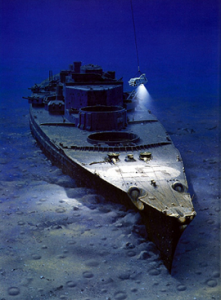
Painting by Ken Marschalldepicting Argo exploring the wreck
The wreck of Bismarck was discovered on 8 June 1989 by Dr. Robert Ballard, the oceanographer responsible for finding RMS Titanic. Bismarck was found to be resting on its keel at a depth of approximately 4,791 m (15,719 ft), about 650 km (400 mi) west of Brest. The ship struck an extinct underwater volcano, which rose some 1,000 m (3,300 ft) above the surrounding abyssal plain, triggering a 2 km (1.2 mi) landslide. Bismarck slid down the mountain, coming to a stop two-thirds down.
Ballard's survey found no underwater penetrations of the ship's fully armoured citadel. Eight holes were found in the hull, one on the starboard side and seven on the port side, all above the waterline. One of the holes is in the deck, on the bow's starboard side. The angle and shape indicates the shell that created the hole was fired from Bismarck's port side and struck the starboard anchor chain. The anchor chain has disappeared down this hole. Six holes are amidships, three shell fragments pierced the upper splinter belt, and one made a hole in the main armour belt. Further aft a huge hole is visible, parallel to the aircraft catapult, on the deck. The submersibles recorded no sign of a shell penetration through the main or side armour here, and it is likely that the shell penetrated the deck armour only. Huge dents showed that many of the 14 inch shells fired by King George V bounced off the German belt armour.
Ballard noted that he found no evidence of the internal implosions that occur when a hull that is not fully flooded sinks. The surrounding water, which has much greater pressure than the air in the hull, would crush the ship. Instead, Ballard points out that the hull is in relatively good condition; he states simply that "Bismarck did not implode." This suggests that Bismarck's compartments were flooded when the ship sank, supporting the scuttling theory. Ballard added "we found a hull that appears whole and relatively undamaged by the descent and impact". They concluded that the direct cause of sinking was scuttling: sabotage of engine-room valves by her crew, as claimed by German survivors. Ballard kept the wreck's exact location a secret to prevent other divers from taking artefacts from the ship, a practice he considered a form of grave robbing.
The whole stern had broken away; as it was not near the main wreckage and has not yet been found, it can be assumed this did not occur on impact with the sea floor. The missing section came away roughly where the torpedo had hit, raising questions of possible structural failure. The stern area had also received several hits, increasing the torpedo damage. This, coupled with the fact the ship sank "stern first" and had no structural support to hold it in place, suggests the stern detached at the surface. In 1942 Prinz Eugen was also torpedoed in the stern, which collapsed. This prompted a strengthening of the stern structures on all German capital ships.
Subsequent expeditions
In June 2001, Deep Ocean Expeditions, partnered with Woods Hole Oceanographic Institution, conducted another investigation of the wreck. The researchers used Russian-built mini-submarines. William N. Lange, a Woods Hole expert, stated, "You see a large number of shell holes in the superstructure and deck, but not that many along the side, and none below the waterline." The expedition found no penetrations in the main armoured belt, above or below the waterline. The examiners noted several long gashes in the hull, but attributed these to impact on the sea floor.
An Anglo-American expedition in July 2001 was funded by a British TV channel. The team used the volcano—the only one in that area—to locate the wreck. Using ROVs to film the hull, the team concluded that the ship had sunk due to combat damage. Expedition leader David Mearns claimed significant gashes had been found in the hull: "My feeling is that those holes were probably lengthened by the slide, but initiated by torpedoes".
The 2002 documentary Expedition: Bismarck, directed by James Cameron and filmed in May–June 2002 using smaller and more agile Mir submersibles, reconstructed the events leading to the sinking. These provided the first interior shots. His findings were that there was not enough damage below the waterline to confirm that she had been sunk rather than scuttled. Close inspection of the wreckage confirmed that none of the torpedoes or shells had penetrated the second layer of the inner hull. Using small ROVs to examine the interior, Cameron discovered that the torpedo blasts had failed to shatter the torpedo bulkheads.
Despite their sometimes differing viewpoints, these experts generally agree that Bismarck would have eventually foundered if the Germans had not scuttled her first. Ballard estimated that Bismarck could still have floated for at least a day when the British vessels ceased fire and could have been captured by the Royal Navy, a position supported by the historian Ludovic Kennedy (who was serving on the destroyer HMS Tartar at the time). Kennedy stated, "That she would have foundered eventually there can be little doubt; but the scuttling ensured that it was sooner rather than later." When asked whether Bismarck would have sunk if the Germans had not scuttled the ship, Cameron replied "Sure. But it might have taken half a day." In Mearns' subsequent book Hood and Bismarck, he conceded that scuttling "may have hastened the inevitable, but only by a matter of minutes." Ballard later concluded that "As far as I was concerned, the British had sunk the ship regardless of who delivered the final blow."
See also

 en.wikipedia.org
en.wikipedia.org
27 May 1941 - German battleship Bismarck was scuttled by her crew, and sank with heavy loss of life
Part IV
Wreckage
Discovery by Robert Ballard

Painting by Ken Marschalldepicting Argo exploring the wreck
The wreck of Bismarck was discovered on 8 June 1989 by Dr. Robert Ballard, the oceanographer responsible for finding RMS Titanic. Bismarck was found to be resting on its keel at a depth of approximately 4,791 m (15,719 ft), about 650 km (400 mi) west of Brest. The ship struck an extinct underwater volcano, which rose some 1,000 m (3,300 ft) above the surrounding abyssal plain, triggering a 2 km (1.2 mi) landslide. Bismarck slid down the mountain, coming to a stop two-thirds down.
Ballard's survey found no underwater penetrations of the ship's fully armoured citadel. Eight holes were found in the hull, one on the starboard side and seven on the port side, all above the waterline. One of the holes is in the deck, on the bow's starboard side. The angle and shape indicates the shell that created the hole was fired from Bismarck's port side and struck the starboard anchor chain. The anchor chain has disappeared down this hole. Six holes are amidships, three shell fragments pierced the upper splinter belt, and one made a hole in the main armour belt. Further aft a huge hole is visible, parallel to the aircraft catapult, on the deck. The submersibles recorded no sign of a shell penetration through the main or side armour here, and it is likely that the shell penetrated the deck armour only. Huge dents showed that many of the 14 inch shells fired by King George V bounced off the German belt armour.
Ballard noted that he found no evidence of the internal implosions that occur when a hull that is not fully flooded sinks. The surrounding water, which has much greater pressure than the air in the hull, would crush the ship. Instead, Ballard points out that the hull is in relatively good condition; he states simply that "Bismarck did not implode." This suggests that Bismarck's compartments were flooded when the ship sank, supporting the scuttling theory. Ballard added "we found a hull that appears whole and relatively undamaged by the descent and impact". They concluded that the direct cause of sinking was scuttling: sabotage of engine-room valves by her crew, as claimed by German survivors. Ballard kept the wreck's exact location a secret to prevent other divers from taking artefacts from the ship, a practice he considered a form of grave robbing.
The whole stern had broken away; as it was not near the main wreckage and has not yet been found, it can be assumed this did not occur on impact with the sea floor. The missing section came away roughly where the torpedo had hit, raising questions of possible structural failure. The stern area had also received several hits, increasing the torpedo damage. This, coupled with the fact the ship sank "stern first" and had no structural support to hold it in place, suggests the stern detached at the surface. In 1942 Prinz Eugen was also torpedoed in the stern, which collapsed. This prompted a strengthening of the stern structures on all German capital ships.
Subsequent expeditions
In June 2001, Deep Ocean Expeditions, partnered with Woods Hole Oceanographic Institution, conducted another investigation of the wreck. The researchers used Russian-built mini-submarines. William N. Lange, a Woods Hole expert, stated, "You see a large number of shell holes in the superstructure and deck, but not that many along the side, and none below the waterline." The expedition found no penetrations in the main armoured belt, above or below the waterline. The examiners noted several long gashes in the hull, but attributed these to impact on the sea floor.
An Anglo-American expedition in July 2001 was funded by a British TV channel. The team used the volcano—the only one in that area—to locate the wreck. Using ROVs to film the hull, the team concluded that the ship had sunk due to combat damage. Expedition leader David Mearns claimed significant gashes had been found in the hull: "My feeling is that those holes were probably lengthened by the slide, but initiated by torpedoes".
The 2002 documentary Expedition: Bismarck, directed by James Cameron and filmed in May–June 2002 using smaller and more agile Mir submersibles, reconstructed the events leading to the sinking. These provided the first interior shots. His findings were that there was not enough damage below the waterline to confirm that she had been sunk rather than scuttled. Close inspection of the wreckage confirmed that none of the torpedoes or shells had penetrated the second layer of the inner hull. Using small ROVs to examine the interior, Cameron discovered that the torpedo blasts had failed to shatter the torpedo bulkheads.
Despite their sometimes differing viewpoints, these experts generally agree that Bismarck would have eventually foundered if the Germans had not scuttled her first. Ballard estimated that Bismarck could still have floated for at least a day when the British vessels ceased fire and could have been captured by the Royal Navy, a position supported by the historian Ludovic Kennedy (who was serving on the destroyer HMS Tartar at the time). Kennedy stated, "That she would have foundered eventually there can be little doubt; but the scuttling ensured that it was sooner rather than later." When asked whether Bismarck would have sunk if the Germans had not scuttled the ship, Cameron replied "Sure. But it might have taken half a day." In Mearns' subsequent book Hood and Bismarck, he conceded that scuttling "may have hastened the inevitable, but only by a matter of minutes." Ballard later concluded that "As far as I was concerned, the British had sunk the ship regardless of who delivered the final blow."
See also
- Unsinkable Sam – cat which is said to have survived the sinking of Bismarck

German battleship Bismarck - Wikipedia
Today in Naval History - Naval / Maritime Events in History
Other Events on 27 May
1692 - May 27-June 3 (NS) Barfleur and La Hougue - Decisive defeat of French by English and Dutch in the War of the Grand Alliance
https://en.wikipedia.org/wiki/Battles_of_Barfleur_and_La_Hougue
1743 – Launch of Spanish Reina 70 (launched 27 May 1743 at Havana) - Captured by Britain 1762, same name, sold 1775
Reina class, 70 guns
Reina 70 (launched 27 May 1743 at Havana) - Captured by Britain 1762, same name, sold 1775
Invencible (San Jose) 70 (launched 19 December 1743 at Havana) - Burnt 1750
1744 – Launch of French Fine, (launched 27 May 1744 at Le Havre) – wrecked December 1745 off Montrose.
Fine class (28-gun design by Pierre Chaillé, with 24 x 8-pdrs and 4 x 4-pounder guns).
Fine, (launched 27 May 1744 at Le Havre) – wrecked December 1745 off Montrose.
Emeraude, (launched 10 June 1744 at Le Havre) – captured by British Navy 21 September 1757, becoming HMS Emerald.
Sistership https://en.wikipedia.org/wiki/HMS_Emerald_(1757)
1782 – Launch of Danaé, 38 guns (launched 27 May 1782 at Lorient) – deleted 1796 or later.
Danaé class, (36/38-gun design by Charles Segonday-Duvernet, with 26 x 18-pdr guns initially, although by 1793 carried 28 x 18-pdr guns, plus 10 x 8-pdr guns on the gaillards and 4 obusiers).) The Danaé, the prototype, differed somewhat from the other pair).
Danaé, 38 guns (launched 27 May 1782 at Lorient) – deleted 1796 or later.
Méduse, 38 guns (launched 18 November 1782 at Lorient) – burnt by accident 1797.
Didon, 38 guns (launched 20 August 1785 at Lorient) – burnt at Guadeloupe 1792.
1808 – Launch of French Polonais was a Téméraire class 74-gun ship of the line of the French Navy.
Polonais was a Téméraire class 74-gun ship of the line of the French Navy.
First named Glorieux, she was renamed on 23 February 1807.
In 1809, under Captain Mequet, she departed Lorient, France with Troude's squadron, bound for the Caribbean. The squadron included Hautpoult and Courageux. On 29 March, the ships arrived at the Saintes and landed reinforcements.
On 29 May, Polonais and Courageux reached Cherbourg, France along with seven prize ships captured on the way. Hautpoult had been captured in the Action of 14–17 April 1809.
In April 1814, at the Bourbon Restoration, Polonais was renamed Lys captained by Troude. She then ferried Louis XVIII back to France. She was briefly renamed Polonais during the Hundred Days of Napoleon, and then back to Lys again.
After the Bourbon Restoration, Lys was sent to retake possession of the island of Martinique, along with the frigate Érigone and the corvette Vésuve. The squadron arrived at Fort Royal on 5 October 1814.
From 1822, she was used as a storage hulk, and she was broken up in Brest on 1825.
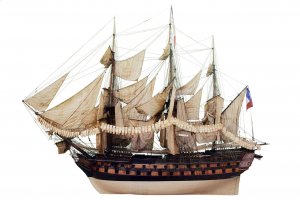

 en.wikipedia.org
en.wikipedia.org
1812 – Launch of HMS Curlew (1812) was a Royal Navy Cruizer class brig-sloop built by (William) Good & Co., at Bridport and launched in 1812.
HMS Curlew (1812) was a Royal Navy Cruizer class brig-sloop built by (William) Good & Co., at Bridport and launched in 1812.[1] She served with the Navy for only 10 years. During the War of 1812 she sailed from Halifax and captured several American privateers. Her greatest moment was her role in the 1819 British occupation of Ras al-Khaimah. Curlew was sold in 1822 in Bombay. She then had a 13 or so year career as an opium runner for James Matheson, one of the founders of the firm Jardine Matheson.
 en.wikipedia.org
en.wikipedia.org
1895 – Launch of ARA Garibaldi was one of four Giuseppe Garibaldi-class armored cruisers purchased by the Argentine Navy from Italy.
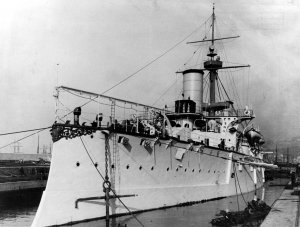
ARA Garibaldi was one of four Giuseppe Garibaldi-class armored cruisers purchased by the Argentine Navy from Italy.
Design and description
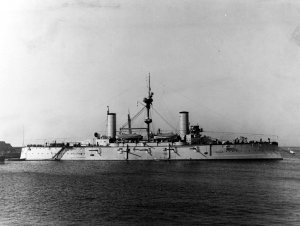
Garibaldi circa 1895
Garibaldi had an overall length of 344 feet 2 inches (104.9 m), a beam of 50 feet 8 inches (15.4 m), and a mean draft (ship) of 23 feet 4 inches (7.1 m). She displaced 6,773 metric tons (6,666 long tons) at normal load. The ship was powered by two vertical triple-expansion steam engines, each driving one shaft, using steam from eight Scotch marine boilers. The engines were designed for a maximum output of 13,000 indicated horsepower(9,700 kW) and a speed of 20 knots (37 km/h; 23 mph). She had a cruising range of 6,000 nautical miles(11,000 km; 6,900 mi) at 10 knots (19 km/h; 12 mph). Her complement consisted of 28 officers and 420 enlisted men.
Her main armament consisted of two 40-caliber Armstrong Whitworth 10-inch (254 mm) guns, in gun turrets fore and aft of the superstructure. The ten 40-caliber quick-firing (QF) 6-inch (152 mm) guns that comprised her secondary armament were arranged in casemates amidships on the main deck. Garibaldi also had six QF 4.7-inch (119 mm), ten QF 6-pounder Hotchkiss and eight QF 3-pounder Hotchkiss guns to defend herself against torpedo boats. She was also equipped with four above-water 457 mm (18.0 in) torpedo tubes, two on each side.
The ship's waterline armor belt had a maximum thickness of 5.9 inches (150 mm) amidships and tapered to 3.1 inches (79 mm) towards the ends of the ship. Between the main gun barbettes it covered the entire side of the ship up to the level of the upper deck. The barbettes, the conning tower, and gun turrets were also protected by 5.9-inch armor. Her deck armor ranged from 1 to 2 inches (25 to 51 mm) thick.
https://en.wikipedia.org/wiki/ARA_Garibaldi
https://en.wikipedia.org/wiki/Giuseppe_Garibaldi-class_cruiser
1904 – Launch of SMS Lothringen was the last of five pre-dreadnought battleships of the Braunschweig class, built for the German Kaiserliche Marine (Imperial Navy).
SMS Lothringen was the last of five pre-dreadnought battleships of the Braunschweig class, built for the German Kaiserliche Marine (Imperial Navy). She was laid down in December 1902, was launched in May 1904, and was commissioned in May 1906. She was named for the then-German province of Lothringen (now Lorraine). The ship was armed with a battery of four 28 cm (11 in) guns and had a top speed of 18 knots (33 km/h; 21 mph). Like all other pre-dreadnoughts built around the turn of the century, Lothringen was quickly made obsolete by the launching of the revolutionary HMS Dreadnought in 1906; as a result, her career as a front-line battleship was cut short.
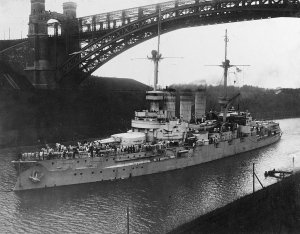
Lothringen's peacetime career centered on squadron and fleet exercises and training cruises with II Battle Squadron. Scheduled to be withdrawn from service in July 1914 and replaced by newer dreadnought battleships, the outbreak of World War I that month prevented her retirement. She spent the first two years of the war primarily serving as a guard ship in the German Bight. She and the rest of II Squadron joined the dreadnoughts of the High Seas Fleet to support the raid on Scarborough, Hartlepool, and Whitby in December 1914. In poor condition by 1916, she was withdrawn from fleet service in February. She thereafter patrolled the Danish straits until she was replaced by the battleship Hannover in September 1917. She spent the rest of the war as a disarmed training ship.
After the war, Lothringen was retained by the re-formed Reichsmarine and converted into a depot ship for F-type minesweepers from 1919 to 1920. After the task of clearing the wartime minefields in the North Sea was completed, she was placed in reserve in March 1920. The ship remained inactive for the next decade and was stricken from the naval register in March 1931 and sold to ship breakers later that year.
https://en.wikipedia.org/wiki/SMS_Lothringen

 en.wikipedia.org
en.wikipedia.org
1919 First trans-atlantic flight by NC-4 New York - Plymouth
The crew of the Curtiss flying boat NC-4 arrives at Lisbon, Portugal for a stop during its transatlantic flight to Portsmouth, England, arriving May 31.
https://en.wikipedia.org/wiki/Transatlantic_flight

 en.wikipedia.org
en.wikipedia.org
1936 - RMS Queen Mary sailed on her maiden voyage from Southhampton
The RMS Queen Mary is a retired British ocean liner that sailed primarily on the North Atlantic Ocean from 1936 to 1967 for the Cunard Line – known as Cunard-White Star Line when the vessel entered service. She was the flagship of the Cunard and White Star Lines, built by John Brown & Company in Clydebank, Scotland, Queen Mary, along with RMS Queen Elizabeth,[3] were built as part of Cunard's planned two-ship weekly express service between Southampton, Cherbourg and New York. The two ships were a British response to the express superliners built by German, Italian and French companies in the late 1920s and early 1930s. Queen Mary was the flagship of the Cunard Line from May 1936 until October 1946 when she was replaced in that role by Queen Elizabeth.
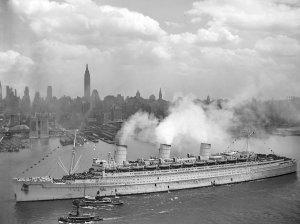
Queen Mary sailed on her maiden voyage on 27 May 1936 and won the Blue Riband that August;[4] she lost the title to SS Normandie in 1937 and recaptured it in 1938, holding it until 1952 when she was beaten by the new SS United States. With the outbreak of the Second World War, she was converted into a troopship and ferried Allied soldiers during the war.
Following the war, Queen Mary was refitted for passenger service and along with Queen Elizabeth commenced the two-ship transatlantic passenger service for which the two ships were initially built. The two ships dominated the transatlantic passenger transportation market until the dawn of the jet agein the late 1950s. By the mid-1960s, Queen Mary was ageing and, though still among the most popular transatlantic liners, was operating at a loss.
After several years of decreased profits for Cunard Line, Queen Mary was officially retired from service in 1967. She left Southampton for the last time on 31 October 1967 and sailed to the port of Long Beach, California, United States, where she remains permanently moored. Much of the machinery, including one of the two engine rooms, three of the four propellers, and all of the boilers, were removed. The ship serves as a tourist attraction featuring restaurants, a museum and a hotel. The ship is listed on the National Register of Historic Places. The National Trust for Historic Preservation has accepted the Queen Mary as part of the Historic Hotels of America

 en.wikipedia.org
en.wikipedia.org
1941 - HMS Mashona – On 27 May 1941 the British destroyer came under heavy Luftwaffe attack while returning to port. She was bombed and sunk off the coast of Galway, killing 48 men.
https://en.wikipedia.org/wiki/HMS_Mashona_(F59)
1943 - USS Runner (SS 275) departs Midway for her third war patrol but is never heard from again. Overdue and presumed lost in July 1943, she is struck from the Navy list that October.
1945 - USS Tench (SS 417) sinks Japanese freighter Kinei Maru off Kushiro Light, and USS Tigrone (SS 419) sinks Japanese guardboat No.3 Yawata Maru off Tori Jima.
1967 – The U.S. Navy aircraft carrier USS John F. Kennedy is launched by Jacqueline Kennedy and her daughter Caroline.
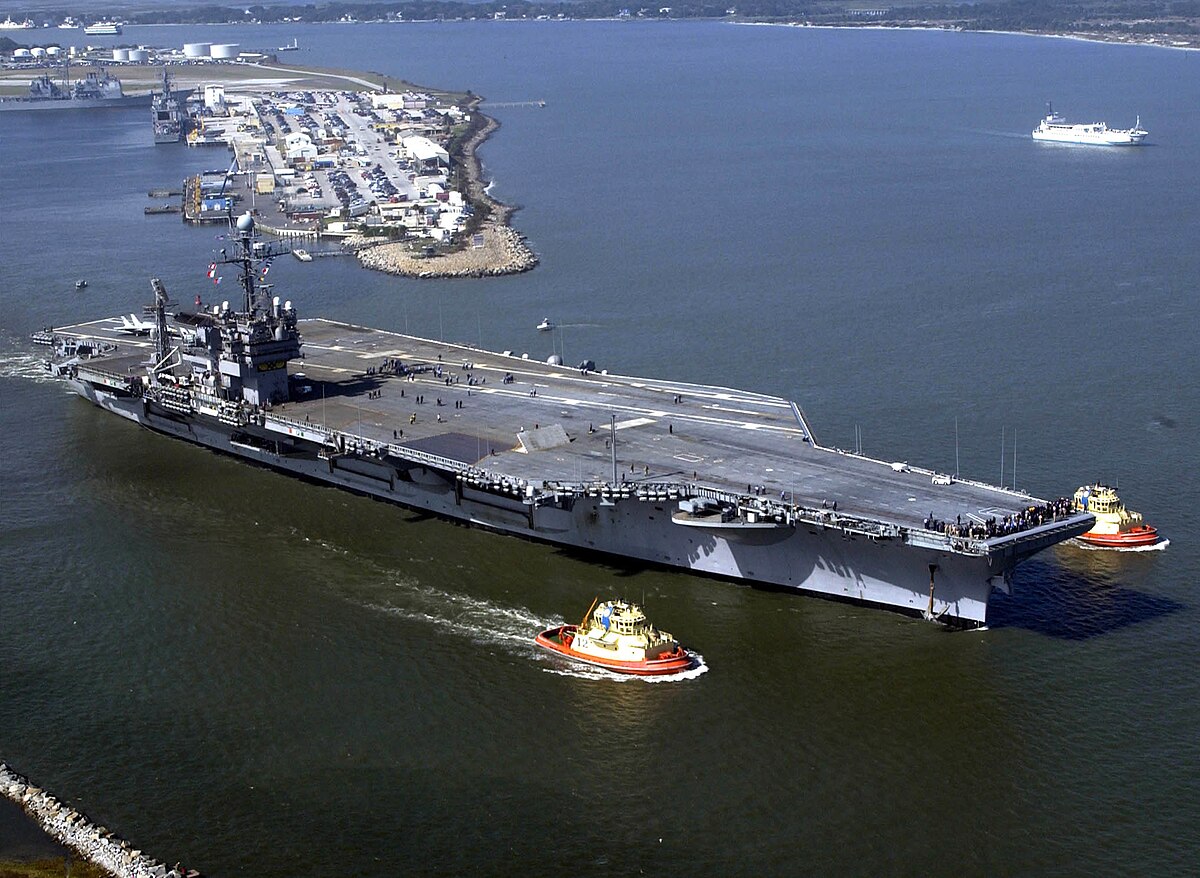
 en.wikipedia.org
en.wikipedia.org
Other Events on 27 May
1692 - May 27-June 3 (NS) Barfleur and La Hougue - Decisive defeat of French by English and Dutch in the War of the Grand Alliance
https://en.wikipedia.org/wiki/Battles_of_Barfleur_and_La_Hougue
1743 – Launch of Spanish Reina 70 (launched 27 May 1743 at Havana) - Captured by Britain 1762, same name, sold 1775
Reina class, 70 guns
Reina 70 (launched 27 May 1743 at Havana) - Captured by Britain 1762, same name, sold 1775
Invencible (San Jose) 70 (launched 19 December 1743 at Havana) - Burnt 1750
1744 – Launch of French Fine, (launched 27 May 1744 at Le Havre) – wrecked December 1745 off Montrose.
Fine class (28-gun design by Pierre Chaillé, with 24 x 8-pdrs and 4 x 4-pounder guns).
Fine, (launched 27 May 1744 at Le Havre) – wrecked December 1745 off Montrose.
Emeraude, (launched 10 June 1744 at Le Havre) – captured by British Navy 21 September 1757, becoming HMS Emerald.
Sistership https://en.wikipedia.org/wiki/HMS_Emerald_(1757)
1782 – Launch of Danaé, 38 guns (launched 27 May 1782 at Lorient) – deleted 1796 or later.
Danaé class, (36/38-gun design by Charles Segonday-Duvernet, with 26 x 18-pdr guns initially, although by 1793 carried 28 x 18-pdr guns, plus 10 x 8-pdr guns on the gaillards and 4 obusiers).) The Danaé, the prototype, differed somewhat from the other pair).
Danaé, 38 guns (launched 27 May 1782 at Lorient) – deleted 1796 or later.
Méduse, 38 guns (launched 18 November 1782 at Lorient) – burnt by accident 1797.
Didon, 38 guns (launched 20 August 1785 at Lorient) – burnt at Guadeloupe 1792.
1808 – Launch of French Polonais was a Téméraire class 74-gun ship of the line of the French Navy.
Polonais was a Téméraire class 74-gun ship of the line of the French Navy.
First named Glorieux, she was renamed on 23 February 1807.
In 1809, under Captain Mequet, she departed Lorient, France with Troude's squadron, bound for the Caribbean. The squadron included Hautpoult and Courageux. On 29 March, the ships arrived at the Saintes and landed reinforcements.
On 29 May, Polonais and Courageux reached Cherbourg, France along with seven prize ships captured on the way. Hautpoult had been captured in the Action of 14–17 April 1809.
In April 1814, at the Bourbon Restoration, Polonais was renamed Lys captained by Troude. She then ferried Louis XVIII back to France. She was briefly renamed Polonais during the Hundred Days of Napoleon, and then back to Lys again.
After the Bourbon Restoration, Lys was sent to retake possession of the island of Martinique, along with the frigate Érigone and the corvette Vésuve. The squadron arrived at Fort Royal on 5 October 1814.
From 1822, she was used as a storage hulk, and she was broken up in Brest on 1825.


French ship Polonais (1808) - Wikipedia
1812 – Launch of HMS Curlew (1812) was a Royal Navy Cruizer class brig-sloop built by (William) Good & Co., at Bridport and launched in 1812.
HMS Curlew (1812) was a Royal Navy Cruizer class brig-sloop built by (William) Good & Co., at Bridport and launched in 1812.[1] She served with the Navy for only 10 years. During the War of 1812 she sailed from Halifax and captured several American privateers. Her greatest moment was her role in the 1819 British occupation of Ras al-Khaimah. Curlew was sold in 1822 in Bombay. She then had a 13 or so year career as an opium runner for James Matheson, one of the founders of the firm Jardine Matheson.
HMS Curlew (1812) - Wikipedia
1895 – Launch of ARA Garibaldi was one of four Giuseppe Garibaldi-class armored cruisers purchased by the Argentine Navy from Italy.

ARA Garibaldi was one of four Giuseppe Garibaldi-class armored cruisers purchased by the Argentine Navy from Italy.
Design and description

Garibaldi circa 1895
Garibaldi had an overall length of 344 feet 2 inches (104.9 m), a beam of 50 feet 8 inches (15.4 m), and a mean draft (ship) of 23 feet 4 inches (7.1 m). She displaced 6,773 metric tons (6,666 long tons) at normal load. The ship was powered by two vertical triple-expansion steam engines, each driving one shaft, using steam from eight Scotch marine boilers. The engines were designed for a maximum output of 13,000 indicated horsepower(9,700 kW) and a speed of 20 knots (37 km/h; 23 mph). She had a cruising range of 6,000 nautical miles(11,000 km; 6,900 mi) at 10 knots (19 km/h; 12 mph). Her complement consisted of 28 officers and 420 enlisted men.
Her main armament consisted of two 40-caliber Armstrong Whitworth 10-inch (254 mm) guns, in gun turrets fore and aft of the superstructure. The ten 40-caliber quick-firing (QF) 6-inch (152 mm) guns that comprised her secondary armament were arranged in casemates amidships on the main deck. Garibaldi also had six QF 4.7-inch (119 mm), ten QF 6-pounder Hotchkiss and eight QF 3-pounder Hotchkiss guns to defend herself against torpedo boats. She was also equipped with four above-water 457 mm (18.0 in) torpedo tubes, two on each side.
The ship's waterline armor belt had a maximum thickness of 5.9 inches (150 mm) amidships and tapered to 3.1 inches (79 mm) towards the ends of the ship. Between the main gun barbettes it covered the entire side of the ship up to the level of the upper deck. The barbettes, the conning tower, and gun turrets were also protected by 5.9-inch armor. Her deck armor ranged from 1 to 2 inches (25 to 51 mm) thick.
https://en.wikipedia.org/wiki/ARA_Garibaldi
https://en.wikipedia.org/wiki/Giuseppe_Garibaldi-class_cruiser
1904 – Launch of SMS Lothringen was the last of five pre-dreadnought battleships of the Braunschweig class, built for the German Kaiserliche Marine (Imperial Navy).
SMS Lothringen was the last of five pre-dreadnought battleships of the Braunschweig class, built for the German Kaiserliche Marine (Imperial Navy). She was laid down in December 1902, was launched in May 1904, and was commissioned in May 1906. She was named for the then-German province of Lothringen (now Lorraine). The ship was armed with a battery of four 28 cm (11 in) guns and had a top speed of 18 knots (33 km/h; 21 mph). Like all other pre-dreadnoughts built around the turn of the century, Lothringen was quickly made obsolete by the launching of the revolutionary HMS Dreadnought in 1906; as a result, her career as a front-line battleship was cut short.

Lothringen's peacetime career centered on squadron and fleet exercises and training cruises with II Battle Squadron. Scheduled to be withdrawn from service in July 1914 and replaced by newer dreadnought battleships, the outbreak of World War I that month prevented her retirement. She spent the first two years of the war primarily serving as a guard ship in the German Bight. She and the rest of II Squadron joined the dreadnoughts of the High Seas Fleet to support the raid on Scarborough, Hartlepool, and Whitby in December 1914. In poor condition by 1916, she was withdrawn from fleet service in February. She thereafter patrolled the Danish straits until she was replaced by the battleship Hannover in September 1917. She spent the rest of the war as a disarmed training ship.
After the war, Lothringen was retained by the re-formed Reichsmarine and converted into a depot ship for F-type minesweepers from 1919 to 1920. After the task of clearing the wartime minefields in the North Sea was completed, she was placed in reserve in March 1920. The ship remained inactive for the next decade and was stricken from the naval register in March 1931 and sold to ship breakers later that year.
https://en.wikipedia.org/wiki/SMS_Lothringen

Braunschweig-class battleship - Wikipedia
1919 First trans-atlantic flight by NC-4 New York - Plymouth
The crew of the Curtiss flying boat NC-4 arrives at Lisbon, Portugal for a stop during its transatlantic flight to Portsmouth, England, arriving May 31.
https://en.wikipedia.org/wiki/Transatlantic_flight

Curtiss NC-4 - Wikipedia
1936 - RMS Queen Mary sailed on her maiden voyage from Southhampton
The RMS Queen Mary is a retired British ocean liner that sailed primarily on the North Atlantic Ocean from 1936 to 1967 for the Cunard Line – known as Cunard-White Star Line when the vessel entered service. She was the flagship of the Cunard and White Star Lines, built by John Brown & Company in Clydebank, Scotland, Queen Mary, along with RMS Queen Elizabeth,[3] were built as part of Cunard's planned two-ship weekly express service between Southampton, Cherbourg and New York. The two ships were a British response to the express superliners built by German, Italian and French companies in the late 1920s and early 1930s. Queen Mary was the flagship of the Cunard Line from May 1936 until October 1946 when she was replaced in that role by Queen Elizabeth.

Queen Mary sailed on her maiden voyage on 27 May 1936 and won the Blue Riband that August;[4] she lost the title to SS Normandie in 1937 and recaptured it in 1938, holding it until 1952 when she was beaten by the new SS United States. With the outbreak of the Second World War, she was converted into a troopship and ferried Allied soldiers during the war.
Following the war, Queen Mary was refitted for passenger service and along with Queen Elizabeth commenced the two-ship transatlantic passenger service for which the two ships were initially built. The two ships dominated the transatlantic passenger transportation market until the dawn of the jet agein the late 1950s. By the mid-1960s, Queen Mary was ageing and, though still among the most popular transatlantic liners, was operating at a loss.
After several years of decreased profits for Cunard Line, Queen Mary was officially retired from service in 1967. She left Southampton for the last time on 31 October 1967 and sailed to the port of Long Beach, California, United States, where she remains permanently moored. Much of the machinery, including one of the two engine rooms, three of the four propellers, and all of the boilers, were removed. The ship serves as a tourist attraction featuring restaurants, a museum and a hotel. The ship is listed on the National Register of Historic Places. The National Trust for Historic Preservation has accepted the Queen Mary as part of the Historic Hotels of America

RMS Queen Mary - Wikipedia
1941 - HMS Mashona – On 27 May 1941 the British destroyer came under heavy Luftwaffe attack while returning to port. She was bombed and sunk off the coast of Galway, killing 48 men.
https://en.wikipedia.org/wiki/HMS_Mashona_(F59)
1943 - USS Runner (SS 275) departs Midway for her third war patrol but is never heard from again. Overdue and presumed lost in July 1943, she is struck from the Navy list that October.
1945 - USS Tench (SS 417) sinks Japanese freighter Kinei Maru off Kushiro Light, and USS Tigrone (SS 419) sinks Japanese guardboat No.3 Yawata Maru off Tori Jima.
1967 – The U.S. Navy aircraft carrier USS John F. Kennedy is launched by Jacqueline Kennedy and her daughter Caroline.



